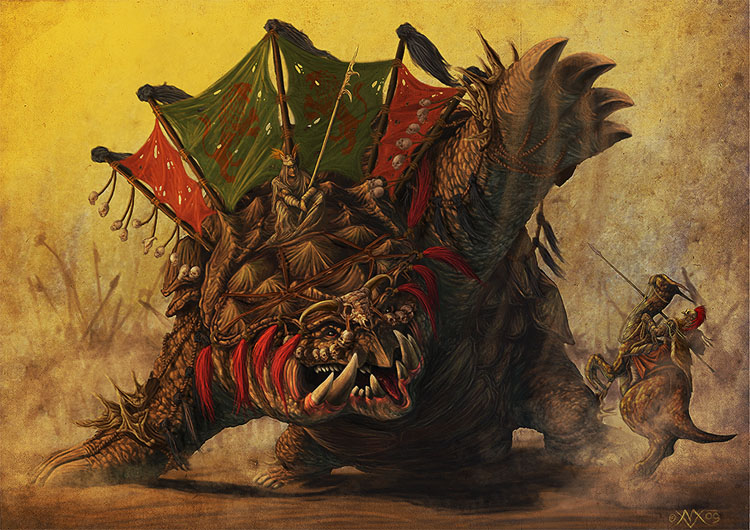
Anakore
The dune freaks, or anakore, are a race of dimwitted humanoids with bony, wedge-like heads, small ears pressed close to the sides of their heads, and sunken, beady eyes covered by clear membranes to prevent sand from scratching these delicate tissues. They ambush prey by burrowing under the sand.
The bright light of Athas’ sun blinds the anakore during the day, but at night they can see as clearly as most beings do during the day. The anakore have an unusual dorsal ridge running along their spine. This fin is actually a sensitive organ which picks up minute vibrations traveling through the sand.
The anakore live within any sandy heap, such as sand dunes or the alluvial fans at the mouths of the canyons. Normally, they travel and hunt in small packs of two to twelve individuals, with the largest, most aggressive acting as leader. They are rarely found outside of sandy areas, but they can walk upright across various kinds of terrain – though they are unusually vulnerable in this state and will avoid fighting at all costs. In addition to their diet of plant roots, the anakores also eat meat – mekillot, inix, erdlu, elf, dwarf, halfling, and nearly anything except kank.
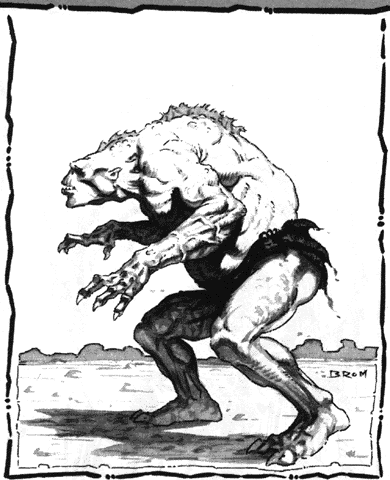
Anakore
Medium humanoid, neutral evil
- Armor Class 11
- Hit Points 17 (3d8+3)
- Speed 25 ft., burrow 15 ft.
STR DEX CON INT WIS CHA 18 (+4) 12 (+1) 12 (+1) 6 (-2) 11 (+0) 6 (-2)
- Skills Stealth +7
- Senses tremorsense 30 ft., Darkvision 30 ft., passive Perception 10
- Languages Anakore
- Challenge 1/2 (100 XP)
Sunlight sensitivity. While in sunlight, the anakore has disadvantage on attack rolls, as well as on Wisdom (Perception) checks that rely on sight.
Actions
Claws. Melee Weapon Attack: +6 to hit, reach 5 ft., one target. Hit: 6 (1d4+4) slashing damage and the target is grappled (escape DC 14). The anakore cannot grapple more than one target. The anakore may make a bite attack as a bonus action against a creature it is grappling.
Bite. Melee Weapon Attack: +6 to hit, reach 5 ft., one target. Hit: 2 (1d4) piercing damage and the target must make a DC 13 Constitution saving throw or be poisoned for 1d4 rounds. If the save is failed by 5 or more, the target is also paralyzed. At the end of each of its turns, the target may make a save to end the poison effect.
Animal, herd
Many beasts are used on Athas for food, clothing, or weapons. Some have been partially domesticated or are stupid enough to allow themselves to be captured and herded. These animals have 1 hit die, 1 hit point, no attacks, and no ability score modifiers.
Kip
The kip is a shy, slow, six-legged, armored creature that digs and eats roots of plants and trees. Their supple, armor-like covering makes excellent durable leather goods. The leathered kip grows from 2’-4’ in length and can release a dulling pheromone against predators that temporarily impairs their desire to eat, drink, and live. Most creatures wander away from the kip when affected.
Kip herds provide a staple of meat and leather goods in most dwarven communities. Roasted, an adult kip will feed two very hungry dwarves; made into a stew, the meat and broth will easily feed six. Kips and dwarves seem to be complementary in pace and temperament. Dwarven communities keep the kip herd in a slow, constant motion since kip tend to destroy roots of growing plants. Their elongated, pointy snouts and keen sense of smell aid them in their search for food. Kips will eat anything that doesn’t put up a fight, including garbage.
Size small, AC15, Mv 15 ft. Pheromones 1/day, DC 8 Constitution saving throw in 10 ft. radius or creature doesn't move or take actions for 1 hour. Any damage or perceived threat of damage immediately ends this effect. CR0
Z'tal
Z’tal are small, easily-panicked, upright lizards that hop in shepherded groups called "leaps" across Athas. Z’tal jump wherever they go on powerful hind legs that end in sharp talons. Their small head is rounded in the back with a sharp, hard point on the end. Their long, thick tail is used for balance when they hop. The vestigial forearms and claws are seldom used. Varying in shades of tans and browns, z’tal are covered by sharp, feather-like scales.
Z’tal constantly make a series of chirps, squeaks, and squawks. These noises are intended predominantly to keep the herd within a single area. When threatened, z’tal scream and run, and their frightened scream can cause vertigo in most creatures long enough for the z'tal to flee.
Z’tal meat is dense and coarse, though the hind quarters (drumsticks) and tail of an adult z’tal make excellent eating (once the scales have been carefully removed). Roasted, the three pieces will feed six hungry individuals or one half-giant. To be compared to a z'tal is an insult as the creatures are known to panic and run off cliffs and into the Sea of Silt.
Size small, AC14, Mv 30 ft. Sonics 1/day for up to 2 rounds, DC 8 Wisdom saving throw in 60 ft. radius or creature has disadvantage on attacks and ability checks while within range of z'tal sonic scream. CR0.
Jankx
These furred mammals live in burrow communities in the desert. Although they represent a possible prime source of food or clothing, most people think they are too dangerous to bother. Standing about 1’ tall on their hind legs, jankx have a small, pointy head and internal cheek pouches that allow them to carry food or water when they run. Jankx have long, sleek bodies and four short, muscular legs. Golden in color, their pelts are highly prized for trade.
Those who consider themselves jankx “herders” are more trappers than anything.A herder hovel is always built either above ground or on solid stone to prevent jankx from burrowing underneath the hovel and killing the herder. Jankx meat is considered gamey but palatable. Due to the difficult position of the poison sacs, caution should be taken in preparing jankx meat. A general rule is one jankx for elves and humans, more for others. Caution must always be exercised when cooking jankx meat. When cooked, the burning flesh emits an odor that sends any nearby jankx into a rage. If cooked too close to a jankx community, a horde of jankx will invariably find the source of the odor and attack the diners.
Jankx poison is known to be used by disreputable gladiators.
Size tiny, AC13, Mv 30 ft. Poison spur +0 hit, melee 0 ft., DC 8 Constitution saving throw or 1d6 poison damage. CR0.
Animal, household
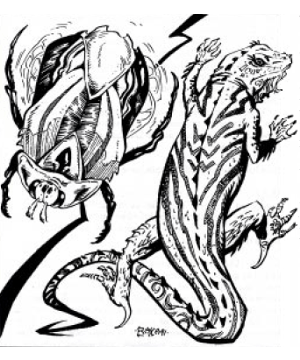
Often small creatures are kept or allowed to live in Athasian households in exchange for some form of comfort or service the creature provides. These pets are considered neither cute nor cuddly as no such creature may be found anywhere on Athas. Stats are not provided as these animals have no combat features. If such are needed, each is a CR 0 tiny beast, unaligned, with 1 hit die, 1 hit point, AC12, and no attacks.
Critic Lizard
Multi-colored, spiny-backed lizards, critics are frequently reluctant house guests in Athas that attune themselves to a single location. They are innately psionic and have the psionic ability to sense danger, sending warning signals to persons who have not mistreated them in the location. Some say these omens of good fortune are the prettiest lizards on Athas. Often mottled in brightly-colored hues, they change color each year when they molt. Critics average 12” to 17” in length and weigh from 2½ to 5 pounds. A critic can detect psionic and magic use within 300 feet of it.
Hurrum
These brightly-colored beetles are highly prized for the pleasant humming sounds they produce. The hurrum have a brightly-colored, opalescent, chitinous shell that varies from cobalt-blue to copper-green. Convex and oval in shape, the shell protects four pair of small, vestigial wings. Hurrum beat their wings rapidly back and forth, gently striking the underside of their carapace which creates the vibration and noise for which these creatures are best known. This humming has a calming effect on humanoids and is used to pacify insects that the hurrum then eats. If exposed to direct sunlight for an hour, it will die, its wings unable to cool itself as its song becomes a more frantic cadence.
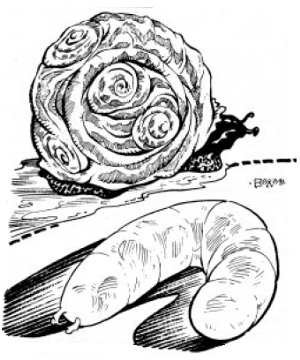
Renk
This small gastropod has developed a symbiotic relationship with humanoid creatures in the desert. A harmless, tasteless slug, it stores water and is sometimes consumed raw on long desert trips. Varied in color, renk have a 3 inch elongated, tapered body. A sucker mouth can be found below a short pair of antennae used to detect vibration. They die if exposed to direct sunlight for more than 10 minutes. Renk are often taken on long trips. Consumed alive, renk contain more water than seems possible. Renk store moisture in an extra stomach that ruptures when they are eaten raw. An average renk holds half a cup of water; therefore, an active man would need to eat 32 raw renks a day to replace fluids needed for one day in the desert. Concern should be taken when purchasing renk. Occasionally a leech or other harmful creature will be added to a group of renk and sold to an unsuspecting buyer.
Ock'n
Ock’n appear as small, spiral-shelled snails. When they move, they leave a slime trail composed of an amber-like liquid that has many household uses, including weapon crafting and the making of jewelry. Nautiloid in shape, this small snail seldom reaches 1” in length. Ock’n shells are almost always light in hue, but vary in color and striping. All ock’n sensory organs are located on the forward protruding head. The head holds a very small pair of light sensors affixed to independent eye stalks. A slit mouth is also located on the head.
Baazrag
In the broken crags and tiny caves of the barrens lives the swarming baazrag. Two feet long and 40 pounds with a 5 foot tail, it is one of the smallest omnivores in the stony barren regions. The baazrag’s face is protected by a bony covering that reaches down on either side of the head and across the nose, with holes for the creature’s nostrils and eyes. The beast’s humped back is covered with a hard, natural armor that protects the animal, especially the fluid storage sack just beneath the shell. Its four legs are comparatively frail but are adequate for darting from shelter to shelter around its rocky home.
Noble families of Tyr and Balic domesticate the baazrag to rid their households of unwanted pests or to pull wagons. Each baazrag can pull as much as 50 pounds of cargo and transport.
Baazrag flesh can be eaten. Each adult has 25 pounds of meat. The fluid sac beneath the shell on its back contains 1d4 pints of water, but it is tainted with its toxin that causes the poisoned condition if consumed, no save, for 1d6 hours. Captured wild baazrags can be sold in various markets as pets or team animals. Undamaged specimens bring 10 cp in the marketplaces around Tyr.
Boneclaw
Once in a very great while, a baazrag litter consists of only one sterile young, much larger than normal. This creature is a boneclaw. The boneclaw stands more than 8 feet tall and weighs 700 pounds. The boneclaw’s head is protected by a bony covering. The upper body and back are covered with a hard shell that deflects all normal missiles smaller than a javelin. Its shell has sharp serrated edges everywhere except around the mouth and eyes. The boneclaw is a dull brown color, with sand-colored claws and red eyes that glow in the dark.
They live only to eat and to kill anything that gets in their way. Boneclaws may be slain and eaten. Each creature has 125 pounds of edible flesh, but it is tough and stringy.
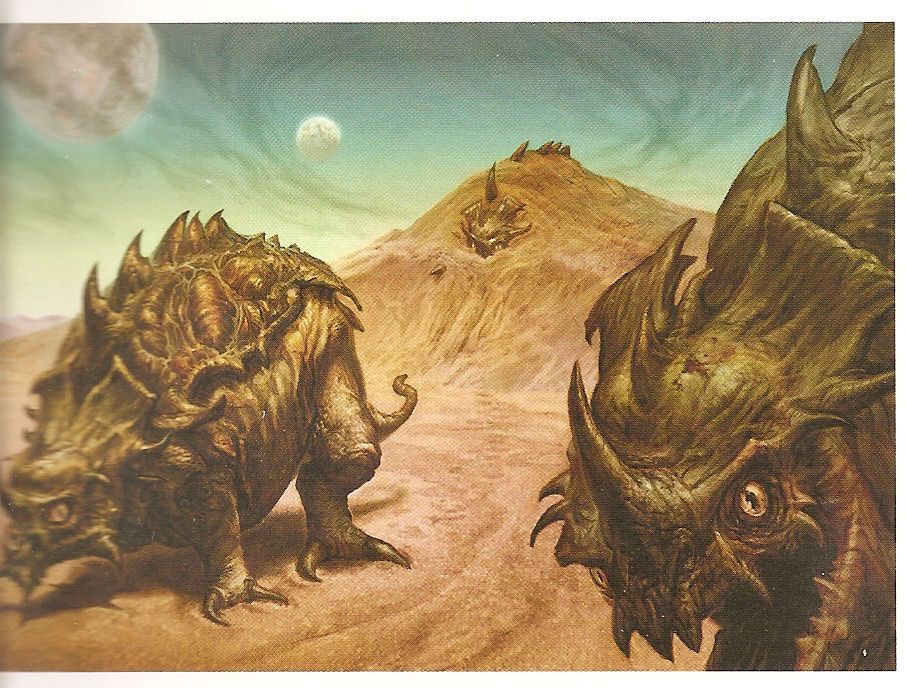
Baazrag
Small beast, unaligned
- Armor Class 15
- Hit Points 5 (1d6+2)
- Speed 40 ft.
STR DEX CON INT WIS CHA 13 (+1) 15 (+2) 15 (+2) 2 (-4) 12 (+1) 6 (-2)
- Senses passive Perception 11
- Challenge 1/8 (25 XP)
Actions
Bite. Melee Weapon Attack: +3 to hit, reach 5 ft., one target. Hit: 3 (1d4+1) piercing damage plus 1 point of poison.
Baazrag, boneclaw
Large beast, unaligned
- Armor Class 15
- Hit Points 51 (6d10+18)
- Speed 50 ft.
STR DEX CON INT WIS CHA 21 (+5) 15 (+2) 17 (+3) 2 (-4) 12 (+1) 10 (+0)
- Senses passive Perception 13
- Challenge 2 (450 XP)
Detect Life. The boneclaw can sense the presence of living creatures within 120 feet of it.
Charge. If the boneclaw moves at least 20 feet straight toward a target and then hits it with a bite attack on the same turn, the target takes an extra 9 (2d8) slashing damage from the boneclaw's shell. If the target is a creature, it must succeed on a DC 15 Strength saving throw or be knocked prone.
Actions
Bite. Melee Weapon Attack: +7 to hit, reach 5 ft., one target. Hit: 11 (1d10+5) piercing damage plus 1d4 points of poison.
Beetle, agony
This harmless looking, black scarab beetle psionically lives off the suffering of its victims, hence its name. The agony beetle has a hard, black-veined, chitinous shell that is marked by dark, transverse lines. The shell protects a pair of wings. Six hooked legs are used by the beetle to attach itself to the skin of humanoid or beast. An elongated snout contains a retractable tendril. The agony beetle uses a pair of stubby antennae to sense vibrations as it does not have eyes.
When the agony beetle locates the victim’s spinal column, a bile-coated tendril emerges from the beetle’s snout (agony beetles do not attack invertebrates). The bile anesthetizes the skin so the victim does not feel the tendril enter. Once inside the skin, the tendril is inserted into the spine. The victim is suddenly racked with excruciating pain, and the beetle begins to psionically absorb and store the energy released by the victim. The beetle will remain attached even after fully sated, basking in the flow of energy until the victim dies.
Agony beetles tend to live near water sources where they hope to encounter prey. A pain-devouring creature, the agony beetle never ingests solid food for sustenance, only an occasional sip of water. They will not hesitate to attack members of their own species, but are often no match for other insects more evolved for combat.
Old stories claim that agony beetles originally escaped from a sorcerer-king’s torture chamber. It is more likely that they were (and are) drawn there for obvious reasons. They are not edible and serve only the darkest needs. Halflings sometimes use the beetles in slings and throw them into trespassers’ clothing; it shortens the hunt without harming the meal.
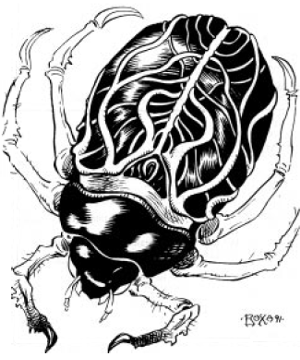
Agony Beetle
Tiny monstrosity, unaligned
- Armor Class 13
- Hit Points 8 (1d4+5)
- Speed 5 ft., fly 15 ft.
STR DEX CON INT WIS CHA 1 (-5) 16 (+3) 20 (+5) 1 (-5) 14 (+2) 6 (-2)
- Skills Stealth +5
- Senses passive Perception 12
- Challenge 1/4 (50 XP)
Psionic Resistance. The agony beetle has advantage on psionic saving throws.
Actions
Tendril. Melee Weapon Attack: +3 to hit, reach Touch, one target. Hit: 1 piercing damage and the agony beetle attaches to the target's spine. The target must make a DC 10 Intelligence saving throw or be unaware it has been damaged. The agony beetle may only attach to one target at a time, loses its Dexterity bonus during this time, and may detach by spending 5 movement, or be detached by an aware target with an Escape DC11, or be detached by another that can reach the targets' back automatically. Anyone attacking an attached agony beetle also deals its damage to the host.
Drain. While attached, the agony beetle reduces the target's Constitution score by 1, causing intense agony. A creature with 0 Constitution dies. This reduction lasts until the target finishes a long rest.
Belgoi
At first sight, a belgoi appears to be human. An observant traveler then notices the longs claws that extend from its fingers, its puckered, toothless mouth, and its webbed, three-toed feet. A belgoi is a member of a race of ignorant demihumans who dwell in the most forlorn wastes. With its taste for the flesh of intelligent races, a gleeful exuberance to inflict pain, no city-state will tolerate a belgoi tribe’s presence within five-day’s travel of their domains.
Belgoi live in huge tribes and operate as raiders. These tribes make their homes in the most forlorn parts of the desert, but they travel across the Tablelands in their unending search for food. Belgoi tribes harass trade routes, villages, and any groups of poorly defended people they can find. Belgoi attack by sneaking up on a caravan camp and selecting a plump, meaty target. The belgoi carry small bells made from the bones of their own dead by the tribe’s shaman These bells have a psionic enchantment that the belgoi (and only the belgoi) can employ.
Though they prefer the flesh of the intelligent races, belgoi will eat animals, plants, and even monsters if they get hungry enough. Belgoi leave the land behind them desolate and barren, stripping it of all animal and vegetable life. They are second only to the foulest defilers in the level of destruction they inflict on the world.
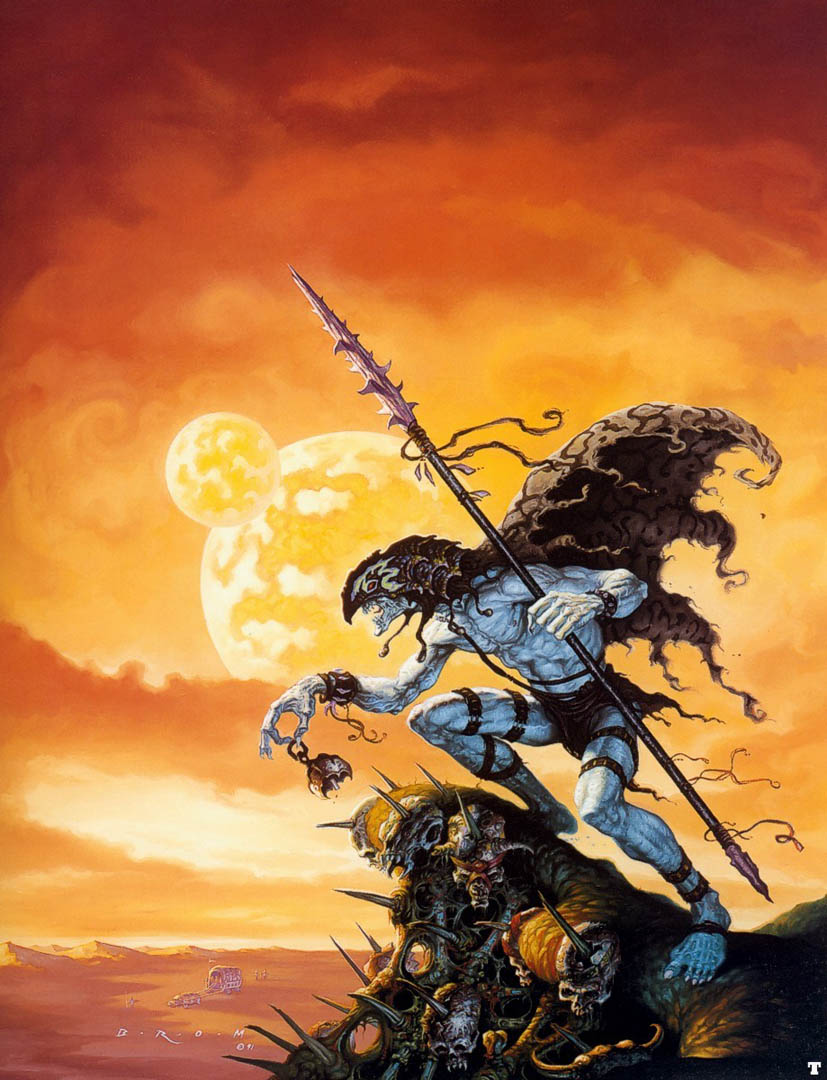
Belgoi
Medium humanoid, lawful evil
- Armor Class 12
- Hit Points 18 (4d8)
- Speed 30 ft.
STR DEX CON INT WIS CHA 13 (+1) 13 (+1) 10 (+0) 7 (-2) 14 (+2) 13 (+1)
- Skills Stealth +5, Survival +6
- Senses passive Perception 12
- Languages Belgoi
- Challenge 1/2 (100 XP)
Actions
Multiattack. The belgoi makes two claw attacks.
Claws. Melee Weapon Attack: +3 to hit, reach 5 ft., one target. Hit: 3 (1d4+1) slashing damage and the target must make a DC10 Constitution save or its Constitution score is reduced by 1d3. The target dies if reduced to 0 Constitution. Otherwise, the reduction lasts until the target finishes a short or long rest. Optionally, the belgoi can choose to deal no slashing damage on a hit and inflict only the Constitution reduction. Those under the effect of a belgoi bell charm do not receive a new save if affected this way.
Bell. The belgoi targets one creature with 120 ft. that it can see and that can hear its bell. The target must make a DC10 Charisma save or be charmed for one hour. On a successful save, the target is immune to that belgoi's bell for 24 hours but does not hear the bell. Any other creature can hear the bell on a save. On a failed save, only the target hears the bell.
Attraction. The belgoi by thought can command a charmed creature to approach it, even if the charmed creature cannot see the belgoi. The target will make all attempts, without harming itself, to reach the belgoi.
Ego Whip (recharge 6). One visible target within 60 ft. must make a DC 10 Intelligence saving throw or take 3d8 psychic damage and be filled with self-doubt, leaving it unable on its next turn to take any action except Dodge, Disengage, or Hide. On a successful saving throw, it takes half as much damage.
Bog Wader
Bog waders live in the bottom of muddy wallows waiting to prey on unsuspecting creatures who come to drink. The small, misshapen creature could be mistaken for a dwarf at a distance. Closer inspection reveals the thousands of wrinkles of overlapping gray skin and thin, yellow and black bones that poke through the soft skin on all sides. A pair of dorsal ridges run down the back and the wader has specialized cilia to filter out mud and breathe underwater. They have a saliva that seals water above their mud holes, hiding them from unsuspecting prey. They attempt to drag prey into the mud to suffocate.
Bog waders communicate with each other through a series of guttural tones, but these convey only the simplest concepts concerning feeding and mating. The skin of the creature needs almost constant moisture and will dry and crack quickly when exposed to direct sunlight. During particularly dry spells, the bog wader can burrow to the bottom of its drying hole and become dormant for up to 20 years. Once the bog becomes muddied again, the creature slowly regains its consciousness and mobility over a week's time.
Thri-kreen have been known to use dormant bog waders as weapons. They dig up bog waders before they can awaken and sneak them into enemy ponds and watering holes. Within a week the thri-kreen can expect multiple casualties among their unsuspecting enemies.
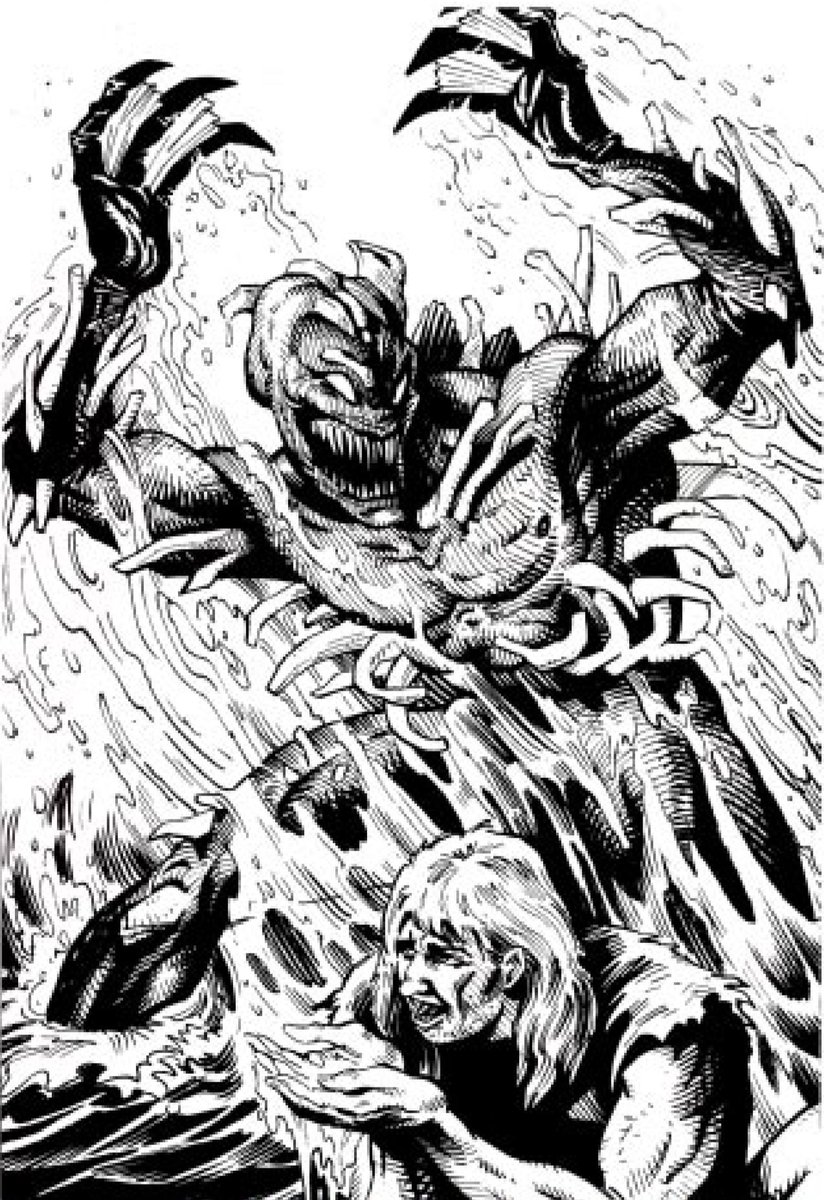
Bog wader
Medium monstrosity, chaotic evil
- Armor Class 15
- Hit Points 30 (4d8+12)
- Speed 10 ft., burrow 5 ft., swim 30 ft.
STR DEX CON INT WIS CHA 14 (+2) 12 (+1) 16 (+3) 6 (-2) 12 (+1) 6 (-2)
- Skills Stealth +3
- Senses passive Perception 11
- Challenge 1 (200 XP)
Mud Sense. A bog wader can detect creatures in contact with mud within 30 feet of it.
Ambush. A bog wader submerged in mud has a +10 bonus to Stealth. It has advantage on attacks against creatures that have not taken a turn in the combat yet.
Actions
Multiattack. The bog wader makes two attacks: a claw and a bite.
Claws. Melee Weapon Attack: +4 to hit, reach 5 ft., one target. Hit: 4 (1d4+2) slashing damage.
Bite. Melee Weapon Attack: +4 to hit, reach 5 ft., one target. Hit: 6 (1d6+2) piercing damage.
Bone Grapple. Melee Weapon Attack: +4 to hit, reach 5 ft., one target. Hit: 7 (2d4+2) piercing damage plus the target is grappled (escape DC 12). The bog wader can only grapple one target at a time.
Braxat
A braxat is a huge, 15 foot tall, imposing creature that appears to be a cross between mammalian and reptilian stock. Thick, articulated shells cover its back and shoulders, and its square, lizardlike head is defended by a crown of three to five horny protrusions. A braxat is warm-blooded and walks upright like most humanoids, though its great size allows it to tower over even the tallest half-giant. Highly intelligent and completely evil, a braxat terrorizes the wilderness it occupies.
Hunters by nature, a braxat’s tactic reflect its cunning, intelligence, and evil tendencies. It enjoys the hunt, stalking its prey and inspiring as much fear as possible before moving in for the kill. The kill isn’t accomplished by a quick, merciful stroke. The braxat enjoys inflicting pain – it likes to play with its prey before delivering the killing blow.
Terrible and greatly feared, braxats usually hunt and attack by night. They use the pale light of Athas’s twin moons to search for prey. Braxats will eat anything if they’re hungry enough, including caravan mounts (although not even a starving braxat will eat a kank), but they prefer to stalk intelligent beings for the thrill over the taste. Braxats are aware of the value of their shells in making armor and are intelligent enough to set ambushes and lure would-be hunters to their deaths.
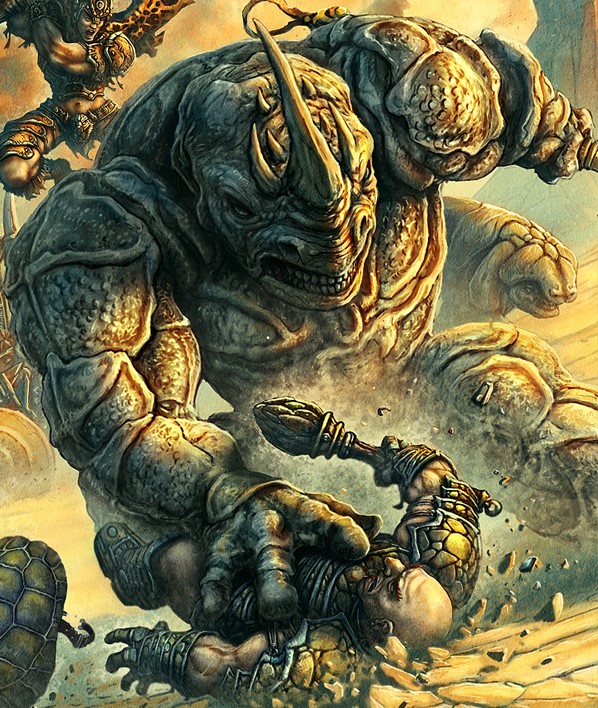
Braxat
Huge monstrosity, neutral evil
- Armor Class 19
- Hit Points 105 (10d12+40)
- Speed 40 ft.
STR DEX CON INT WIS CHA 24 (+7) 11 (+0) 18 (+4) 14 (+2) 14 (+2) 10 (+0)
- Damage resistances bludgeoning, piercing, and slashing from nonmagical or nonmetal weapons
- Saving Throws Con +7, Wis +5
- Skills Survival +5
- Senses passive Perception 12
- Languages Braxat, Common
- Challenge 9 (5,000 XP)
Psionic Resistance. The braxat has advantage on psionic saving throws.
Actions
Multiattack. The braxat makes two weapon attacks.
Spiked Club. Melee Weapon Attack: +10 to hit, reach 10 ft., one target. Hit: 15 (2d6+7) bludgeoning or piercing damage (braxat chooses).
Psionic Blast (1/day). The braxat targets one creature it can see within 60 feet. That target takes 4d8 psychic damage.
Acid Breath (recharge 5-6). The braxat exhales acid in a 15 ft. cone. Each affected creature must make a DC 17 Dexterity saving throw, taking 22 (4d10) acid damage on a failed save, or half as much on a successful one.
Psychoportation (recharge 6). The braxat psionically alters its location, choosing to either teleport up to 120 feet to a location it can see or blink for 1 minute.
Awe (recharge 6). The braxat can cause each creature of its choice within 120 feet of it and visible to the braxat to make a DC 13 Wisdom saving throw or become frightened for 1 minute. A creature can repeat the saving throw at the end of its turns to end the effect.
B'rohg
These multi-armed, kin to giants are often hunted for combat in the gladiatorial arenas of Athas due to their strength, size, and four arms. B’rohg are 15 feet tall with burnt orange skin, sharp, angled features, a flat nose, and pointed ears located towards the backside of their skull. Some b’rohg are bald on top, but do have hair (which they will grow to waist-length) growing from the back of their heads. B’rohg have no facial hair. A b’rohg’s garb is simple and well-suited to his primitive lifestyle.
B’rohg communicate with one another through a series of primitive grunts and hand signals. They are nomadic hunters and gatherers who continue to live within a primitive, “stone age” culture. Neither suspicious nor superstitious, b’rohg are reactionary when magic is used in their presence and may be awed or angered based on past experiences.
B’rohg do not directly contribute to the social or economic well-being of Athas. They are, however, top draws at gladiatorial arenas, although they seldom benefit from their victories and are often seduced with luxuries to fight.
Renegade b’rohg are those who have lived the "civilized" arena life and returned or escaped to the wild. They tend to live solitary lives. In encounters with other, more primitive b’rohg, the renegade keeps his distance, ashamed of his original capture, but also ashamed by the simplistic lives of his kin. The only places where renegades find universal acceptance is among the slave tribes. Once again among the familiar trappings of gladiatorial companionship, but without the abuse of servitude, renegades make excellent warriors and laborers.
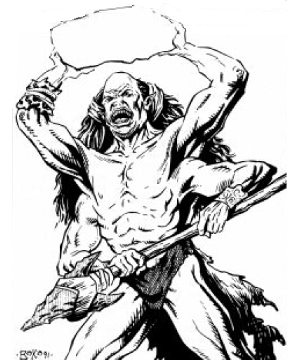
B'rohg
Huge giant, neutral
- Armor Class 12 (leather)
- Hit Points 57 (6d12+18)
- Speed 40 ft.
STR DEX CON INT WIS CHA 22 (+6) 10 (+0) 17 (+3) 6 (-2) 10 (+0) 8 (-1)
- Senses passive Perception 10
- Challenge 4 (1,100 XP)
Actions
Multiattack. The b'rohg makes four attacks: two with clubs and two with spears, or with hurled rocks that count as two attacks.
Club. Melee Weapon Attack: +8 to hit, reach 5 ft., one target. Hit: 13 (2d6+6) bludgeoning damage.
Spear. Melee Weapon Attack: +8 to hit, reach 10 ft., one target. Hit: 13 (2d6+6) piercing damage.
Rock. Ranged Weapon Attack: +8 to hit, range 60/240 ft., one target. Hit: 21 (3d10+6) bludgeoning damage.
B'rohg Leader
B'rohg are patriarchal and groups of six or more are typically led by a smarter specimen who will utilize tactics. The leader has Intelligence 10 and 75 hit points.
Cactus, hunting
Hunting cacti are not part of the food chain as they are not native to Athas, and no one knows from where these sentient hunters came. Hunting cacti are a pale green color. They stand 3 feet high and have a number of oval shaped pods attached to the main trunk. They have no sensory organs, so they rely on their psionic abilities to detect prey as they disguise themselves among normal cacti.
Hunting cacti prefer meat, but can survive on plants indefinitely. Although the cacti regard this as a form of cannibalism, they prefer consuming plants to starvation. Hunting cacti possess an alien intelligence and, although communication through psionics is possible, the cacti do not understand that animals are sentient beings. The cacti regard any communication as coming from a plant, refusing to accept that a “meat-creature” could have any more intelligence than is required to eat, move, and reproduce.
Hunting cacti are occasionally attacked by the thirsty travelers who expect to find water but have no natural hunters. The spines of hunting cacti can be used as blowgun darts, with or without the nerve poison.
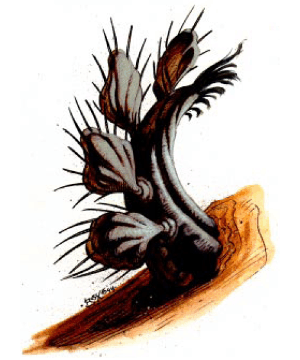
Hunting Cactus
Small plant, unaligned
- Armor Class 13 (natural)
- Hit Points 27 (6d6+6)
- Speed 20 ft.
STR DEX CON INT WIS CHA 7 (-2) 14 (+2) 13 (+1) 15 (+2) 11 (+0) 7 (-2)
- Senses life and psionic detection only
- Challenge 1 (200 XP)
Detect Life and Psionics. A hunting cactus can sense the presence of living creatures and psionic use within 120 feet of it and their specific location.
False Appearance. A hunting cactus is indistinguishable from a normal cactus while it remains motionless.
Actions
Multiattack. The hunting cactus makes 3 spine attacks or 1 drain.
Poison Spine. Ranged Weapon Attack: +4 to hit, range 15/30 ft., one target. Hit: 4 (1d4+2) piercing damage and the target must succeed on a DC 12 Constitution saving throw or be poisoned for 1 minute. If failed by 5 or more, the target is also paralyzed and may attempt a saving throw at the end of its turn to end the paralysis.
Blood Drain. Melee Weapon Attack: +4 to hit, reach 5 ft., one target. Hit: 0 damage and the cactus inserts a feeding spine. On its turns, the target loses 4 (1d6) hit points due to blood loss. The cactus can detach itself by spending 5 feet of movement, and it does so after draining 30 hit points, if attacked, or if the target dies. A creature can detach a spine with an action.
Aversion (1/day). A target the cactus can sense within 120 feet must succeed on a DC 12 Wisdom saving throw or be unable to approach with 60 feet of the cactus for 1 minute. If already closer, the target must use all its actions and movement to move outside the range.
Cactus, sand
Sand Cacti are a vile form of plant life that dwell anywhere there is sand. It feeds on the blood of its victims. Sand cacti are well protected; the entire plant (except the needles) is hidden below the sand. The body is from 5-8 feet across and about 4 feet thick. It has many barbed needles attached to it with long, thin, fibrous strands. The bulbous body of the plant and the strands are sickly white, while the needles very closely resemble the color of the sand in the area.
A sand cactus attacks very passively. Its needles lie thrust up an inch out of the sand and snag the victims on barbs. If caught, the sand cactus directs other barbs to snag the creature, and very quickly it can bring down even the largest predators. The sand cactus is a trapper, existing on any food that comes along. It is unable to digest kank blood; a cactus releases a snagged kank after one round of blood draining. Anything else is fair game. The sand cactus is hard to destroy because its body lies 5-10 feet below the surface, but once exposed, it is easy to kill.
Sand cacti do not reproduce. Rather, a creature that survives its attack may still die from its festering disease, and from the corpse sprouts a new sand cactus.
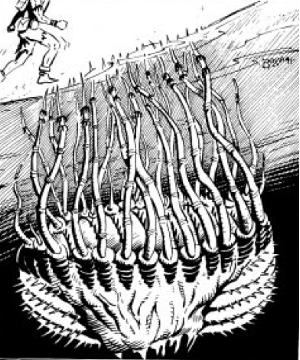
Sand Cactus
Large plant, unaligned
- Armor Class 8 (body), 16 (barbs)
- Hit Points 33 (5d10+5), 2 (barbs)
- Speed burrow 5 ft. per hour
STR DEX CON INT WIS CHA 16 (+3) 7 (-2) 13 (+1) 1 (-5) 11 (+0) 7 (-2)
- Condition immunities frightened, poisoned
- Senses tremorsense 15 ft.
- Challenge 3 (700 XP)
Needles. A sand cactus spreads out its needle barbs on the surface in 15 foot radius. Any creature walking on the surface of the radius is subject to a barb attack.
False Appearance. A sand cactus's barbs are indistinguishable from normal desert terrain.
Submerged. While under the earth, the sand cactus's body cannot be directly targeted and has total cover. With proper tools, a creature can make 1 foot of progress per hour towards the cactus, which lies 1d6+4 feet below the surface.
Actions
Multiattack. The sand cactus has no inherent limit to the number of barb attacks it can make. It makes one barb attack against any target on its surface. Each time it grapples a target with a barb, it may make one additional barb attack each round against that target as it senses its prey, limit 6 total. A target needs only 1 success to escape all barb grapples.
Barb. Melee Weapon Attack: +5 to hit, reach special, one target. Hit: 2 (1d4) piercing damage and the target is grappled (pierced) by the barb (escape DC 13). While grappled, the cactus drains blood through the barb. At the start of the cactus's turns, the target loses 5 (1d4+3) hit points due to blood drain and must succeed on a DC 13 Constitution saving throw or contract a blood poisoning disease. It takes 1d4 days for symptoms to manifest in the form of fever and pains. A creature gains one level of exhaustion and regains only half the Hit Dice from a short rest and no health from a long rest. At the end of each long rest, an infected creature must make another DC 13 Constitution saving throw or gain another level of exhaustion. A success reduces the exhaustion by one level. If exhaustion is reduced below 1 by this saving throw, the disease ends. A barb has 2 hit points, AC 14, and is immune to bludgeoning damage.
Cha'thrang
At first glance a cha’thrang appears to be a patch of broken bamboo – until it moves. The cha’thrang is a tortoise-shaped creature with a multitude of short, reed-like appendages protruding from its shell. Dirty brown in color, the cha’thrang is frequently mistaken for a patch of dead plant growth. It has four strong limbs and curved foreclaws for digging and hugging the ground. The protrusions on the cha’thrang’s shell are actually hollow, bone-like appendages. The creature secretes an alkaline lime from its back that creates its shell, which grows in size with the creature. A thin, sinewy fiber is also produced that enables the creature to adhere to the underside of the shell.
The cha’thrang will lie motionless for several hours until a low-flying creature passes overhead. While waiting, the cha’thrang forces an air pocket between its body and its shell. When an appropriate target flies nearby, it expels that air up through the hollow, bone protrusions with a tremendous blast and “fires” tethered, lime-coated projectiles at the flying creature. In hard times, they have been known to turn to land-based prey.
The sinewy cord the cha’thrang uses to tether its prey is highly sought after to make rope. A single, dry strand will easily hold 50 pounds of weight. By braiding several cords, a thin but very strong rope can be crafted. Cha’thrang can be eaten if special care is taken in the preparation of the creature’s flesh. If lime from the shell undercoating is used to cover the meat, that meat can be preserved for weeks without fear of spoilage. However, great care must be exercised in washing and cleaning the meat before eating it to insure that all of the toxic lime has been removed.
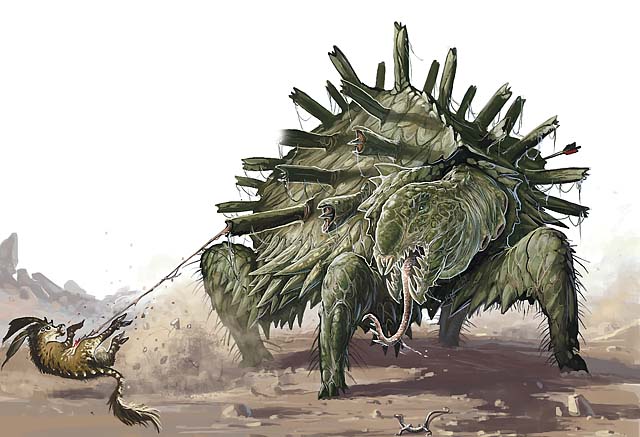
Cha'thrang
Medium beast, unaligned
- Armor Class 18
- Hit Points 59 (9d8+18)
- Speed 20 ft.
STR DEX CON INT WIS CHA 15 (+2) 12 (+1) 14 (+2) 2 (-4) 12 (+1) 6 (-2)
- Senses passive Perception 13
- Challenge 2 (450 XP)
Withdrawal. As a reaction, the cha'thrang can draw itself into its shell, gaining +5 to its armor class and losing the ability to make claw or bite attacks until the end of its next turn.
Actions
Multiattack. The cha'thrang makes a claw and bite attack.
Claw. Melee Weapon Attack: +4 to hit, reach 5 ft., one target. Hit: 4 (1d4+2) slashing damage.
Bite. Melee Weapon Attack: +4 to hit, reach 5 ft., one target. Hit: 9 (1d12+2) piercing damage.
Spine Volley (recharge 4-6). Ranged Weapon Attack: +4 to hit, range 50/150 ft., one target. Hit: 6 (1d6+2) piercing damage plus the target must succeed on a DC 12 Constitution saving throw, taking 10 (3d6) poison damage on a failed save, or half as much on a successful save. The target is also grappled (escape DC 12) by a tethered cord (AC 10, 10 hit points, immune bludgeoning). On its turn, the cha'thrang can pull a grappled target 5 foot towards it if it makes an opposed Strength check without using an action.
Cilops
Cilops are relentless hunters who are prized by the templars of all the city-states for their unique tracking abilities. The creatures look like enormous centipedes that reach lengths exceeding 15’, weighing 500 to 700 pounds. Their segmented bodies are long and flat and form a hard exoskeleton. Their hooked legs allow them to crawl onto virtually any surface and to scale walls with ease. Their oval heads have a large single compound eye and three pairs of pincerlike jaws. Two prehensile antennae grow from either side of the jaws and reach lengths of 3’ to 5’. Cilops have a protective coloration that reflects their native terrain. The cilops of the salt flats often display a chalky blue-white to steel gray color while the cilops of the rocky badlands vary from rust orange to dark brown.
Cilops require no sleep and will relentlessly track prey for weeks. Cilops have not been successfully bred in captivity and must be captured. Templars from the city-states usually try to find cilops in the salt flats, where it is easier to spot them. Cilops have even been used to track others of their kind.
Native to the salt flats of Athas, the cilops have developed their extraordinary tracking abilities in order to find food in the barren wastes. Their poor depth of vision makes them rely upon their innate detection ability to warn them of predators. Cilops will feed on just about any moving creature – they prefer live prey. A cilops requires one dwarf-sized meal per week.
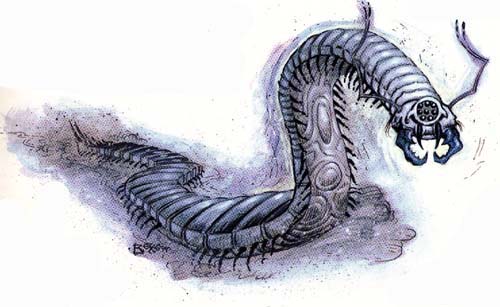
Cilops
Large beast, unaligned
- Armor Class 16
- Hit Points 57 (6d10+24)
- Speed 40 ft., climb 30 ft.
STR DEX CON INT WIS CHA 22 (+6) 17 (+3) 19 (+4) 2 (-4) 14 (+2) 6 (-2)
- Skills Survival +5 (+15 to track)
- Senses passive Perception 12
- Challenge 3 (700 XP)
Detect Life. The cilops can sense the presence of living creatures within 120 feet of it plus their general direction.
Detect Psionic Residue. The cilops can read psionic residue on any object belonging to any creature from the last 24 hours and use it to determine the creature's general direction.
Actions
Multiattack. The cilops makes an antennae and mandible bite attack.
Antennae. Melee Weapon Attack: +8 to hit, reach 5 ft., one target. Hit: Stun. Target must make a DC 14 Charisma save or be stunned until the end of its next turn.
Bite. Melee Weapon Attack: +8 to hit, reach 5 ft., one target. Hit: 13 (2d6+6) piercing damage.
Cistern fiend
This terrible creature is believed to have been conjured from the twisted mind of some long-dead sage. Frequently, unsuspecting victims of the cistern fiend think they have found a safe or unguarded water supply; this is usually their last conscious thought.
The cistern fiend appears as a giant, vaguely green but translucent worm with a great mass of coiling pinkish tentacles surrounding a hideous mouth. The cistern fiend is virtually invisible when totally submersed in water. The creature’s size depends on its age and the amount of water available, but most cistern fiends average 40’ to 50’ in length.
The cistern fiend, or water worm, feeds in two different ways. It lives day-by-day filtering impurities from the water supply in which it dwells. For this reason alone cistern fiends are beneficial to any community’s water supply. The fiend also feeds on the body fluids of creatures. To it, all creatures are intruders and potential sources to add fluid to the existing water supply. A cistern fiend must stay immersed in water or it will die in 1d4 minutes. For this reason it is very protective of its water supply.
The cistern fiend was possibly bred by some long-dead and forgotten king. The creature was originally created for the sole purpose of guarding and purifying caches of water. These creatures are sometime stolen (most likely as newborn offspring) and can be encountered in any large water source. If two adult creatures are introduced into the same water supply, the stronger one will slay the weaker.
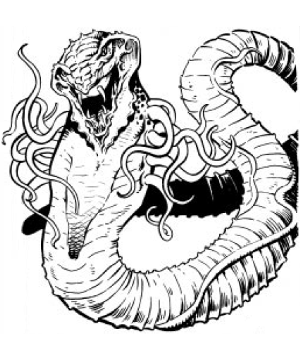
Cistern fiend
Gargantuan aberration, neutral
- Armor Class 19
- Hit Points 202 (13d20+65)
- Speed 30 ft., swim 30 ft.
STR DEX CON INT WIS CHA 30 (+10) 16 (+3) 20 (+5) 2 (-4) 16 (+3) 14 (+2)
- Saving Throws Con +9, Wis +7
- Damage Resistances psychic
- Damage Immunities poison
- Skills Perception +7, Stealth +7
- Senses passive perception 17
- Challenge 15 (13,000 XP)
Detect Life. The cistern fiend can sense the presence of living creatures within 120 feet of it.
Psionic Resistance. The cistern fiend has advantage on psionic saving throws.
Invisible in Water. The cistern fiend is invisible while fully immersed in water.
Actions
Bite. Melee Weapon Attack: +14 to hit, reach 20 ft., one target. Hit: 30 (4d8+10) piercing damage plus the target is grappled (escape DC 22). This attack does half damage on creatures without bodily fluids, such as constructs and undead. Until the grapple ends, the cistern fiend cannot grapple or bite another target.
Poison Tentacles. As a bonus action, the cistern fiend may attack a grappled target with its poisoned tentacles at +14 to hit. If hit, the target takes no damage and must succeed on a DC 22 Constitution saving throw or be paralyzed for one minute. If the saving throw fails by 5 or more, the target's hit points are reduced to 0. A paralyzed target can repeat the saving throw at the end of its turns to end the effect.
Psionic Blast (3/day). The cistern fiend targets one creature it can see within 60 feet. That target takes 4d8 psychic damage.
Ego Whip. One visible target within 60 ft. must make a DC 15 Intelligence saving throw or take 3d8 psychic damage and be filled with self-doubt, leaving it unable on its next turn to take any action except Dodge, Disengage, or Hide. On a successful saving throw, it takes half as much damage.
Cloud Ray
Through the skies and clouds of Athas slowly fly these deadly giants. Cloud rays have a broad, flattened body and flap their huge pectoral fins to aid their psionic flight powers. They are speckled-brown on top and drab olive and white underneath. Sets of ridges protect the creatures’ eyes. They have four jetblack eyes, two mounted on each side of the snout and the other two on each side of the cranial bulge. Down the back from the bulge runs a spine that becomes a long, thin, whip-like tail that ends in an appendage known as a zip. The zip is comprised of razor-sharp, barbed ridges that grow at the tip of the spine. The interior mouth or maw (20+ feet across) is lined with row upon row of razor-sharp cartilage ridges. The zip is also used in a complex signaling system that is only understood by other cloud rays.
Cloud rays wander aimlessly through the Athasian skies always searching for their next meal. On rare occasions they land on the ground and may be mistaken for an outcropping of rock. Those hapless enough to be standing on a ray when it decides to become airborne may become its next meal. A cloud ray’s preferred diet consists of devouring other flying creatures. They have a special fondness for rocs, pterrax, and flying humanoids. The ray has no true stomach, preferring to swallow prey whole and grind the victim to liquid on its interior jaw ridges to help aid with digestion. After a good meal, cloud rays will sometimes psionically dream travel while their meal digests. Cloud rays have territorial respect for others of their species and, with very few exceptions, do not intrude into another ray’s “air space”.
Although innately psionic, cloud rays become infuriated when a psionicist contacts them. It drives them into a tremendous rage, and they will do anything they can (except land) to capture and devour the offending psionicist. The Dragon is the only creature in the world that cloud rays truly fear.
A single cloud ray could easily provide an entire settlement with enough meat and raw materials for 2-3 months. The chances of this occurring are slim at best. These creatures are fierce and feared for good reasons. Entire villages have been reported decimated by a single cloud ray on the hunt. The effect of the creature hovering close over buildings and flapping its massive wings has the same effect as the most deadly sandstorm. The zip alone can easily destroy most buildings in a few swipes.
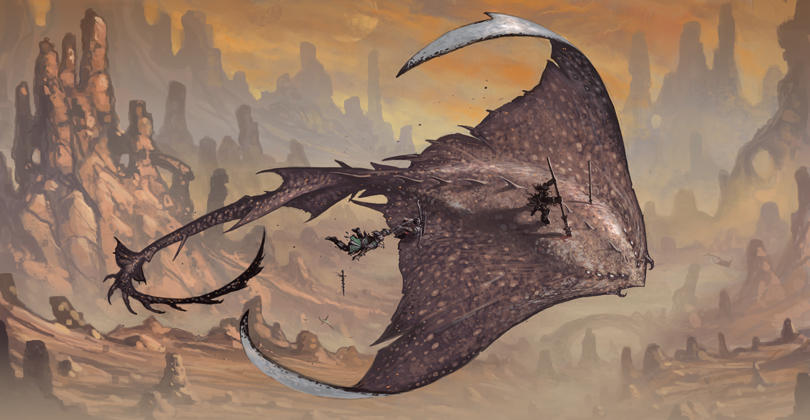
Cloud Ray
Gargantuan beast, unaligned
- Armor Class 14 (natural)
- Hit Points 215 (13d20+78)
- Speed fly 60 ft. (psionic hover)
STR DEX CON INT WIS CHA 30 (+10) 13 (+1) 22 (+6) 2 (-4) 11 (+0) 8 (-1)
- Saving Throws Con +10, Int +0, Wis +4
- Senses darkvision 60 ft., passive perception 10
- Challenge 18 (20,000 XP)
Actions
Multiattack. The cloud ray makes a bite and tail attack.
Bite. Melee Weapon Attack: +14 to hit, reach 20 ft., one target. Hit: 49 (6d12+10) piercing damage. If the target is a Huge or smaller creature, it must succeed on a DC 22 Dexterity saving throw or be swallowed. A swallowed creature is Blinded and Restrained, has total cover against outside effects, and it takes 22 (4d10) bludgeoning damage at the start of each of the cloud ray's turns. If the cloud ray takes 30 damage or more on a single turn from a creature inside it, it must succeed on a DC 21 Constitution saving throw at the end of that turn or regurgitate all swallowed creatures, which fall prone in a space within 10 feet of the cloud ray. If the cloud ray dies, a swallowed creature is no longer Restrained by it and can escape from the corpse by using 20 feet of Movement, exiting prone.
Tail. Melee Weapon Attack: +14 to hit, reach 40 ft., one target. Hit: 37 (5d10+10) bludgeoning damage.
Telekinesis (3/day). The cloud ray manifests a psionic effect identical to the telekinesis spell with a DC 18 saving throw.
Control Winds. The cloud ray affects a 100 ft. cube of air within 300 ft. range, lasting up to 1 hour. Ranged attacks that pass through the cube have disadvantage, movement costs 1 extra foot for each foot moved, and flying creatures that enter or start their turn in the cube, other than the cloud ray, are subject to drafts that knock them prone unless they succeed on a DC 18 Strength saving throw. The cloud ray may end this effect without spending an action.
Reactions
Inertial Barrier. When taking acid, cold, fire, lightning, or thunder damage, it can use its reaction to gain resistance to damage of that type — including the triggering damage — until the end of its next turn.
Crodlu
Crodlu are large reptiles, distant relatives of erdlu, that roam the deserts and scrub land in herds. Crodlu resemble large ostriches, but their forearms end in wicked claws and their tough, scaly hides are yellow to red, with other colors along their sides and belly. They have poor eyesight and an excellent sense of smell. They can run at high speed for long periods of time. They stand around 6 feet tall and weigh 500 pounds. They are commonly raised as mounts, able to eat anything and travel long distances.
Heavy crodlu are specially-bred for war, with strong scales for protection of their upper body and head. They have sharp claws on their forearms that may be filed to a point or may be augmented with glass or metal blades. They stand around 7 feet tall and weigh 700 pounds.
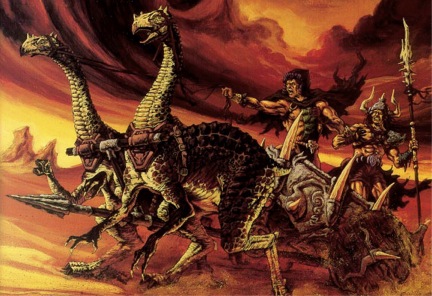
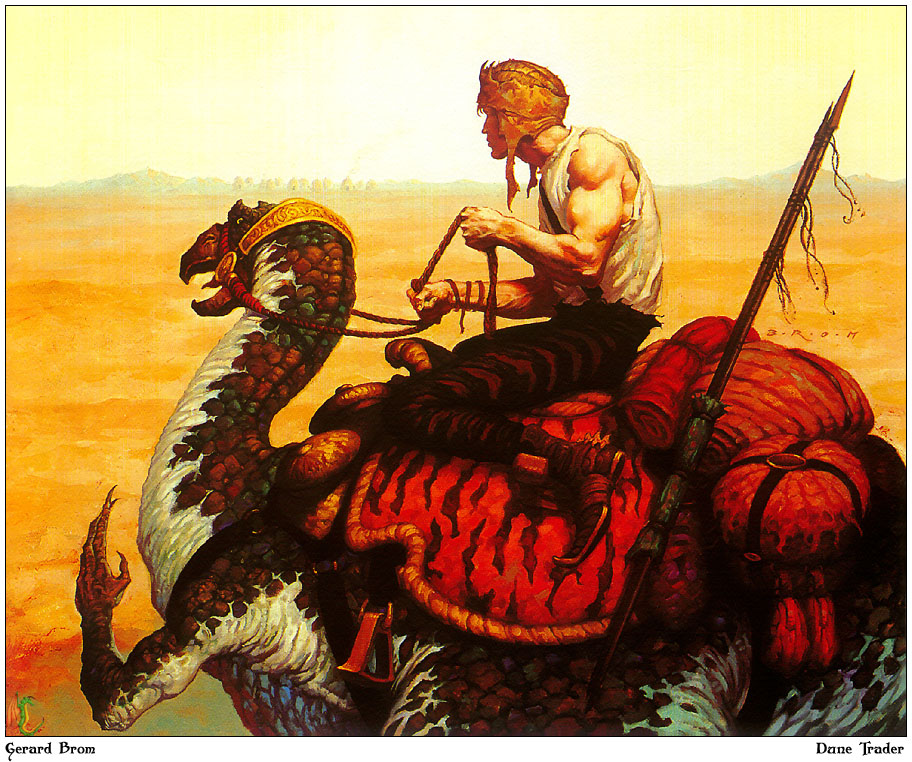
Crodlu
Large beast, unaligned
- Armor Class 14
- Hit Points 38 (4d10+16)
- Speed 50 ft.
STR DEX CON INT WIS CHA 19 (+4) 15 (+2) 19 (+4) 2 (-4) 12 (+1) 10 (+0)
- Senses Passive perception 11
- Challenge 1 (200 XP)
Actions
Multiattack. The crodlu makes a claw and bite attack.
Claws. Melee Weapon Attack: +4 to hit, reach 5 ft., one target. Hit: 8 (1d6+4) slashing damage.
Bite. Melee Weapon Attack: +4 to hit, reach 5 ft., one target. Hit: 9 (1d8+4) piercing damage.
Crodlu, heavy
Large beast, unaligned
- Armor Class 17
- Hit Points 63 (6d10+30)
- Speed 40 ft.
STR DEX CON INT WIS CHA 20 (+5) 13 (+1) 20 (+5) 2 (-4) 12 (+1) 10 (+0)
- Senses Passive perception 11
- Challenge 3 (700 XP)
Charge. If the heavy crodlu moves at least 20 ft. straight toward a creature and then hits it with a claw attack on the same turn, that target must succeed on a DC 15 Strength saving throw or be knocked prone.
Actions
Multiattack. The crodlu makes a claw and bite attack.
Claws. Melee Weapon Attack: +7 to hit, reach 5 ft., one target. Hit: 9 (1d6+5) slashing damage.
Bite. Melee Weapon Attack: +7 to hit, reach 5 ft., one target. Hit: 10 (1d8+5) piercing damage.
Dagorran
A dagorran is a froglike beast, about 5 ft. long, with golden-hued skin, green eyes, and a green crystalline growth between its shoulders. It has large razorsharp teeth that it uses in hunting and eating its prey. Its large, muscular legs are used for jumping, running, and walking. The dominant dagorran or leader has a larger crystalline growth.
While packs of dagorrans can be encountered at any time, they prefer to sleep during the hot daylight hours and hunt during the cooler evening and night hours. If the pack has recently fed, they bury themselves in the sand during the day with just their bulging eyes and nostrils emerging from the earth. They generally sleep throughout the day unless an unknowing creature intrudes upon them. If an intruder approaches, the leader signals an attack using its psionic communication ability.
Dagorrans were once common on Athas, but their value as components for potions and spells, their leatherlike hide, and that thri-kreen consider dagorran flesh a delicacy, have caused them to reach near extinction. They are still common in the deserts near Draj and are often used as trackers by Drajian guards because of their sensitivity to psionics. They are also sought by nobles and the patriarchs and matriarchs of the merchant houses to help keep their gardens free of rodents and other small animals.
Dagorrans have an ancient hatred of thri-kreen and will attack them to the exclusion of all others.
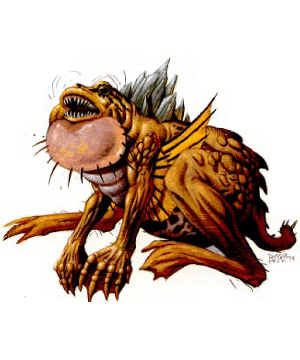
Dagorran
Medium beast, unaligned
- Armor Class 12
- Hit Points 26 (4d8+8)
- Speed 25 ft.
STR DEX CON INT WIS CHA 14 (+2) 15 (+2) 14 (+2) 2 (-4) 12 (+1) 6 (-2)
- Skills Stealth +4, Survival +3
- Senses passive Perception 11
- Challenge 1 (200 XP)
Leap. If the dagorran can move at least 20 ft. straight toward a creature, it can jump that distance (over obstacles if needed) and gain advantage on a bite attack against that creature on its turn.
Pack Tactics. The dagorran has advantage on an attack roll against a creature if at least one of its allies is within 5 feet of the creature and the ally isn't incapacitated.
Track psionics. The dagorran gains +10 to Survival checks to Track (DMG 244) a creature if the creature has psionic ability, including wild talents.
Actions
Bite. Melee Weapon Attack: +4 to hit, reach 5 ft., one target. Hit: 9 (1d12+2) piercing damage.
Psionics (1/day). A dagorran can use its innate psionic ability to manifest a shatter spell, DC 12 saving throw.
Dagorran Pack Leader (CR 1, 200 XP)
The pack leader is distinguished by a larger crystalline growth and takes its place by killing a challenger. They have 40 hit points and the additional 1/day psionic ability to manifest dominate person, DC 12 saving throw, lasts only until the end of the target's turn.
Dune Reaper
The dune reaper prowls the sandy wastes in wild packs, eating anything it finds after ripping it apart with scythelike limbs. Perhaps the most disquieting features of the dune reaper are the eerie red luminescence of its eyes and the sickly sweet smell of decay that surrounds it. The reaper emits a howling wail that can frequently be heard across the barren deserts of Athas. At 6 feet tall and 3,000 pounds, the size, ferocity, and eerie appearance of the dune reaper makes it a highly valued combatant in many Athasian arenas, especially since they tend to go berserk when separated from the hive. One event favored by sorcerer kings is to loose one reaper above two combatants just as a killing blow is about to be delivered.
Dune reapers are matriarchal, hive creatures, that create male drones to create hives using their saliva to bind sand and gravel. They have a complex form of communication involving sound, motion, and scents used to communicate when prey has been located. In times of need, they will eat the drones.
Dune Reaper, drone
Large beast, unaligned
- Armor Class 14 (natural armor)
- Hit Points 68 (8d10+24)
- Speed 40 ft.
STR DEX CON INT WIS CHA 20 (+5) 14 (+2) 16 (+3) 3(-4) 13 (+1) 8 (-1)
- Skills Athletics +10
- Senses Darkvision 60 ft., passive Perception 13
- Languages ---
- Challenge 3 (700 XP)
Actions
Multiattack. The dune reaper drone makes three attacks: two with its claws and one with its bite.
Claws. Melee Weapon Attack: +7 to hit, reach 5 ft., one target. Hit: 9 (1d8+5) slashing damage.
Bite. Melee Weapon Attack: +7 to hit, reach 5 ft., one target. Hit: 9 (1d8+5) piercing damage.
Dune Reaper, warrior
Large beast, unaligned
- Armor Class 17 (natural armor)
- Hit Points 114 (12d10+48)
- Speed 40 ft.
STR DEX CON INT WIS CHA 22 (+6) 14 (+2) 18 (+4) 13 (+1) 15 (+2) 15 (+2)
- Skills Athletics +11
- Senses Darkvision 60 ft., passive Perception 15
- Challenge 7 (3,900 XP)
Actions
Multiattack. The dune reaper warrior makes three attacks: two with its claws and one with its bite.
Claws. Melee Weapon Attack: +9 to hit, reach 5 ft., one target. Hit: 12 (2d6+6) slashing damage.
Bite. Melee Weapon Attack: +9 to hit, reach 5 ft., one target. Hit: 10 (1d8+6) piercing damage.
Mind Thrust (at will). Targets one creature it can see within 120 feet. The target must succeed on a DC 12 Intelligence saving throw or take 3d10 psychic damage.
Reactions
Inertial Barrier. When taking acid, cold, fire, lightning, or thunder damage, it can use its reaction to gain resistance to damage of that type—including the triggering damage— until the end of its next turn.
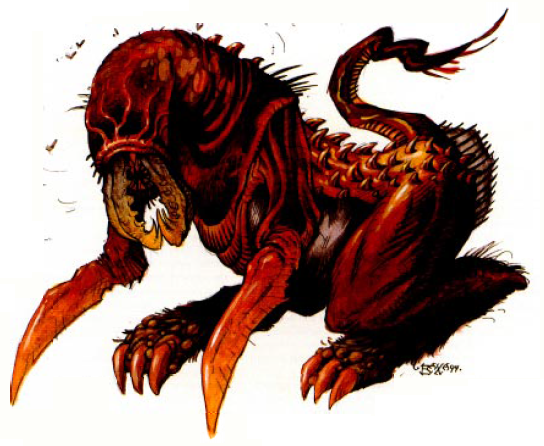
Dwarf banshee
Dwarves who die before completing a major focus are often condemned to live out their afterlives as banshees. In unlife they haunt their unfinished work or quest, unable to bear the fact that someone else may complete what they could not. Day or night, the pupils of their eyes flicker red as if a flame burns them from within.
A dwarven banshee’s appearance changes as soon as the transformation from life to undeath begins. The skin rots away leaving the underlying muscles exposed. The muscle turns brown if exposed to sunlight and sand; if protected or underground, it becomes gray or moldy in color.
The approach of a living individual within a mile causes the banshee to rise, regardless of the time of day. It remains alert as long as the intruder remains within the area. The banshee often watches and waits to see what action the individual or party takes before attacking.
Dwarven banshees only want to protect what was theirs. Fables say that the seventh son of a seventh son may lay a dwarven banshee to rest by finishing a focus for it. Elders say the flames within dwarven banshees’ eyes originate from some ancient dwarven forge on the elemental plane of fire.
When the dwarf banshee’s physical corpse reaches 0 hit points, the remainder crumbles to dust. If the dwarf's unfulfilled focus is not destroyed or somehow completed, this banshee returns full strength at the next sunset.
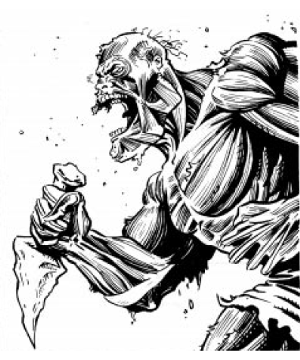
Dwarf banshee
Medium undead, neutral evil
- Armor Class 15
- Hit Points 58 (9d8+18)
- Speed 25 ft.
STR DEX CON INT WIS CHA 15 (+2) 16 (+3) 15 (+2) 7 (-2) 12 (+1) 12 (+1)
- Damage Resistances psychic, fire, cold, thunder, lightning, bludgeoning, piercing, and slashing from non-magical or non-metal attacks
- Damage Vulnerability any damage from a cleric of earth
- Condition Immunities charmed, frightened, poisoned
- Skills Perception +4, Stealth +6
- Senses darkvision 120 ft., passive perception 14
- Languages Dwarf, Common
- Challenge 6 (2,300 XP)
Detect Life. The dwarf banshee can sense the presence of living creatures within one mile of it.
Cursed Gaze. During the day, when a creature that can see the dwarf banshee's eyes starts its turn within 30 feet of the banshee, the banshee can force it to make a DC 13 Charisma saving throw if the banshee isn't incapacitated and can see the target. If the saving throw fails, the target flies into a rage for 2d6 rounds, gaining advantage on its attacks while attacks on it have advantage. The target cannot distinguish between friend and foe, attacking whatever is nearest, but never the banshee even if the banshee attacks the target. The target can make another saving throw at the end of its turns to end the effect. A remove curse also ends the effect.
Actions
Fist. Melee Weapon Attack: +5 to hit, reach 5 ft., one target. Hit: 4 (1d4+2) bludgeoning damage plus 9 (2d8) necrotic damage.
Night wail (recharge 6). At night, the banshee unleashes a cursed battle cry that affects all targets within 30 ft. of it as if subjected to its Cursed Gaze.
Decay. One visible target in 60 ft. must make a DC 13 Constitution saving throw, taking 22 (4d10) necrotic damage on a failed save, or half as much on a successful one.
Erdlu
Erdlus are tall, flightless, featherless birds covered with flaky scales that range in color from pale gray to deep red. An erdlu can weigh as much as 200 pounds and grow to a height of 7 feet. Its massive, round body has a pair of useless wings that fold in at its sides. A snakelike neck rises to a small round head with a huge, wedge-shaped beak. A pair of powerful, lanky legs extend down from the body and end in four-toed, razor-clawed feet.
Erdlus make ideal herd animals because of their temperaments and ability to survive on a variety of foods. They can eat many forms of tough vegetation, as well as snakes, reptiles, and insects. The eggs that erdlus provide are an excellent source of nutrition. A diet of erdlu eggs can keep a human or demihuman alive for months at a time, for the eggs are packed with a variety of nutrients and essential vitamins. If an erdlu egg is eaten raw, it is a substitute for one gallon of water. However, this substitution isn’t perfect and can only be used successfully for no more than one week. The meat of an erdlu also makes an excellent meal.
A common, larger version of the erdlu is called an erdland. Used as mounts or to pull caravans, erdland are a common sight along the trader routes through the deserts of Athas. Erdlands, like their smaller cousins, are flightless, featherless birds which are covered with red to grey scales. Erdlands can weigh up to 2,000 pounds and often stand nearly 15 feet tall.
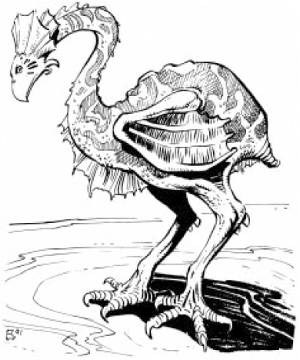
Erdlu
Medium beast, unaligned
- Armor Class 12
- Hit Points 20 (3d8+6)
- Speed 30 ft.
STR DEX CON INT WIS CHA 16 (+3) 14 (+2) 14 (+2) 3 (-4) 10 (+0) 6 (-2)
- Senses passive Perception 10
- Challenge 1/2 (100 XP)
Actions
Multiattack. The erdlu attacks with its claws and beak.
Claws. Melee Weapon Attack: +3 to hit, reach 5 ft., one target. Hit: 7 (1d6+3) bludgeoning damage.
Bite. Melee Weapon Attack: +3 to hit, reach 5 ft., one target. Hit: 5 (1d4+3) piercing damage.
Erdland
Large beast, unaligned
- Armor Class 13
- Hit Points 26 (3d10+6)
- Speed 30 ft.
STR DEX CON INT WIS CHA 18 (+4) 14 (+2) 16 (+3) 3 (-4) 10 (+0) 6 (-2)
- Senses passive Perception 10
- Challenge 1 (200 XP)
Actions
Multiattack. The erdland makes two attacks.
Beak. Melee Weapon Attack: +4 to hit, reach 5 ft., one target. Hit: 9 (1d8+4) piercing damage.
Feylaar
Feylaars are large, lumbering four-armed, apelike forest dwellers known for their physical strength. Once hunted for slave labor, feylaars quickly demonstrated that their psionic powers made them too dangerous to domesticate.
Feylaars stand nearly a foot taller than most elves and possess the breadth to match. Four powerful arms stretch from the torso, each able to act independently of the other three. Though the creatures are capable of standing fully erect, feylaars usually move about on their legs and lower arms. Inside the feylaars’ large mouths are two sets of fangs, one upper and one lower, and many sharp teeth that enable them to quickly grind and swallow flesh. When surprised, feylaars’ thick, course hair is a dull gray or black, but usually the beasts use their psionics to blend with the environment.
The origin of the feylaar is shrouded in mystery. Though their discovery is recent, their population density, especially in the Forest Ridge west of the Ringing Mountains, indicates they have existed on Athas for some time. Rumors say that a long-dead sorcerer king created the feylaar to swell the ranks of his army with soldiers that could fight without weapons. Another story suggests that the feylaars themselves wrought their second pair of arms via their psychometabolism. Such legends are ill-founded at best, but offer as much insight as any hidden truth.
Feylaars loathe captivity. They are impossible to hold for long. They can generate a death field that often takes many handlers and feeders to the grave with them.
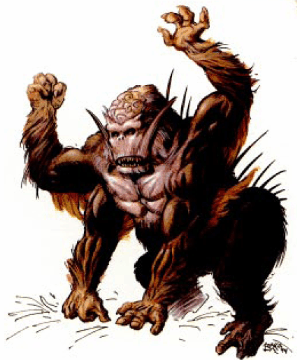
Feylaar
Large monstrosity, neutral evil
- Armor Class 15
- Hit Points 60 (7d10+21)
- Speed 25 ft., climb 25 ft.
STR DEX CON INT WIS CHA 17 (+3) 12 (+1) 16 (+3) 11 (+0) 11 (+0) 8 (-1)
- Skills Athletics +5, Perception +2, Stealth +3
- Senses passive perception 12
- Languages Feylaar, halfling
- Challenge 4 (1,100 XP)
Chameleon Skin. The feylaar can psionically can change its skin color to match its surroundings and has advantage on Stealth checks to hide.
Displacement (1/day). As a reaction, when the feylaar takes damage from an attacker it can see, it reduces the damage by half.
Actions
Multiattack. The feylaar makes four fist attacks and one bite.
Fists. Melee Weapon Attack: +5 to hit, reach 10 ft., one target. Hit: 7 (1d6+3) bludgeoning damage and the target is grappled (escape DC 13.)
Bite. Melee Weapon Attack: +5 to hit, reach 5 ft., one target. Hit: 8 (1d8+3) piercing damage.
Death Field (1/day). The feylaar sacrifices up to half of its hit points (it must leave itself with at least 1 hit point). Every living creature within 20 feet must make a DC 13 Constitution saving throw, taking the amount sacrificed on a failed save, or half as much on a successful one.
Ego Whip (recharge 5-6). One visible target within 60 ft. must make a DC 13 Intelligence saving throw or take 2d8 psychic damage and be filled with self-doubt, leaving it unable on its next turn to take any action except Dodge, Disengage, or Hide. On a successful saving throw, it takes half as much damage.
Floater
Floaters are small, aerial, jelly fish that drift above the Sea of Silt. They are often found at the edges of the silt sea, near the mudflats that form its perimeter. Floaters resemble jelly fish in all ways save that they exist out of water. Their bodies are bulbous and translucent, and have a diameter of about 2 feet. They also sport a large number of poisoned tentacles, up to 3 feet in length.
Floaters survive largely on the ferns and roots that grow in the wetter areas of the mudflats and are a favorite food of razorwings.
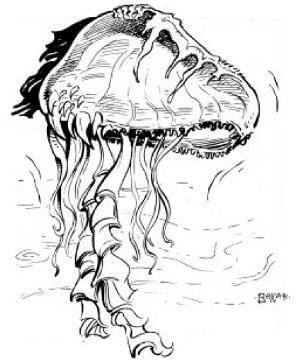
Floater
Small beast, unaligned
- Armor Class 11
- Hit Points 11 (3d6)
- Speed fly 20 ft.
STR DEX CON INT WIS CHA 4 (-3) 13 (+1) 10 (+0) 2 (-4) 12 (+1) 6 (-2)
- Skills Stealth +8
- Senses passive Perception 11
- Challenge 1/2 (100 XP)
Detect Life. The floater can sense the presence of living creatures within 120 feet of it.
Actions
Tentacles. Melee Weapon Attack: +3 to hit, reach 5 ft., one target. Hit: 4 (1d4+1) piercing damage plus the target must make a DC 11 Constitution save or be paralyzed for 1d4 rounds. The target may make a save at the end of each of its turns to end the effect.
Demoralize (recharge 5-6). Visible target in 60 feet must make a DC 11 Wisdom save or be frightened for 1 minute. The target may make a save at the end of each of its turns to end the effect.
Mind Slam (recharge 5-6). Visible target in 60 feet must make a DC 11 Constitution save or take 1d6 force damage, and if size large or smaller, is knocked prone.
Fordorran
The fordorran is a foul, disgusting creature that inhabits the Tablelands surrounding the Silt Sea. It is extremely unpredictable, wanders aimlessly, and may attack for no reason. It is believed to be a distant cousin of the so-ut. It resembles an enormous armadillo with a formation of three horns on its head. Its armored plates are divided into sections that allow the beast to curl into a ball for protection. The fordorran has the ability to blend in with its surroundings by changing its coloration. This would make the beast nearly undetectable if it weren’t for the foul stench it constantly emits. The armored plates are hairless, but there is a light coat of fur on the underside of its body, on its legs, and between its armored plates. A fordorran is feet tall, 8 feet long, and weighs 1,800 pounds.
Fordorrans are known to inhabit the Tablelands, making their lairs in caves and crevasses. They have never been known to congregate in groups. Perhaps even they can’t stand the stench of their own kind. Therefore, it remains unknown how the creatures reproduce. They are just as likely to ignore other creatures as they are to attack them or even befriend them temporarily. They will eat gems or colored glass, despite the fact that they can’t digest either material.
Fordorran flesh is edible, but tastes as bad as it smells. It is rumored that certain elf tribes know how to prepare fordorran meat to make it palatable. The gland that is responsible for the creature’s horrible aroma is highly sought by preservers and defilers to create potions.
A fordorran has instinctual psionic ability and uses its beguile ability to lure prey close.
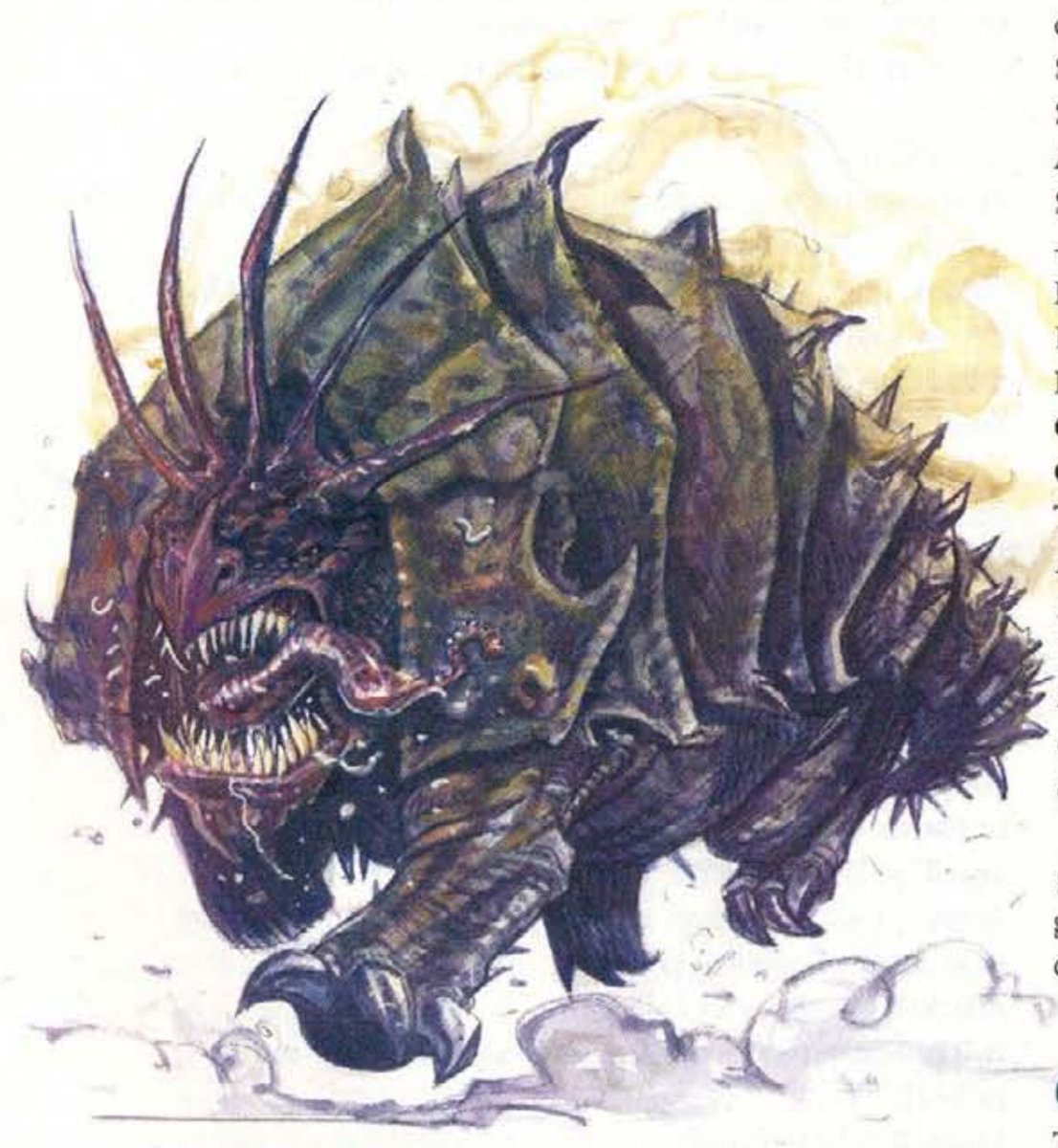
Fordorran
Large beast, unaligned
- Armor Class 15
- Hit Points 51 (6d10+18)
- Speed 30 ft.
STR DEX CON INT WIS CHA 18 (+4) 11 (+0) 17 (+3) 2 (-4) 12 (+1) 6 (-2)
- Condition Immunities charmed, paralyzed, sleep
- Skills Perception +3
- Senses Darkvision 60 ft., passive perception 13
- Challenge 3 (700 XP)
Stench. Any creature that starts its turn within 5 ft. of the fordorran must succeed on a DC 13 Constitution saving throw or be poisoned until the start of its next turn. On a successful saving throw, the creature is immune to that fordorran's Stench for 24 hours.
Actions
Multiattack. The fordorran makes three attacks: two claws and one gore.
Claws. Melee Weapon Attack: +6 to hit, reach 5 ft., one target. Hit: 7 (1d6+4) slashing damage.
Gore. Melee Weapon Attack: +6 to hit, reach 5 ft., one target. Hit: 8 (1d8+4) piercing damage.
Beguile. A fordorran can beguile one living creature it can see within 120 feet. The target must succeed on a DC 10 Charisma saving throw or be charmed by it until the end of the fordorran's next turn.
Gaj
The gaj is a psionic horror. Physically, it appears as a large reptile resembling a beetle in appearance. Its body is covered by a scaly, rust-orange shell about six feet in diameter. From beneath this shell protrude six four-jointed legs which end in webbed feet with long, sharp claws. Its head is a spongy white globe about two feet in diameter. Spaced at even intervals around the head are six compound eyes. A pair of barbed mandibles as long as a man’s arms flank six fingerlike appendages that hang over its mouth, and three feathery stalks rise from the top of the head. A gaj is 10 feet long and weighs around 500 pounds.
The gaj are solitary hunters that prey on other intelligent life forms. They prefer to live in rocky areas where their shells serve as camouflage, or in sandy areas where they can hide themselves from predators in a shallow burrow. Most often, they are found alone, but occasionally mated pairs are encountered.
Like all carnivores, the gaj eat flesh to provide their bodies with physical energy. Unlike most other animals, however, the gaj derive their mental energy from the thoughts of other beings, through the effects of their probe powers. No matter where they live, the gaj are constantly using their feathery antennas to search the horizon with their psionic life detection powers for signs of their favorite prey-other intelligent races. After a week without consuming the thoughts of an intelligent creature, the gaj starts "starving." A month without such thoughts causes it to lose its will to live, and in another week, it will die.
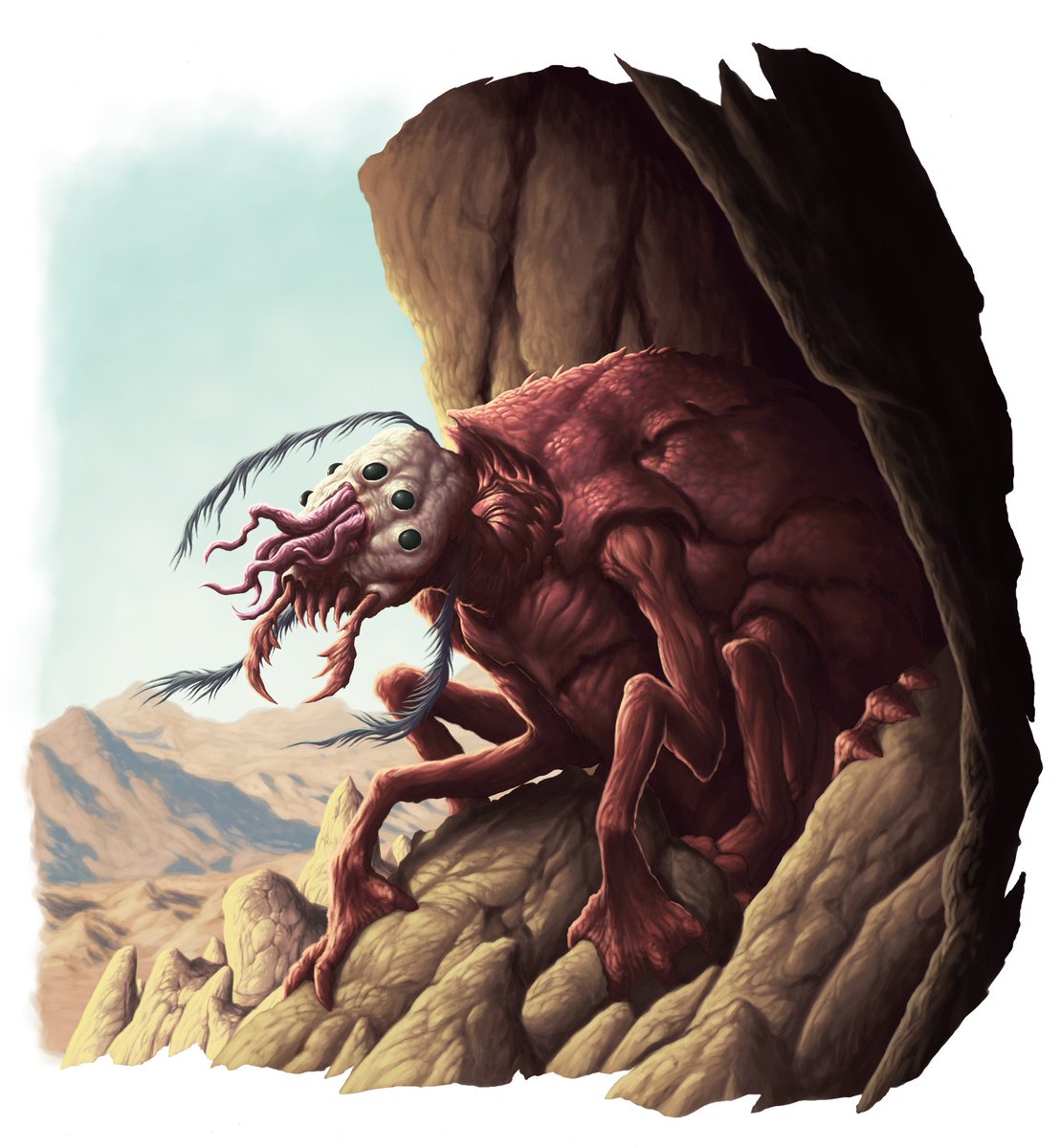
Gaj
Large monstrosity, neutral evil
- Armor Class 17
- Hit Points 126 (11d8+77)
- Speed 20 ft.
STR DEX CON INT WIS CHA 24 (+7) 11 (+0) 25 (+7) 14 (+2) 20 (+5) 20 (+5)
- Saving Throws Str +10, Int +5, Wis +8, Cha +8
- Damage Resistances psychic, bludgeoning, piercing, and slashing from non-metal attacks
- Skills Perception +13, Survival +8, Intimidate +8
- Senses passive Perception 23
- Languages Telepathy one visible target in 120', knows if target is lying to the gaj
- Challenge 11 (7,200 XP)
Detect Life and Psionics. The gaj can sense the presence of living creatures and psionic use within 120 feet of it and their general direction.
Actions
Mandibles. Melee Weapon Attack: +10 to hit, reach 10 ft., one target. Hit: 14 (2d6+7) piercing damage and the target is grappled (escape DC 17) if it is a Large or smaller creature. Until the grapple ends, the gaj cannot attack another creature with its mandibles.
Probe Drain. As a bonus action, the gaj can use its antennae against a grappled creature. The target must make a DC 16 Intelligence saving throw or its Intelligence is reduced by 1d4. A successful save reduces this to 1. If the gaj drains a target to 0 points, the victim permanently becomes a mindless husk. The reduction lasts until the target finishes a short or long rest.
Ego Whip. One visible target within 60 ft. must make a DC 16 Intelligence saving throw or take 3d8 psychic damage and be filled with self-doubt, leaving it unable on its next turn to take any action except Dodge, Disengage, or Hide. On a successful saving throw, it takes half as much damage.
Dominate Creature (recharge 4-6). One visible creature in 60 ft. must make a DC 16 Intelligence saving throw or the gaj chooses its actions and movement. Lasts 1 minute, and the target gets a save at the end of each of its turns to end the effect.
Psychic Crush (recharge 5-6). Creates a 20-foot cube, range 120 feet. Those in area must make a DC 16 Intelligence save or take 8d8 psychic damage and be stunned until the end of the gaj's next turn. A target takes half as much damage on a successful save.
Giant Ant Lion
The ant lion is a huge, vicious insect that lurks in the bottom of deep pits, feeding on creatures unlucky enough to fall in. Ant lions live in badlands, desert fringes, and other areas with loose soil and sand. The ant lion resembles a cross between a mole and a giant ant. Its body, gray or sandy brown in color, is covered completely by a leathery exoskeleton with patches of coarse black bristles that are sensitive to movement and odor. It has deep-set beady eyes, rows of jagged teeth capable of both tearing and grinding, and six thick legs with sharp claws and flat bristles. The claws are used for digging while the bristles sweep away the loose soil. The ant 1ion’s most prominent features are its mandibles, silvery gray and razor-edged, extending three feet from its mouth. A single barb centered on the inner ridge of each mandible is used to impale and hold prey.
Ant lions near civilized regions are considered dangerous predators. Rewards are often available for proof of their destruction. Ant lions eat any creature that falls into their pits, though they prefer giant insets, usually eating one or more giant ants per day. Farmers will use their mandibles for plows.
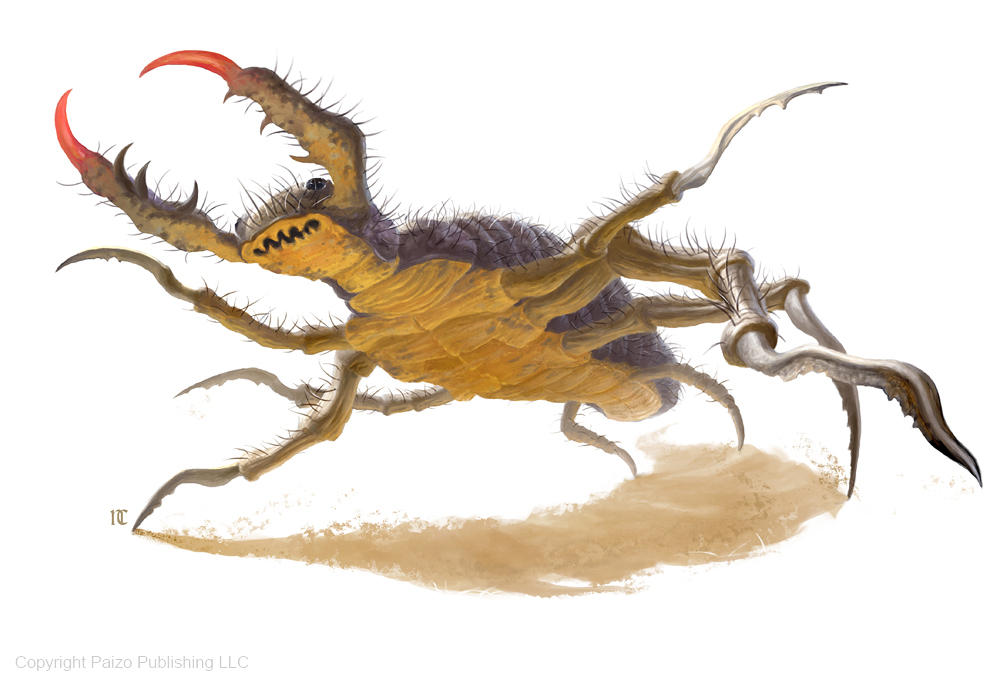
Giant ant lion
Large beast, unaligned
- Armor Class 14
- Hit Points 45 (6d10+12)
- Speed 10 ft., burrow 10 ft.
STR DEX CON INT WIS CHA 16 (+3) 8 (-1) 14 (+2) 1 (-5) 10 (+0) 3 (-4)
- Senses tremorsense 30 ft., passive perception 10
- Challenge 1 (200 XP)
Ambush. A giant ant lion submerged in sand has a +10 bonus to Stealth. It has advantage on attacks against creatures that have not taken a turn in the combat yet.
Actions
Bite. Melee Weapon Attack: +5 to hit, reach 5 ft., one target. Hit: 8 (2d4+3) piercing damage, and the target is grappled (escape DC 13). Until the grapple ends, the target is restrained, and the giant ant lion can't bite another target.
Giant, Athas
The giants of Athas are huge, lumbering creatures who commonly inhabit the islands of the Sea of Silt. They are divided into the human and psionic capable beast heads. All the giants of Athas share one characteristic, and that is savagery. Though humanoid giants can be congenial and friendly when properly approached, they have short tempers and are very easily agitated.
Many giants on Athas live on islands in the shallower areas of the Sea of Silt where they wade the silt on known safe paths to trade, or when bribed into carrying smaller beings as passengers. Giants are fickle, though, so travelers must take care not to offend them. All giants tend to group in small clans of 5-10 members.
Human Head Giants
Human head giants stand anywhere from 20 to 25 feet tall and weigh from six to eight tons each. They are divided into two clans: desert giants, who have exaggerated facial features such as huge noses, mouths, or ears, and plains giants, who more resemble elves.
Desert Giants
Desert giants are cruel and selfish creatures. Their skin is most often dark red, but some specimens have jet-black skin. The hair of desert giants is usually a light brown color and is very coarse and sturdy. These giants often sell their hair to rope makers and are treacherous partners, looking for opportunity such as tossing a passenger into the deep silt after collecting payment. Desert giants live on desert terrain on the islands in the Sea of Silt, herding erdlus and kanks while preferring on occasion the taste of a humanoid.
Plains Giants
Plains giants have slender faces and pointed ears, with light hair. They live on vegetated islands and are a much more common sight on the main lands of Athas, as their balanced disposition makes them more compatible with members of the other Athasian races. Though it is considered dishonorable, a few plains giants hire themselves out as mercenaries. Some find work as builders or as wrecking crews.
Beastheads
Beasthead giants are a rarer form of Athasian giant who also make their homes on the islands of the Sea of Silt. Though somewhat smaller than humanoid giants, beasthead giants are more dangerous and consider themselves the one true form of giant.
Beasthead giants are smaller and lighter skinned than their humanoid cousins, averaging 15 to 20 feet tall and weighing from three to six tons. Beasthead giants, as their name implies, have a human-looking body and the head of a beast. There are many different types divided into clans: some bearing the head of a bear, or a kes'trekel, or the head of a dagorran.
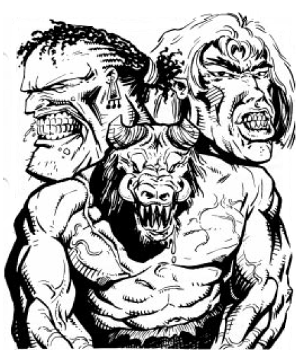
Desert / plains giant
Huge giant, neutral evil or chaotic good
- Armor Class 14
- Hit Points 200 (16d12+96)
- Speed 40 ft.
STR DEX CON INT WIS CHA 27 (+8) 10 (+0) 22 (+6) 7 (-2) 16 (+3) 13 (+1)
- Saving Throws Con +10, Wis +8, Cha +5
- Damage Resistances psychic
- Skills Athletics +12, Perception +7
- Senses passive Perception 17
- Languages Giant, Common
- Challenge 9 (5,000 XP)
Psionic Resistance. The giant has advantage on psionic saving throws.
Actions
Multiattack. The giant makes two spear attacks.
Greatspear. Melee Weapon Attack: +12 to hit, reach 10 ft., one target. Hit: 21 (3d8+8) piercing damage.
Rock. Ranged Weapon Attack: +12 to hit, range 60/240 ft., one target. Hit: 30 (4d10+8) bludgeoning damage.
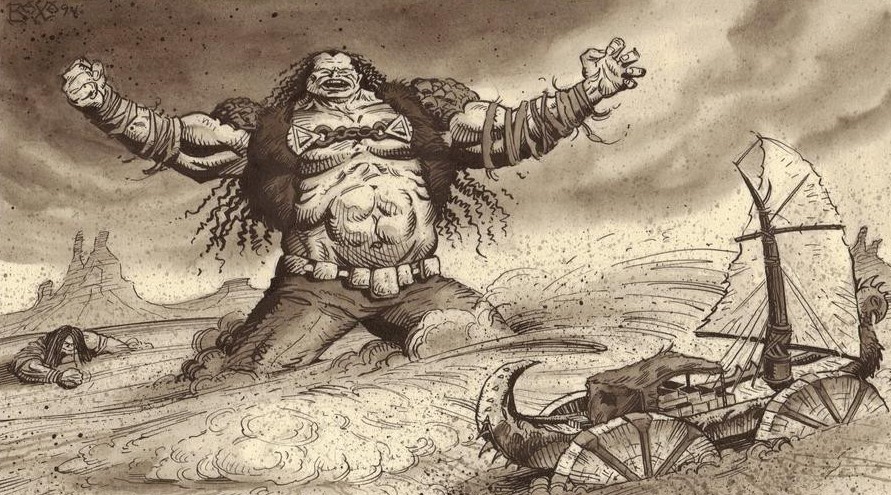
Beasthead Giant
Huge giant, neutral evil
- Armor Class 16
- Hit Points 189 (14d12+98)
- Speed 40 ft.
STR DEX CON INT WIS CHA 25 (+7) 10 (+0) 24 (+7) 7 (-2) 16 (+3) 12 (+1)
- Saving Throws Str +11, Con +11, Wis +7
- Damage Resistances psychic
- Skills Athletics +11, Perception +7
- Senses passive Perception 17
- Languages Giant, Common
- Challenge 9 (5,000 XP)
Psionic Resistance. The giant has advantage on psionic saving throws.
Actions
Multiattack. The giant makes two club attacks and a bite.
Club. Melee Weapon Attack: +11 to hit, reach 10 ft., one target. Hit: 22 (3d8+7) bludgeoning damage.
Bite. Melee Weapon Attack: +11 to hit, reach 10 ft., one target. Hit: 25 (3d10+7) piercing damage.
Rock. Ranged Weapon Attack: +11 to hit, range 60/240 ft., one target. Hit: 25 (3d10+7) bludgeoning damage.
Psionic Powers (Action)
Psychic Focus. The giant's greatclub damage is psychic and magical. The giant can use a bonus action to end this effect.
Psionic Blast (recharge 6). The giant targets one creature it can see within 60 feet. That target takes 4d8 psychic damage.
Detect Life (at will). The giant can detect living creatures within 120 feet and their general direction.
Giant diplomacy
There is no love lost between the beastheads and humanhead giants, though they rarely will skirmish enough for deaths. They are united, however, in their hatred of outsiders, especially the silt skirmishers of Balic. The sight of a silk skimmer sail is enough to cause many to launch rocks first, talk later. For those who can develop business relations with giants, however, the enterprise can be lucrative as giant-hair is considered unmatched for use in crafting rope and certain armors.
Giant, Shadow
Shadow giants, or shadow people as they prefer to call themselves, are the descendants of the halflings who served Rajaat the Warbringer during the Cleansing Wars. They appear either as 10 foot tall, shadowy, two-dimensional, vaguely humanoid-shaped silhouettes with ropy limbs, serpentine torsos, and blue embers in place of eyes, or as solid, three-dimensional shadows as tall as half-giants. Bright light adds size and depth to a shadow giant. The brighter the light source, the larger the shadow giant appears. In full sunlight a shadow giant can grow to 25 feet.
When a shadow giant speaks, black fumes rise from a blue gash that opens where its mouth would normally be. When a shadow giant grips a target, blackness spreads slowly from the contact point to engulf the target. The growing black stain of a shadow giant’s touch is accompanied by a cold, numbing pain that draws heat from the body.
Shadow giants reside both in the Pristine Tower and in the nether dimension known as the Black. Shadow giants are the descendants of the loyal servants of Rajaat who the Champions sacrificed to complete the betrayal of their master. These halflings merged with the Black and can only interact with the real world in the form of shadows.
The shadow people can emerge only partially from the Black until Rajaat’s prison is destroyed. No one knows how much time the shadow people spend in the Black or on Athas. It is not known what they eat, but the shadow people desire obsidian as eggs to incubate their young and have contracts with nobles, including one from Urik to provide 100 unblemished balls of obsidian each year.
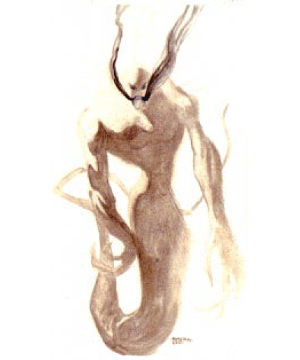
Shadow Giant
Huge undead, chaotic neutral
- Armor Class 15
- Hit Points 95 (7d12+49)
- Speed 40 ft.
STR DEX CON INT WIS CHA 18 (+4) 14 (+2) 24 (+7) 14 (+2) 14 (+2) 8 (-1)
- Saving Throws Con +10, Wis +5
- Damage Immunities necrotic, poison, cold, nonmagical bludgeoning, piercing, and slashing attacks
- Condition Immunities charmed, exhaustion, frightened, grappled, paralyzed, petrified, poisoned, prone, restrained, sleep
- Senses darkvision 240 ft., passive Perception 12
- Languages Ancient halfling, Draxa, Common
- Challenge 9 (5,000 XP)
Light Regeneration. The giant becomes more powerful in light. In dim light, the giant regains 10 hit points at the start of its turn. In bright light, it regains 20 hit points instead.
Light Strength. In dim light, the giant has advantage on its saving throws. In bright light, it also has advantage on its attacks.
Weaken Weapon. Nonmagical weapons that strike the giant emerged coated in the Black. For 1 minute, each hit with that weapon triggers a weapon breaking check. Metal weapons break on a 1 on 1d20.
Arcane Vulnerability. The touch of an arcane caster can destroy a shadow giant. An arcane caster who touches the giant can expend a spell slot to deal 1d6 force damage per level of the slot to the giant.
Actions
Multiattack. The giant makes two fist attacks or one drain.
Fist. Melee Weapon Attack: +7 to hit, reach 10 ft., one target. Hit: 12 (2d6+4) necrotic damage and the target's Strength score is reduced by 1. The target drops to 0 hit points if reduced to 0 Strength and cannot move or take actions. The reduction lasts until the target finishes a short or long rest.
Drain. Melee Weapon Attack: +7 to hit, reach 10 ft., one target. Hit: the target's Strength score is reduced by 1d4+1. A target reduced to 0 Strength in this way or drained when already at 0 Strength is drawn into the Black and dies. Her body cannot be retrieved unless the shadow giant who killed her releases the body back to Athas.
Gith
The gith are a race of grotesque humanoids that appear to be a peculiar mixture of elf and reptile. They are extremely gaunt and lanky, with long gangling arms and spindly legs. Their hands have three fingers with no opposable thumbs, yet they are able to use tools and wield weapons. Their fingers and toes end in sharp claws. If one could get a gith to stand up straight, he would measure close to 7 feet tall. However, most gith appear to be no more than 5 feet tall, for they always stand hunched over at the shoulders, in a permanent slouch.
The gith live in tribal organizations. The individual with the most powerful psionics generally acts as the leader. All other social positions are distributed at his pleasure. They count in their ranks shamans (clerics) and defilers.
Mountain gith live in underground lairs, claiming a particular canyon or valley as their territory. Gith inhabiting tablelands tend to organize their society more along the lines of a nomadic hunting clan, going wherever the game takes them. They do not hesitate to attack humanoids, preferring sentient flesh over other meat. They will even attack thri-kreen, if they are hungry enough, but the insectoids taste bad, and usually can outrun gith raiders.
The gith are usually armed with large, wicked-looking spears that have giant, razor-sharp heads of polished obsidian. Although these spears look like thrusting weapons, they are used primarily to slash or chop. The gith often armor themselves, and especially their vulnerable backs, with inix-shell armor of their own manufacture.
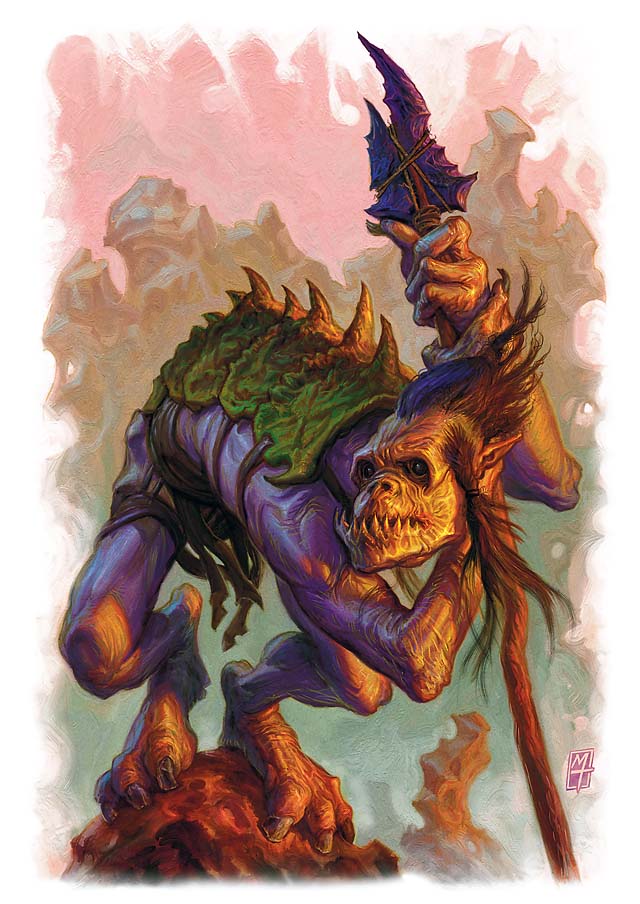
Gith
Medium humanoid, chaotic evil
- Armor Class 14 (inix shell)
- Hit Points 17 (3d8+3)
- Speed 25 ft.
STR DEX CON INT WIS CHA 15 (+2) 11 (+0) 12 (+1) 10 (+0) 11 (+0) 10 (+0)
- Senses passive Perception 10
- Languages Gith
- Challenge 1/4 (50 XP)
Leap. If a gith has at least a 20 foot straight path to its target, it can jump for its movement and attack with advantage.
Actions
Claws. Melee Weapon Attack: +4 to hit, reach 5 ft., one target. Hit: 4 (1d4+2) slashing damage.
Obsidian spear. Melee Weapon Attack: +4 to hit, reach 5 ft., one target. Hit: 6 (1d6+2) piercing damage.
Gith Subleader
Medium humanoid, chaotic evil
- Armor Class 17 (chitin shell)
- Hit Points 50 (9d8+9)
- Speed 25 ft.
STR DEX CON INT WIS CHA 15 (+2) 14 (+2) 12 (+1) 12 (+1) 13 (+1) 10 (+0)
- Saving Throws Con +3, Int +3, Wis +3
- Senses passive Perception 11
- Languages Gith
- Challenge 3 (100 XP)
Leap. If a gith has at least a 20 foot straight path to its target, it can jump for its movement and attack with advantage.
Innate psionics. The Gith manifests the following spells as psionic powers requiring no components:
At will: mage hand (invisible)
3/day: feather fall, misty step, shieldActions
Multiattack. The gith makes two attacks.
Claws. Melee Weapon Attack: +4 to hit, reach 5 ft., one target. Hit: 4 (1d4+2) slashing damage plus 7 (2d6) psychic damage.
Bone trikal. Melee Weapon Attack: +4 to hit, reach 10 ft., one target. Hit: 7 (1d8+2) slashing damage plus 7 (2d6) psychic damage.
Gith and Githyanki
The gith of Athas are one of the more populous and common races. They bear a striking similarity to the githyanki of other settings and for good reason: gith are descendants of the Githyanki. In a bid to conquer Athas thousands of years ago, they created various strongholds that could only be accessed with planar keys. However, their enemies, the githzerai, sabotaged the effort by destroying off a psionic artifact. The backlash scarred the minds of the Githyanki to a more primitive level and scrambled their psionic prowess. Thus, the Gith were born, and they have devolved over the eons.
While this knowledge is lost to time, it might explain the birth of psionics on Athas.
Gith Tribe Leader
Medium humanoid, chaotic evil
- Armor Class 18 (braxat shell)
- Hit Points 91 (14d8+28)
- Speed 25 ft.
STR DEX CON INT WIS CHA 16 (+3) 14 (+2) 15 (+2) 14 (+1) 16 (+2) 15 (+2)
- Saving Throws Con +5, Int +5, Wis +5
- Senses passive Perception 12
- Languages Gith
- Challenge 5 (1,800 XP)
Leap. If a gith has at least a 20 foot straight path to its target, it can jump for its movement and attack with advantage.
Innate psionics. The Gith manifests the following spells as psionic powers requiring no components (DC 15 save, +7 hit):
At will: mage hand (invisible)
3/day: blur, misty step, nondetection, shield
1/day: mass suggestion, telekinesisRally the Troops. All allies in 30 feet gain +2 to Initiative. As a bonus action, the gith can end charmed and frightened conditions on itself and each creature of choice it can see within 30 feet of it.
Actions
Multiattack. The gith makes two attacks.
Claws. Melee Weapon Attack: +6 to hit, reach 5 ft., one target. Hit: 4 (1d4+3) slashing damage plus 10 (3d6) psychic damage.
Obsidian greatsword. Melee Weapon Attack: +6 to hit, reach 5 ft., one target. Hit: 7 (2d6+3) slashing damage plus 10 (3d6) psychic damage.
Gith Defiler
Medium humanoid, chaotic evil
- Armor Class 12
- Hit Points 44 (8d6+16)
- Speed 25 ft.
STR DEX CON INT WIS CHA 10 (+0) 14 (+2) 15 (+2) 16 (+3) 12 (+1) 10 (+0)
- Saving Throws Int +6, Wis +4
- Senses passive Perception 11
- Languages Gith
- Challenge 4 (1,800 XP)
Innate psionics. The Gith manifests the following spells as psionic powers requiring no components (DC 15 save, +7 hit):
At will: mage hand (invisible)
3/day: misty step, nondetection, shield
1/day: telekinesisSpellcasting. The gith is an 8th level wizard (DC 14 saves, +6 hit).
Cantrips (at will): fire bolt, light, message, true strike
1st level (4 slots): expeditious retreat, magic missile, sleep, thunderwave
2nd level (3 slots): blur, invisibility, levitate
3rd level (2 slots): counterspell, fireball, haste
4th level (2 slots): silt horror's tentaclesSculpt Spells When it casts an evocation spell that affects other creatures that it can see, the gith can choose a number of them equal to 1 + the spell's level. The chosen creatures automatically succeed on their saving throws against the spell, and they take no damage if they would normally take half damage on a successful save.
Defiler aura. Gith defilers have 1d6x8 points.
Actions
Multiattack. The gith makes two attacks.
Claws. Melee Weapon Attack: +3 to hit, reach 5 ft., one target. Hit: 4 (1d4) slashing damage plus 4 (1d6) psychic damage.
Gith Apprentice
Medium humanoid, chaotic evil
- Armor Class 12
- Hit Points 11 (2d6+4)
- Speed 25 ft.
STR DEX CON INT WIS CHA 10 (+0) 14 (+2) 14 (+2) 15 (+2) 12 (+1) 10 (+0)
- Saving Throws Int +4, Wis +3
- Senses passive Perception 11
- Languages Gith
- Challenge 1/2 (1000 XP)
Innate psionics. The Gith manifests the following spells as psionic powers requiring no components (DC 15 save, +7 hit):
At will: mage hand (invisible)
3/day: misty step, nondetection, shieldSpellcasting. The gith is a 3rd level wizard (DC 12 saves, +4 hit).
Cantrips (at will): fire bolt, light, message
1st level (4 slots): magic missile, sleep, thunderwave
2nd level (2 slots): blur, scorching raySculpt Spells When it casts an evocation spell that affects other creatures that it can see, the gith can choose a number of them equal to 1 + the spell's level. The chosen creatures automatically succeed on their saving throws against the spell, and they take no damage if they would normally take half damage on a successful save.
Defiler aura. Gith defilers have 1d6x3 points.
Actions
Multiattack. The gith makes two attacks.
Claws. Melee Weapon Attack: +2 to hit, reach 5 ft., one target. Hit: 4 (1d4) slashing damage plus 4 (1d6) psychic damage.
Hej-kin
Hej-kin are a race of vile-looking humanoids who inhabit the natural subterranean caverns and tunnels of Athas. Hej-kin have round chubby faces which are accented by large noses and small, slanted eyes. The ears of hej-kin are pointed, short, and covered with a thick fur. The skin color of hej-kin varies greatly, from deep red to a dark mossy green. Most hej-kin clans will usually be all of the same color skin, and most tend to be reddish and orange colored. The skin of a hej-kin is thick and very tough, similar in texture to softened leather hide.
The language of the hej-kin is a combination of sign and verbal communication. Hej-kin speak in a low-pitched voice that resembles human mumbling in sound.
Most clans make their homes in caverns adjacent to underground streams providing the clan with an adequate supply of water. Unlike many other types of subterranean dwellers, hej-kin do not dig tunnels or caves, for doing so would disturb the earth, which they consider to be sacred.
Hej-kin are omnivores, relying on both meat and vegetables as sources of food. Most of their food comes from subterranean plants and small underground creatures.
Within a clan of hej-kin, there exist examples of the warrior, priest, and mage classes. All hej-kin mages are preservers and all priests of earth due to their race’s worship of the land. Hej-kin priests are the only members of their society who ever travel to the surface, usually to investigate some disturbance that threatens their home or the earth. Hej-kin are natural enemies to most other races, both surface dwellers and other subterranean races. This is due to the abuse and destruction of the earth perpetrated by other races.
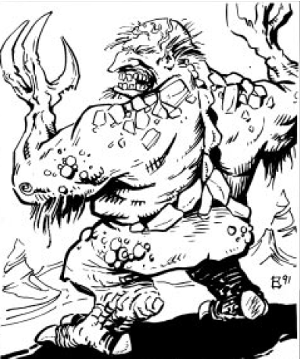
Hej-kin warrior
Small humanoid (hej-kin), neutral evil
- Armor Class 10
- Hit Points 9 (2d6+2)
- Speed 20 ft., phase (stone) 10 ft.
STR DEX CON INT WIS CHA 12 (+1) 11 (+0) 12 (+1) 9 (-1) 11 (+0) 10 (+0)
- Skills Stealth +2, Perception +4
- Damage resistances psychic
- Senses Darkvision 60 ft., passive Perception 14
- Languages Hej-kin
- Challenge 1/8 (25 XP)
Phase. The hej-kin can move through earth and stone and may end its movement in such, though it is still subject to suffocation rules. When using phasing, the hej-kin has advantage on Stealth checks to surprise enemies.
Actions
Multiattack. The hej-kin makes two claw attacks.
Claw. Melee Weapon Attack: +3 to hit, reach 5 ft., one target. Hit: 3 (1d4+1) slashing damage.
Life Drain (recharge 5-6). A living target within 60 ft. that the hej-kin can see must make a DC 11 Constitution saving throw or lose 1d6 hit points. This amount is transferred to the hej-kin, healing it. It can have up to 10 hit points over its hit point maximum in this way as temporary hit points.
Reactions
Biofeedback. When hit by an attack, the hej-kin can use its reaction to increase its armor class by 2 against that attack, which may cause the attack to miss.
Hej-kin priest
Small humanoid (hej-kin), neutral evil
- Armor Class 10
- Hit Points 22 (4d8+4)
- Speed 20 ft., phase (stone) 10 ft.
STR DEX CON INT WIS CHA 10 (+0) 11 (+0) 12 (+1) 9 (-1) 13 (+1) 12 (+1)
- Skills Stealth +2, Perception +5
- Damage resistances psychic
- Senses Darkvision 60 ft., passive Perception 15
- Languages Hej-kin
- Challenge 1 (200 XP)
Phase. The hej-kin can move through earth and stone and may end its movement in such, though it is still subject to suffocation rules. When using phasing, the hej-kin has advantage on Stealth checks to surprise enemies.
Spellcasting. The hej-kin is a 4th level cleric (spell save DC 11, +3 to hit with spells). The hej-kin has the following spells:
Cantrips (at will): mending, resistance, sacred flame, thaumaturgy
1st level (4 slots): bane, false life, guiding bolt
2nd level (3 slots): hold person, spiritual weaponActions
Multiattack. The hej-kin makes two claw attacks.
Claw. Melee Weapon Attack: +2 to hit, reach 5 ft., one target. Hit: 2 (1d4) slashing damage.
Path to the Grave. One creature the hej-kin can see within 30 feet of it is cursed until the end of the hej-kin's next turn. The next time it or an ally hits the cursed creature with an attack, the creature has vulnerability to all of that attack's damage, and then the curse ends.
Life Drain (recharge 5-6). A living target within 60 ft. that the hej-kin can see must make a DC 11 Constitution saving throw or lose 1d6 hit points. This amount is transferred to the hej-kin, healing it. It can have up to 10 hit points over its hit point maximum in this way as temporary hit points.
Reactions
Biofeedback. When hit by an attack, the hej-kin can use its reaction to increase its armor class by 2 against that attack, which may cause the attack to miss.
Hej-kin preserver
Small humanoid (hej-kin), neutral evil
- Armor Class 10
- Hit Points 18 (4d6+4)
- Speed 20 ft., phase (stone) 10 ft.
STR DEX CON INT WIS CHA 10 (+0) 11 (+0) 12 (+1) 12 (+1) 11 (+0) 10 (+0)
- Skills Stealth +2, Perception +4
- Damage resistances psychic
- Senses Darkvision 60 ft., passive Perception 14
- Languages Hej-kin
- Challenge 1 (200 XP)
Phase. The hej-kin can move through earth and stone and may end its movement in such, though it is still subject to suffocation rules. When using phasing, the hej-kin has advantage on Stealth checks to surprise enemies.
Spellcasting. The hej-kin is a 4th level wizard (spell save DC 11, +3 to hit with spells). The hej-kin has the following spells:
Cantrips (at will): acid splash, mage hand, shocking grasp, true strike
1st level (4 slots): color spray, shield, sleep
2nd level (3 slots): levitate, mirror imageActions
Multiattack. The hej-kin makes two claw attacks.
Claw. Melee Weapon Attack: +2 to hit, reach 5 ft., one target. Hit: 2 (1d4) slashing damage.
Life Drain (recharge 5-6). A living target within 60 ft. that the hej-kin can see must make a DC 11 Constitution saving throw or lose 1d6 hit points. This amount is transferred to the hej-kin, healing it. It can have up to 10 hit points over its hit point maximum in this way as temporary hit points.
Reactions
Biofeedback. When hit by an attack, the hej-kin can use its reaction to increase its armor class by 2 against that attack, which may cause the attack to miss.
Id Fiend
The id fiend is a psionic predator whose greatest weapon is its ability to draw images of its victims’ fears from their minds. The id fiend looks like a large lizard in appearance. It has a large, thick, stocky body supported by four muscular legs. All of the id fiend's legs end in four clawed digits, three pointing forward and one backward. The torso of the id fiend usually ranges from 3 to 4 feet in length, ending in a long, tapering tail. The id fiend's skin has a tough leather-like texture, varying in color from light brown and tan, found on specimens encountered in the desert, to a dark olive green, found on specimens encountered in the forests and jungles.
Id fiends are psionic predators. Before an id fiend will engage in actual combat with a victim, it will first stalk its victim using debilitating and fear attacks.
Id fiends can be encountered in virtually any terrain on Athas. Though active at all times of the day, id fiends are more commonly encountered at night. These creatures have learned that their natural fear inducing ability is much more effective at night, and thus prefer to stalk their prey in the dark.
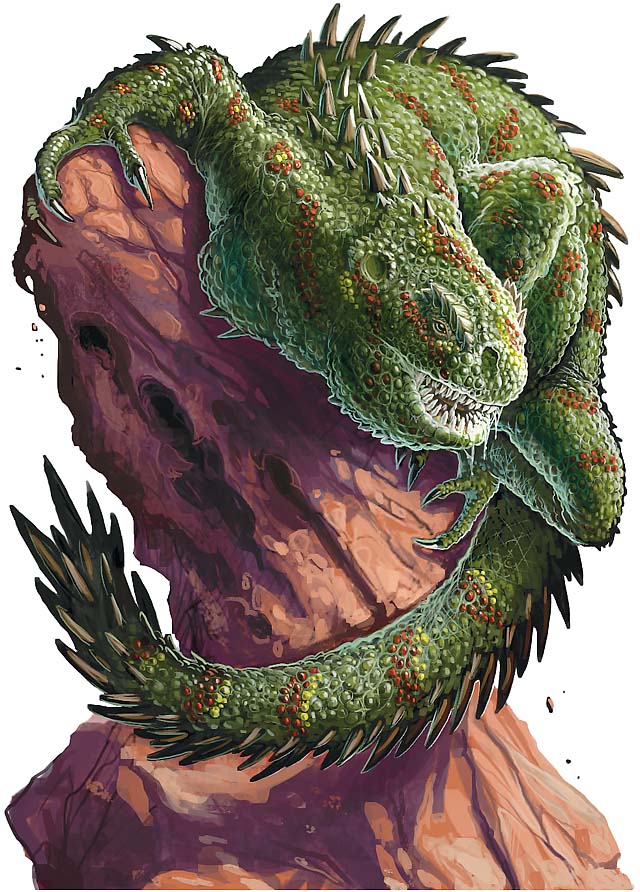
Id Fiend
Large monstrosity, unaligned
- Armor Class 13
- Hit Points 51 (6d10+18)
- Speed 30 ft.
STR DEX CON INT WIS CHA 15 (+2) 12 (+1) 17 (+3) 14 (+2) 12 (+1) 10 (+0)
- Damage Resistances psychic
- Skills Perception +8
- Senses Passive perception 18
- Challenge 5 (1,800 XP)
Psionic Resistance. The id fiend has advantage on psionic saving throws.
Detect Life. The id fiend can sense the presence of living creatures within 120 feet of it.
Danger Sense. The id fiend has psionic advantage on initiative checks and cannot be surprised.
Actions
Multiattack. The id fiend makes three attacks: two claws and one bite.
Claws. Melee Weapon Attack: +4 to hit, reach 5 ft., one target. Hit: 6 (1d6+2) slashing damage.
Bite. Melee Weapon Attack: +4 to hit, reach 5 ft., one target. Hit: 7 (1d8+2) piercing damage.
Psionic fear (recharge 5-6). The id fiend chooses up to 6 targets within 60 feet that it can see. Targets must succeed on a DC 14 Wisdom saving throw or become overwhelmed with their greatest fears for 5 rounds. Affected creatures have disadvantage on attacks, ability checks, and saving throws. A creature cannot be affected by this id fiend's psionic fear more than one time every 24 hours.
Psionic Blast (recharge 4-6). The id fiend targets one creature it can see within 60 feet. That target takes 3d8 psychic damage.
Death Field (recharge 6). The id fiend sacrifices up to half of its hit points (it must leave itself with at least 1 hit point). Every living creature within 20 feet must make a DC 14 Constitution saving throw, taking the amount sacrificed on a failed save, or half as much on a successful one.
Inix
An inix is a large lizard that falls between kanks and mekillots for sheer size. It weighs about two tons and grows to lengths of 16 feet. The inix’s back is protected by a thick shell, while flexible scales cover its underside.
Inixes make spirited mounts. They move at a steady pace for as much as a full day and night without needing rest. lnix riders often travel in howdahs, small boxlike carriages strapped to the lizard’s back. The major drawback to the inix is that it needs large amounts of vegetation and must forage every few hours to maintain its strength. If an inix doesn’t get enough to eat, it becomes nearly impossible to control. For this reason, these lizards aren’t used on trips where forage land is scarce. Inix are also harvested for their shells and flexible underbelly scales to make quality armor.
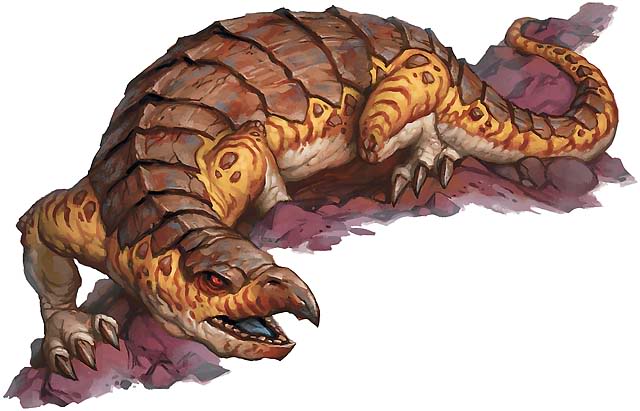
Inix
Huge beast, unaligned
- Armor Class 13
- Hit Points 63 (6d12+24)
- Speed 40 ft.
STR DEX CON INT WIS CHA 24 (+7) 10 (+1) 19 (+4) 3 (-4) 12 (+1) 6 (-2)
- Senses passive Perception 11
- Challenge 3 (700 XP)
Actions
Multiattack. The inix attacks with its tail and bite.
Tail. Melee Weapon Attack: +9 to hit, reach 10 ft., one target. Hit: 11 (1d6+7) bludgeoning damage.
Bite. Melee Weapon Attack: +9 to hit, reach 5 ft., one target. Hit: 12 (1d8+7) piercing damage. If the inix rolls a natural 20 to hit, it does an additional 1d8 damage with its bite.
Jhakar
The jhakar (singular and plural) is a powerful reptilian predator resembling a scaled bulldog. In the wild, the jhakar hunts in small packs that fiercely attack to pull down all but the most formidable prey. However, the creature is better known in cities as a domesticated guard-beast and tracker of escaped slaves. Domestic jhakar are savage and unpredictable creatures, greatly feared by would-be thieves and escaping slaves. They are 4 feet long and weigh 70 to 90 pounds.
The jhakar is often domesticated as a blood-hound or guard-beast. It is an aggressive and stupid creature and has difficulty recognizing its handler from one day to the next. However, it is an excellent tracker, and once on the scent, it never gives up the chase. A wild pack of jhakar hunts a man or an elf as readily as any wild creature. Once they have scented prey, they never give up. Jhakar attack in one bounding rush, hissing like steam-kettles when they catch sight of their prey. The jhakar is a dangerous predator that is not particularly strong as an individual, but extraordinarily dangerous in a pack. Most creatures of the desert give a jhakar pack a wide berth. Tembo are mortal enemies of the jhakar.
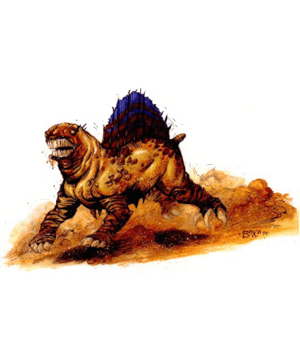
Jhakar
Medium beast, unaligned
- Armor Class 15
- Hit Points 25 (3d8+12)
- Speed 40 ft.
STR DEX CON INT WIS CHA 14 (+2) 15 (+1) 19 (+4) 3 (-4) 12 (+1) 10 (+0)
- Skills Perception +8, Survival +6
- Senses passive Perception 18
- Challenge 1/2 (100 XP)
Pack Tactics. The jhakar has advantage on an attack roll against a creature if at least one of the jhakar's allies is within 5 feet of the creature and the ally isn't incapacitated.
Keen Tracker. The jhakar has advantage on Wisdom checks to track prey.
Actions
Bite. Melee Weapon Attack: +4 to hit, reach 5 ft., one target. Hit: 6 (1d6+2) piercing damage. If the target is a creature, it must succeed on a DC12 Strength saving throw or be knocked prone.
Jozhal
Standing about four feet tall, the jozhal is a small, two-legged reptile wtih thumbs and the ability to shift its scales to match its background. The jozhal live in small family groups of four to five creatures. They are extremely intelligent and cunning, but regard humans or demihumans as foolish, dangerous creatures and will rarely tolerate them.
Jozhals are attracted to magic of all sorts, and whenever they see humans or demihumans passing they track the party down and attempt to cast a detect magic spell on the group. If the spell reveals any magical items, they will try to sneak into camp and steal them.
Jozhals forage for food (roots and tubers), and eat almost any sort of small reptile, snake, or insect. Their magic is elemental and not destructive to the environment around them.
The jozhal clan’s intellect is best reflect in its relationship to the world around it. They are very careful never to destroy the life-giving world in which they live, always making use of every bit of scrap and refuse that they find. They carry this to extremes, even practicing cannibalism and using the bones of their dead to construct weapons and tools.
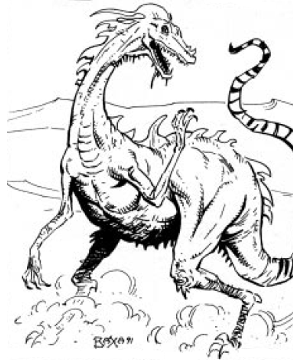
Jozhal
Small monstrosity, chaotic neutral
- Armor Class 16
- Hit Points 18 (4d6+4)
- Speed 30 ft.
STR DEX CON INT WIS CHA 8 (-1) 16 (+3) 12 (+1) 12 (+1) 14 (+2) 10 (+0)
- Saving Throws Intelligence +3, Wis +4
- Skills Stealth +5
- Senses Passive perception 11
- Challenge 1 (200 XP)
Magic and Psionic Resistance. The jozhal has advantage on spell and psionic saving throws.
Chameleon Skin. The jozhal can change its skin color to match its surroundings and has advantage on Stealth checks to hide.
Spellcasting. The jozhal is a 5th level cleric (spell save DC 12, +4 to hit with spells). The jozhal may cast the following spells once per day and cannot cast spells in a higher level slot:
1st level: cure wounds, detect magic, detect poison and disease
2nd level: flame blade, hold person, locate object, silence
3rd level: dispel magicActions
Bite. Melee Weapon Attack: +4 to hit, reach 5 ft., one target. Hit: 8 (1d8+3) piercing damage.
Psionic Blast (recharge 5-6). The jozhal targets one creature it can see within 60 feet. That target takes 2d8 psychic damage.
Dimensional Leap (recharge 6). The jozhal psionically creates a dimension door effect, self only.
Planar Shift (1/day). The jozhal psionically creates a banishment effect, DC 12 saving throw.
Kank
Kanks are large docile insects often used as mounts by the people of the Tablelands and one of the most important animals, used for nearly every aspect of survival. A black exoskeleton of chitin covers their segmented bodies. They weigh as much as 400 pounds, grow to heights of 4 feet at the back, and as long as 8 feet from head to abdomen. Around their mouths they have multi-jointed pincers that they can use to carry objects, feed themselves, or fight. Six lanky legs descend from their thoraxes. Each ends in a single flexible claw that allows them to grip the surfaces they walk upon.
Kanks are often used as caravan mounts. Kanks make decent herd animals, but usually only elves employ them as such. As kanks can digest almost any sort of organic matter, they can thrive in most terrain types. In addition, these creatures require little special attention. A kank hive instinctively organizes itself into food producers, soldiers, and brood queens. Humans and demihumans can live exclusively on their nectar for up to three weeks before their bodies begin demanding other sources of nutrition, such as meats and vegetables. The sweet taste of the nectar is the only thing that attracts herders to these creatures, and domesticated kanks produce more globules than those living in the wild.
While the globules of honey produced by kanks are sweet and good tasting, only the most desperate carrion eater will consume kank flesh. When a kank dies, its body produces chemicals that drench the meat with a foul-smelling odor that can make even the hungriest giant sick.
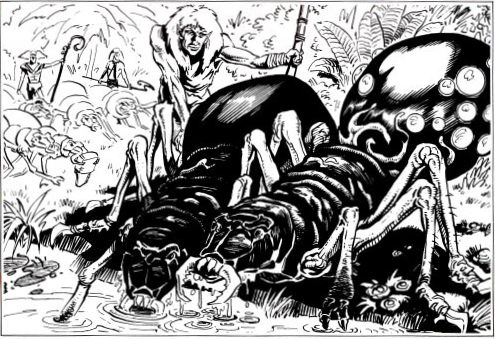
Kank, drone
Large beast, unaligned
- Armor Class 14
- Hit Points 17 (2d10+6)
- Speed 40 ft.
STR DEX CON INT WIS CHA 16 (+3) 13 (+1) 17 (+3) 2 (-4) 12 (+1) 6 (-2)
- Senses passive Perception 11
- Challenge 1/4 (50 XP)
Actions
Bite. Melee Weapon Attack: +3 to hit, reach 5 ft., one target. Hit: 7 (1d6+3) piercing damage and target must make a DC 10 Constitution saving throw or be poisoned for 1 minute. If the save is failed by 5 or more, the target is also paralyzed. The target may make a saving throw at the end of its turns to end the paralyzation.
Kank, soldier
A soldier kank has the above stats but attacks at +5 and is CR 1/2 (100 XP).
Kirre
The kirre is one of the more vicious animals of the forests and jungles of Athas. At first glance, the kirre looks like a great cat, but upon closer examination, the differences quickly become clear. The kirre is eight feet in length and has eight legs, each ending in paws which sport very sharp claws. The kirre also has large horns on either sides of its head and a sharp barbed tail spike often used as a weapon. The mouth of the kirre is large and has sharp, canine teeth, which are used mostly for tearing food that has been killed. The kirre is a fur-covered animal striped in brown and grey. This coloration is consistent all over the kirre’s body, with the exception of its face, which is all grey.
They are cautious hunters, adjusting tactics from silent ambushes to chirping and growling to unnerve prey so it wastes energy fleeing. They are also naturally skilled in psionics.
Kirre are solitary creatures until mating and raising young. They are a favorite game of many hunting tribes of races who live in the forests of Athas. The meat from kirres is some of the finest on all of Athas, and it is sought after by many. Aside from a source of food, the creature’s horns can be cut off and used as spear heads; in some cases, they can be carved into ornate daggers. Also, the tail of a kirre has a sharp, bone spike at its end that can be fashioned into either an arrow head or a dart.
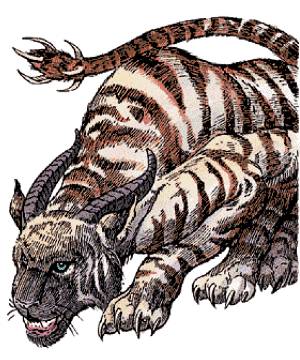
Kirre
Large beast, unaligned
- Armor Class 12
- Hit Points 37 (7d10+14)
- Speed 40 ft.
STR DEX CON INT WIS CHA 17 (+3) 15 (+2) 15 (+2) 2 (-4) 12 (+1) 6 (-2)
- Damage Resistances psychic
- Skills Stealth +4
- Senses passive Perception 11
- Challenge 3 (700 XP)
Detect Life. The kirre can sense the presence of living creatures within 120 feet of it.
Actions
Multiattack. The kirre makes four attacks: two claws, a bite, and tail.
Claws. Melee Weapon Attack: +5 to hit, reach 5 ft., one target. Hit: 5 (1d4+3) slashing damage.
Bite. Melee Weapon Attack: +5 to hit, reach 5 ft., one target. Hit: 8 (1d8+3) piercing damage.
Spiked Tail. Melee Weapon Attack: +5 to hit, reach 5 ft., one target. Hit: 7 (1d6+3) piercing damage.
Psionic Blast (recharge 6). The kirre targets one creature it can see within 60 feet. That target takes 2d8 psychic damage.
Awe (recharge 6). The kirre can cause each creature of its choice within 120 feet of it and visible to the kirre to make a DC 11 Wisdom saving throw or become frightened for 1 minute. A creature can repeat the saving throw at the end of its turns to end the effect.
Klar
The klar looks much like a large kodiak bear with a head that seems a little too large for the body. Its back is covered with a chitinous plate It has a thick, stump of a tail that aids its balance when it stands erect. Its thick, sandy-colored fur grows as much as six inches long.
Klars communicate with each other through loud growls, though they use their psionics when they wish to be silent or contact each other over great distances. They have never attempted to speak with humans or demihumans, assuming them to be too stupid to understand a klar. The few who have bothered to investigate the town of Salt View are beginning to change their views about the humans and their kind. Several psionicists have contacted klar and were able to communicate before being ripped to shreds.
The klar is not particularly territorial. It is confident enough to know it can find a home anywhere in the mountains by killing other cave-dwellers. In the first several years of a klar's life, its intense psionic potential tends to overpower its young, untrained mind. As a result, the klar grow particularly fierce when trespassers invade while the young are maturing. The klar fears that moving the den will upset the youth.
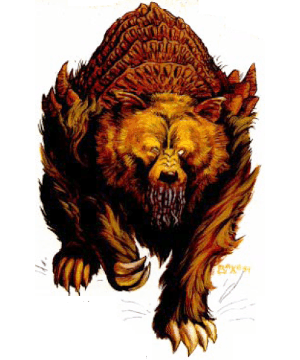
Klar
Large beast, unaligned
- Armor Class 17 (natural)
- Hit Points 105 (11d10+44)
- Speed 40 ft., climb 30 ft.
STR DEX CON INT WIS CHA 21 (+5) 12 (+1) 18 (+4) 6 (-2) 13 (+1) 8 (-1)
- Senses passive Perception 10
- Challenge 6 (2,300 XP)
Actions
Multiattack. The klar makes a claw and bite attack.
Claw. Melee Weapon Attack: +8 to hit, reach 5 ft., one target. Hit: 10 (1d8+5) slashing damage.
Bite. Melee Weapon Attack: +8 to hit, reach 5 ft., one target. Hit: 11 (1d10+5) piercing damage.
Ego Whip (recharge 6). One visible target within 60 ft. must make a DC 12 Intelligence saving throw or take 2d8 psychic damage and be filled with self-doubt, leaving it unable on its next turn to take any action except Dodge, Disengage, or Hide. On a successful saving throw, it takes half as much damage.
Domination (1/day). One target within 60 ft. must succeed on a DC 12 Wisdom saving throw or be charmed by the klar for 10 minutes, with advantage if it or its allies are fighting the klar. The klar may issue telepathic commands to choose the target's actions. If no action is issued, the target dodges. If the target takes damage, it may attempt another save to end the effect.
Reactions
Inertial Barrier (3/day). When taking acid, cold, fire, lightning, or thunder damage, it can use its reaction to gain resistance to damage of that type—including the triggering damage— until the end of its next turn.
Kluzd
Kluzd are snake-like reptiles that inhabit mudflats and other muddy areas. They are about ten feet long and two to three feet in diameter. They can swallow a grown man whole, although this results in a strange, almost comical, bulge in the center of their bodies. Male kluzd have a distinctive turquoise and white coloration about their head and neck area. Females do not share these bright colors; their bodies are sandy brown flecked with black along their entire length. All kluzd have a series of elongated, feather-like scales around the back of their heads. These flare out to form a large fan when the creature is angered, a primitive mechanism to make it appear larger to its animal opponents.
Most often, the kluzd is well-protected by its muddy environment; few native predators can submerge themselves in the thick muck to hunt them. Kluzd will only leave the safety of their mud pools when these areas dry out completely. The creatures are far more vulnerable when forced onto the surface of the mud flat. A kluzd will travel in a straight line away from its evaporated burrow in search of a new one – those that don’t locate a new mud hole within four days will themselves dry out and perish.
In combat, the kluzd attemps to constrict its foe and pull it under the mud where the foe begins to suffocate.
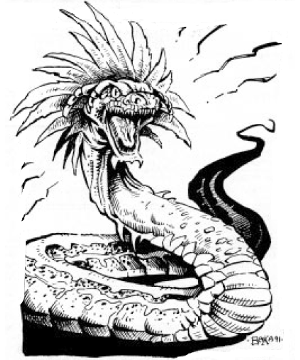
Kluzd
Large beast, unaligned
- Armor Class 12
- Hit Points 30 (4d10+8)
- Speed 30 ft., burrow (mud only) 30 ft.
STR DEX CON INT WIS CHA 17 (+3) 14 (+2) 14 (+2) 1 (-5) 10 (+0) 3 (-4)
- Skills Stealth +9
- Senses Passive perception 10, tremorsense 10 ft.
- Challenge 1/2 (100 XP)
Submerge. A kluzd in mud has three-quarters cover when ambushing, half cover when fighting, and full cover if it burrows.
Actions
Bite. Melee Weapon Attack: +5 to hit, reach 10 ft., one target. Hit: 9 (1d10+3) piercing damage.
Constrict. Melee Weapon Attack: +5 to hit, reach 5 ft., one target. Hit: 11 (2d6+3) bludgeoning damage. The target is grappled (escape DC 14). Until this grapple ends, the creature is restrained and the kluzd can't constrict another target.
Lirr
The lirr is a large, warm-blooded feline-shaped reptile. It possesses bright, multi-colored plumage that it uses for silent communication. The lirr has a long, sleek, dark gray body. Its scales are small and fine, almost like those of a snake's. Around its neck and at the end of its tail sit rings of a weblike membrane. Colored brilliant red, yellow, and orange, these rings normally lie flat against the creature's scales. When prey is sighted, however, the membrane fills with air, puffing up to alert other lirr that quarry is nearby. The first move a lirr in combat is not to damage but to immobilize with their roar.
Lirr live and hunt in packs, and every two years will lay a clutch of eggs. Lirr are generally found in the Tablelands but there is a varietal with muted colors that exist in the mountains. They stand 4 feet high and 6 feet long, weighing 400 to 500 pounds.
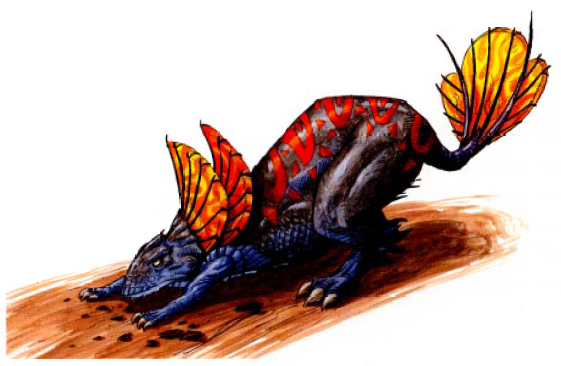
Lirr
Large beast, unaligned
- Armor Class 14
- Hit Points 38 (5d10+10)
- Speed 40 ft.
STR DEX CON INT WIS CHA 17 (+3) 15 (+2) 14 (+2) 2 (-4) 12 (+1) 6 (-2)
- Skills Athletics +10, Stealth +9
- Senses passive Perception 11
- Challenge 2 (100 XP)
Pounce: If the lirr moves at least 20 ft. straight toward a creature and then hits it with a claw Attack on the same turn, that target must succeed on a DC 13 Strength saving throw or be knocked prone. If the target is prone, the lirr can make one bite Attack against it as a Bonus Action.
Running Leap: With a 10-foot running start, the lirr can long jump up to 30 ft. or vertically leap up to 15 ft.
Actions
Claw. Melee Weapon Attack: +5 to hit, reach 5 ft., one target. Hit: 5 (1d4+3) slashing damage.
Bite. Melee Weapon Attack: +5 to hit, reach 5 ft., one target. Hit: 8 (1d8+3) piercing damage.
Stunning Roar. (recharge 5-6). A lirr can unleash a devastating roar in a 20' cone. Any creature that can hear the roar in the area of effect must make a DC 11 Wisdom save or be stunned for one round.
Mastyrial
The mastyrial lives in the desert regions of Athas, spending most of its time hibernating beneath the sands. It resembles an oversized scorpion. The creature propels itself using its six legs and has large jagged claws and a tail that makes up most of its length. The mastyrial is deep brown to orange-red and has a striped pattern on its back that resembles drifting sand when viewed from a distance. This affords the beast a form of camouflage if gusting wind uncovers its top while in a deep state of sleep. The mastyrial sometimes lacks any pigment at all. The mastyrial has two areas of darker skin on its head that resemble eyes. Its real eyes are smaller and farther forward on the creature's head. The mastyrial spends most of its life underground and relies on its other senses, particularly its hearing. The mastyrial emits clicking sounds that allow it to determine the direction and distance of the nearest prey. Other than the clicking sounds and the sounds made when in motion, this fell beast is completely silent and seems almost supernatural in combat. They are 9 feet long and weigh 800 pounds.
Mastyrials are solitary creatures, mating once in life wherein the male voluntarily accepts being stung to death by the female to provide a meal for the clutch. The mastyrial acts as a form of pest control in the deserts of Athas by eating various insects and vermin. The chitinous shell of the mastyrial is valued by warriors for its protective qualities and its ventilation. The shell is frequently used as material in shields and armor. The poison is also highly sought by both defilers and assassins.
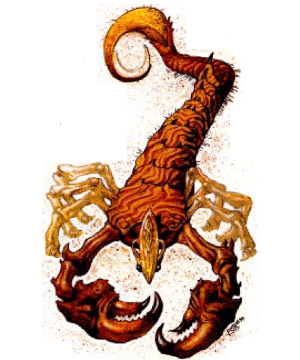
Mastyrial
Large beast, unaligned
- Armor Class 19
- Hit Points 90 (12d10+24)
- Speed 30 ft., burrow 15 ft.
STR DEX CON INT WIS CHA 20 (+5) 11 (+0) 14 (+2) 2 (-4) 10 (+0) 7 (-2)
- Senses Tremorsense 30 ft., passive Perception 10
- Challenge 8 (3,900 XP)
Regeneration. The mastyrial regains 3 hit points at the start of its turn. A mastyrial reduced to 0 hit points does not regenerate.
Actions
Multiattack. The masytrial makes three attacks: claws, bite, and tail sting.
Claws. Melee Weapon Attack: +8 to hit, reach 5 ft., one target. Hit: 12 (2d8+5) slashing damage.
Bite. Melee Weapon Attack: +8 to hit, reach 5 ft., one target. Hit: 11 (1d10+5) piercing damage.
Tail sting. Melee Weapon Attack: +8 to hit, reach 10 ft., one target. Hit: 9 (1d6+5) piercing damage. The target must make a DC 16 Constitution saving throw, taking 24 (7d6) poison damage on a failed save, or half as much damage on a successful one.
Megapede
Megapedes are colossal centipedes which roam the sandy deserts of Athas. Theyre are very similar to normal centipedes in all ways except in size. They have a very long (100 to 150 feet), segmented body which sports a pair of legs nearly every two feet. These legs are five feet in length and have flexible claws at their ends. The body of a megapede is covered with a fur-covered, bulbous skin which serves as a pseudo-exoskeleton.
The megapedes of Athas are, with the exceptions of the Dragon and Nightmare Beasts, the most dangerous feature of traveling across the deserts of this harsh world. Because of their sheer size, megapedes cannot normally hide their presence. Most, however, live beneath the sands of the desert, only surfacing to feed on unfortunate passers-by. Herds of erdlus and even kanks are among the favorite foods of megapedes, though they often survive on vegetation alone for weeks on end.
Although the megapede has powerful psionics, including death field, it reacts instinctively and to self-preserve.
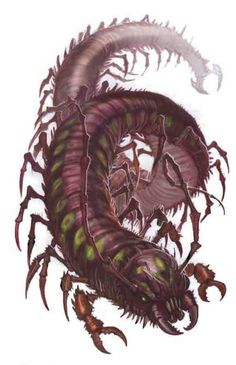
Megapede
Gargantuan beast, unaligned
- Armor Class 16
- Hit Points 145 (10d20+40)
- Speed 30 ft.
STR DEX CON INT WIS CHA 22 (+6) 14 (+2) 18 (+4) 1 (-5) 7 (-2) 3 (-4)
- Senses blindsight 30 ft., passive Perception 10
- Challenge 15 (13,000 XP)
Psionic Resistance. The megapede has advantage on saving throws against psionic effects.
Energy containment. When taking damage from acid, cold, fire, lightning, or thunder, the megapede can use its reaction to take half damage from that instance of damage.
Actions
Multiattack. The megapede makes five claw attacks and one bite, or two psionic effects.
Claws. Melee Weapon Attack: +10 to hit, reach 10 ft., one target. Hit: 13 (2d6+6) slashing damage.
Bite. Melee Weapon Attack: +10 to hit, reach 15 ft., one target. Hit: 23 (3d10+6) piercing damage plus 10 (3d6) poison damage.
Ego Whip. One visible target within 60 ft. must make a DC 18 Intelligence saving throw or take 3d8 psychic damage and be filled with self-doubt, leaving it unable on its next turn to take any action except Dodge, Disengage, or Hide. On a successful saving throw, it takes half as much damage.
Psionic Blast (recharge 5-6). The megapede targets one creature it can sense within 60 feet. That target takes 4d8 psychic damage.
Death Field (recharge 6). The megapede sacrifices up to half of its hit points (it must leave itself with at least 1 hit point). Every living creature within 20 feet must make a DC 18 Constitution saving throw, taking the amount sacrificed on a failed save, or half as much on a successful one.
Death Field
A creature with higher intelligence with the megapede's hit points might tend to risk itself to eliminate enemies, but the megapede's intelligence limits such advanced tactics. The megapede will only sacrifice up to 40 hit points.
Mekillot
Mekillots are mighty lizards weighing up to six tons. They have huge, mound-shaped bodies growing to lengths of 30 feet. A thick shell covers the back and head of a mekillot, providing protection from the sun and good defense against attacks.
Mekillots have savage dispositions, but their size and great strength make them excellent caravan beasts. A hitched pair of mekillots can pull a wagon weighing up to 20 tons at a slow, plodding pace. Caravan leaders must be prepared for their unpredictable natures, however. As they can never be truly tamed, the stubborn creatures have been known to turn off the road and go wandering for no apparent reason, still drawing their loaded wagons. Mekillots are also noted for eating their handlers and other members of a caravan team. Psion handlers are best equipped to deal with these difficult beasts.
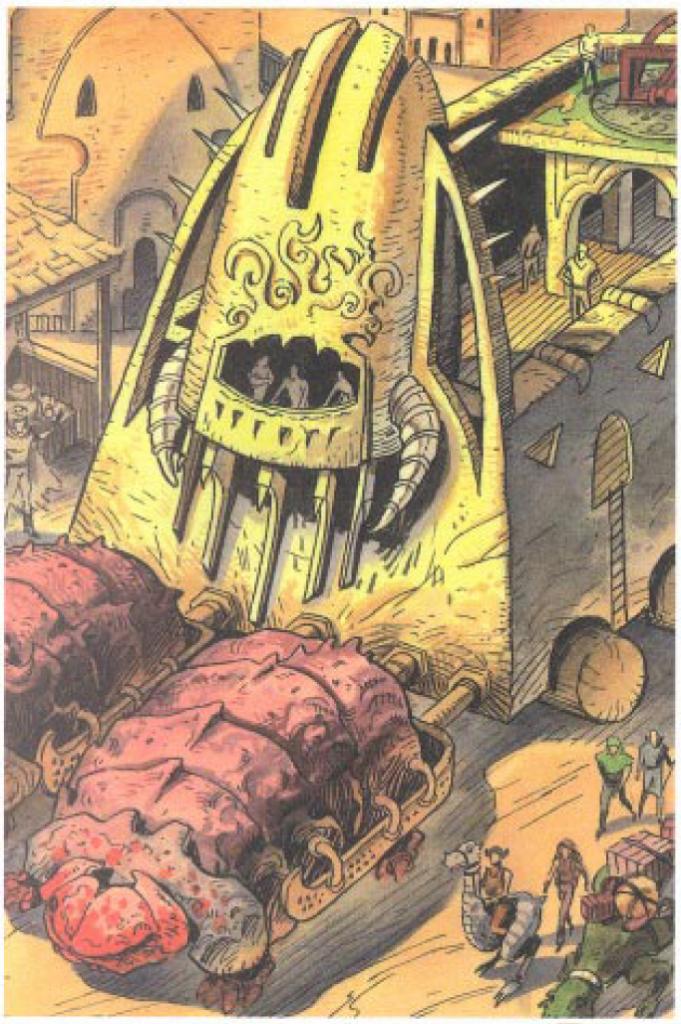
Mekillot
Gargantuan beast, unaligned
- Armor Class 13
- Hit Points 171 (11d20+55)
- Speed 25 ft.
STR DEX CON INT WIS CHA 28 (+9) 10 (+1) 20 (+5) 2 (-4) 13 (+1) 7 (-2)
- Saving Throws Constitution +8
- Senses passive Perception 11
- Challenge 7 (2,900 XP)
Trampling Charge. If the mekillot moves at least 20 ft. straight toward a creature and then hits it with a bite attack on the same turn, that target must succeed on a DC 19 Strength saving throw or be knocked prone.
Actions
Bite. Melee Weapon Attack: +11 to hit, reach 10 ft., one target. Hit: 22 (2d6 + 9) piercing damage. If the target is a Large or smaller creature, it must succeed on a DC 19 Dexterity saving throw or be swallowed by the mekillot. A swallowed creature is blinded and restrained, it has total cover against attacks and other effects outside the mekillot, and it takes 10 (3d6) acid damage at the start of each of the mekillot's turns. If the mekillot takes 30 damage or more on a single turn from a creature inside it, the worm must succeed on a DC 21 Constitution saving throw at the end of that turn or regurgitate all swallowed creatures, which fall prone in a space within 10 feet of the beast. If the mekillot dies, a swallowed creature is no longer restrained by it and can escape from the corpse by using 20 feet of movement, exiting prone.
A mekillot's gullet can hold up to 1 large creature, or 2 medium, or 4 small creatures at a time.
Plants of Athas
Not monsters in the traditional sense, the plants of Athas can often be as dangerous an obstacle as any creature.
Blossomkiller (CR 1/4)
A single blossomkiller plant occupies an area with a radius of up to 45 feet. The roots and vines of this plant stretch across the area, between, in, and around any other nearby plants. The stalk of a blossomkiller is the size of a large tree trunk, but as it grows it lays flat down on the ground, where it spreads out in all directions. Its tendrils branch out from the roots and await victims, luring animals with attractive yellow flowers and the promise of nourishment.
When a victim steps on any of the plant’s roots, the flowers shoot a spray of quills in all horizontal directions (recharge 1 minute), entirely covering the area occupied by the plant, at +7 attack for 1d6 piercing damage and the target must succeed on a DC 13 Constitution saving throw or be poisoned for 10 minutes. If the saving throw is failed by 5 or more, the target is also paralyzed and may make a saving throw at the end of its turns to end the effect. Paralyzed victims are targeted by the blossomkiller's tendrils (AC 10, 3 hit points), which wrap around the victim and begin to suffocate it. The entire plant is AC 6 and has 60 hit points.
Brambleweed (CR 0)
Brambleweed grows as a thick, twisted, tangled mass of leafless, thorny brown-grey vines that do not burn. Many a creature has found death trying to reach a goal that lies on the other side of the tangled brambleweed mass. Death usually results from impalement or deep, bloodletting cuts caused by the thousands of razor-sharp thorns.
A creature that starts its turn in brambleweed takes 5 slashing damage. A creature that enters or ends its turn in brambleweed is restrained until the start of its next turn.
Dew Frond (CR 1/8 to 1/2)
Dew fronds are found in the jungle areas of Athas, where they easily blend in with the tropical surroundings and foliage. The fronds of this plant are usually encountered in groups of four, all growing out of a single stalk. A young plant has a radius of approximately 4 feet and is three to four feet tall. As it feeds on blood using barbed fronds, a dew frond plant grows at an alarming rate up to 15 feet high and 20 feet in radius.
As a creature passes within 5 feet, the frond lashes out at +1 to hit and 1d6 slashing damage for every 3 feet of height (a 15 foot high frond would attack at +5 for 5d6 damage). The frond's barbs also cause the target to be grappled (DC 10 +1 every 3 feet of height). A frond has AC 6 and 10 hit points per 3 feet of height.
Poisonweed (CR 2)
Poisonweed is found within the forest areas of Athas. Along the roots of this weed grow large, beautiful flowers, bearing bright orange-colored petals and light green-tinted leaves. The flowers of a poisonweed plant are from four to six inches in diameter and are very hard to miss. A single poisonweed plant will bear up to 30 flowers, which are spread over a 20 foot radius.
As a victim touches or brushes against a flower, it releases a 15 foot radius cloud of poison into the air that lingers for 10 minutes. Affected creatures must succeed on a DC 10 Constitution saving throw or fall asleep. At the end of each of its turns, a creature may attempt another saving to end the sleep effect. If still within the cloud, the save is made with disadvantage. Affected creatures are targeted by the poisonweed's roots which wrap around a victim and corrode it, dealing 1d10 acid damage at the start of the poisonweed's turn.
A poisonweed plant is AC 6 and has 50 hit points. Each time it is damaged, it disperses another cloud of poison dust (at the point of impact, or if an area effect, randomly). If defiling effects are used, the poisonweed is unable to disperse its clouds until the start of its next turn.
Strangling Vine (CR 1)
trangling vines are roughly 25 feet in length, usually stretched between three or four trees, most often crossing over footpaths and trails in the forest. The vines have approximately ten leaves per five-foot section; these leaves conceal sharp thorns. The stalk of a strangling vine is brownish-green in color, while the leaves are a shiny, moss-like, deep green. A strangling vine usually lies drooping between trees, waiting for a victim to pass by. As a suitable prey passes beneath the vine, it will drop suddenly and wrap itself around the prey’s neck. It will then attempt to pull the victim off the ground, hanging it until it dies.
When a creature passes below it, the vine strikes at +4 attack for 1d10 points of piercing damage and the target is grappled (escape DC 16). A grappled target takes 1d6 points of piercing damage at the start of the vine's turn.
A vine can be severed (AC 10, 2 hit points), and the entire plant has 30 hit points.
Psurlon
Psurlons are extremely intelligent wormlike humanoids encountered only when summoned form the Astral Plane to Athas. Their race destroyed their home world with psionics and they have since existed on the Astral Plane, curious with Athas because it may be able to handle their psionic use.
Psurlons have 5 foot tall, 7 foot long, earthwormlike bodies, legs that end in toothed maws, and arms that end in claws with black talons. Their heads are similar to those of earthworms, with large, gaping maws ringed with teethlike projections. They have no eyes and use other senses to “see”. They wear richly colored robes and never wear armor or carry weapons, instead having enhanced their bodies through centuries of psionic manipulation. Psurlons communicate with one another telepathically and through grunts and squeals.
Psurlons normally feed on the flesh of living creatures, especially that of other sentient races. They particularly like human and halfling flesh. The typical lifespan of a psurlon is 1,500 years. They are at the top of the food chain and are seldom preyed upon. Athasian rocs consider psurlons a delicacy, but fortunately for the psurlons there are no rocs on the Astral Plane.
Some evil psionicists summon psurlons in hopes of gaining their knowledge. The price is very high and often leads to the death of the summoner. Summoners who gain knowledge from psurlons and then attempt to slay them or send them back are tracked down and forced to pay what is due either by the psurlons they summoned or by others of their race.
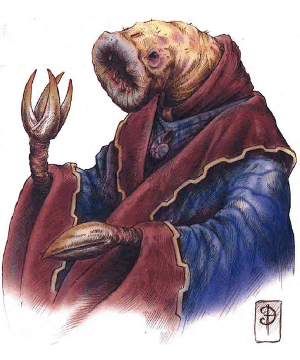
Psurlon
Medium aberration, lawful evil
- Armor Class 15 (natural)
- Hit Points 46 (7d8+14)
- Speed 20 ft.
STR DEX CON INT WIS CHA 14 (+2) 11 (+0) 14 (+2) 18 (+4) 17 (+3) 16 (+3)
- Saving Throws Int +7, Wis +6, Cha +6
- Damage Resistances bludgeoning, piercing, and slashing from nonmagical attacks
- Condition Immunities charmed, paralyzed, sleep
- Skills Insight +6, Perception +6
- Senses tremorsense 60 ft., passive Perception 16
- Languages Telepathy one visible target in 120'
- Challenge 5 (1,800 XP)
Magic and Psionic Resistance. The psurlon has advantage on saving throws against magical and psionic effects.
Actions
Multiattack. The psurlon makes two claws and a bite attack.
Claws. Melee Weapon Attack: +5 to hit, reach 5 ft., one target. Hit: 7 (1d10+2) slashing damage.
Bite. Melee Weapon Attack: +5 to hit, reach 5 ft., one target. Hit: 11 (2d8+2) piercing damage.
Ego Whip. One visible target within 60 ft. must make a DC 15 Intelligence saving throw or take 3d8 psychic damage and be filled with self-doubt, leaving it unable on its next turn to take any action except Dodge, Disengage, or Hide. On a successful saving throw, it takes half as much damage.
Id Insinuation (recharge 5-6). One visible target within 60 ft. must make a DC 15 Intelligence saving throw or be confused for 1d4 rounds.
Life Drain (recharge 5-6). A living target within 60 ft. that the psurlon can see must make a DC 15 Constitution saving throw or lose 1d6 hit points. This amount is transferred to the psurlon, healing it. It can have up to 10 hit points over its hit point maximum in this way as temporary hit points.
Psychic Crush (1/day). Creates a 20-foot cube, range 120 feet. Those in area must make a DC 15 Intelligence save or take 8d8 psychic damage and be stunned until the end of the psurlon's next turn. A target takes half as much damage on a successful save.
Giant Psurlon
Giant psurlons are mutated psurlons, 14 feet tall and 20 feet long, who existed when their kind destroyed their world. They absorbed so much psionic energy when their world was destroyed that they became nearly immortal and they grew in size and psionic ability. Only a handful of these creatures are left. These creatures make their own solitary dens upon the Astral Plane and have little contact with others, including those of their own kind, since other psurlons consider them cursed monsters.
There are a few, however, who have taken control of small psurlon communities, ruling them as harshly as any sorcerer king ever ruled. Giant psurlons can attack with their claws and bite but they seldom need to do so.
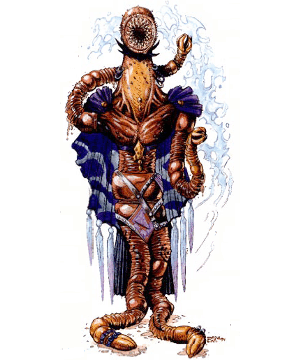
Giant Psurlon
Huge aberration, neutral evil
- Armor Class 19 (natural)
- Hit Points 158 (15d12+60)
- Speed 30 ft., levitate 30 ft.
STR DEX CON INT WIS CHA 18 (+4) 11 (+0) 18 (+4) 18 (+4) 17 (+3) 16 (+3)
- Saving Throws Int +8, Wis +7, Cha +7
- Damage Resistances bludgeoning, piercing, and slashing from nonmagical attacks
- Condition Immunities charmed, paralyzed, sleep
- Skills Insight +7, Perception +7
- Senses tremorsense 60 ft., passive Perception 17
- Languages Telepathy one visible target in 120'
- Challenge 15 (13,000 XP)
Magic and Psionic Resistance. The psurlon has advantage on saving throws against magical and psionic effects.
Danger Sense. The psurlon has psionic advantage on initiative checks and cannot be surprised.
Actions
Multiattack. The psurlon makes two claws and a bite attack, or one claw attack and one psionic ability.
Claws. Melee Weapon Attack: +8 to hit, reach 10 ft., one target. Hit: 15 (2d10+4) slashing damage.
Bite. Melee Weapon Attack: +8 to hit, reach 10 ft., one target. Hit: 21 (3d10+4) piercing damage.
Ego Whip. One visible target within 60 ft. must make a DC 16 Intelligence saving throw or take 4d8 psychic damage and be filled with self-doubt, leaving it unable on its next turn to take any action except Dodge, Disengage, or Hide. On a successful saving throw, it takes half as much damage.
Id Insinuation. One visible target within 60 ft. must make a DC 16 Intelligence saving throw or be confused for 1d4 rounds.
Life Drain (recharge 5-6). A living target within 60 ft. that the psurlon can see must make a DC 16 Constitution saving throw or lose 2d6 hit points. This amount is transferred to the psurlon, healing it. It can have up to 10 hit points over its hit point maximum in this way as temporary hit points.
Psychic Crush (recharge 6). Creates a 20-foot cube, range 120 feet. Those in area must make a DC 16 Intelligence save or take 8d8 psychic damage and be stunned until the end of the psurlon's next turn. A target takes half as much damage on a successful save.
Disintegrate (1/day). As a psionic effect, DC 16 save.
Pterran
Pterrans are a race of lizard men who inhabit the Hinterlands near the Ringing Mountains. Pterrans look more like humanoid pteranodons than they do lizards, indicating that they may be related in some way to the pterrax. Standing roughly six feet tall, pterrans have light brown scales for skin. There are no obvious characteristics which distinguish males from females under normal circumstances.
The language of pterrans is a collection of vocal sounds that are combined with clicks and taps made with their claws. The vocal sounds of the pterrans are largely hisses and pops, with occasional snarls or growls, making it near impossible for many races to duplicate. Pterrans are naturally suspicious of men, particularly of humans and halflings.
Pterrans gather in tribes, ranging in size from 12 members to over a hundred in larger ones. Pterran society is based largely on ceremony and celebrations. Pterrans believe that their race originated from the very earth itself and that Athas is their Earth Mother. With each celebration, the pterran tribes reinforce their beliefs and faith. As would be expected, the priests of pterran society are druids.
A pterran tribe is led by its Triumvirate, which is comprised of the eldest tribal member from each Life Path (chosen when a pterran turns 15): warrior, druid, or psion. The Triumvirate is responsible for most of the tribe’s decisions, though the entire tribe is consulted before actions of any kind are taken. Typical decisions of the Triumvirate include when to move the village to a new location, when and where to send out scouting groups, whether the tribe should involve themselves with other Athasian races, etc.
They make their own weapon from wood including the thanak, a sawblade they coat with poison.
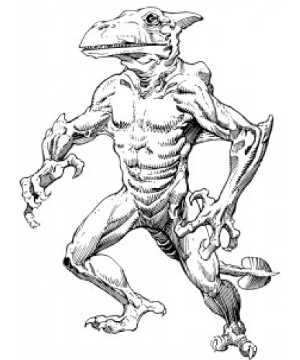
Pterran warrior
Medium humanoid (pterran), neutral
- Armor Class 11
- Hit Points 26 (4d8+8)
- Speed 30 ft.
STR DEX CON INT WIS CHA 14 (+2) 12 (+1) 14 (+2) 11 (+0) 12 (+1) 10 (+0)
- Skills Stealth +3
- Senses passive Perception 11
- Challenge 1 (200 XP)
Camouflage. The pterran's coloration gives it advantage on Stealth checks when in a forested setting.
Actions
Multiattack. The pterran makes one claw or weapon attack and one bite attack.
Claw. Melee Weapon Attack: +4 to hit, reach 5 ft., one target. Hit: 3 (1d4+2) slashing damage.
Bite. Melee Weapon Attack: +4 to hit, reach 5 ft., one target. Hit: 5 (1d6+2) piercing damage.
Thanak. Melee Weapon Attack: +4 to hit, reach 5 ft., one target. Hit: 10 (2d6+2) slashing damage and the target must succeed on a DC 12 Constitution saving throw or be poisoned for one minute. The poison dose is used up after one hit.
Spear. Melee Weapon Attack: +4 to hit, reach 5 ft. or range 20/60 ft., one target. Hit: 6 (1d6+2) piercing damage or 7 (1d8+2) if wielded with two hands, and the target must succeed on a DC 12 Constitution saving throw or be poisoned for one minute. The poison dose is used up after one hit.
Pterran Tactics
When possible, pterran fight from the air, mounted on pterrax, and pepper foes with spears and psionic attacks from afar. They have no concept of fighting fair.
Pterran psion
Medium humanoid (pterran), neutral
- Armor Class 11
- Hit Points 26 (4d8+8)
- Speed 30 ft.
STR DEX CON INT WIS CHA 11 (+0) 12 (+1) 14 (+2) 14 (+2) 12 (+1) 10 (+0)
- Skills Stealth +3
- Senses passive Perception 11
- Challenge 1 (200 XP)
Camouflage. The pterran's coloration gives it advantage on Stealth checks when in a forested setting.
Danger Sense. The pterran has psionic advantage on initiative checks and cannot be surprised.
Detect Life. The pterran can sense the presence of living creatures within 120 feet of it.
Actions
Multiattack. The pterran makes one claw and bite attack.
Claw. Melee Weapon Attack: +3 to hit, reach 5 ft., one target. Hit: 3 (1d4+1) slashing damage.
Bite. Melee Weapon Attack: +3 to hit, reach 5 ft., one target. Hit: 5 (1d6+1) piercing damage.
Id Insinuation (recharge 4-6). One visible target within 60 ft. must make a DC 12 Intelligence saving throw or be confused for 1d4 rounds.
Ego Whip (recharge 5-6). One visible target within 60 ft. must make a DC 12 Intelligence saving throw or take 1d8 psychic damage and be filled with self-doubt, leaving it unable on its next turn to take any action except Dodge, Disengage, or Hide. On a successful saving throw, it takes half as much damage.
Pterran druid
Medium humanoid (pterran), neutral
- Armor Class 11
- Hit Points 26 (4d8+8)
- Speed 30 ft.
STR DEX CON INT WIS CHA 11 (+0) 12 (+1) 14 (+2) 11 (+0) 14 (+2) 10 (+0)
- Skills Stealth +3
- Senses passive Perception 13
- Challenge 1 (1,800 XP)
Camouflage. The peterran's coloration gives it advantage on Stealth checks when in a forested setting.
Spellcasting. The pterran is a 4th level druid (spell save DC 12, +4 to hit with spells). The pterran has the following spells prepared:
Cantrips (at-will): druidcraft, poison spray, produce flame, thorn whip
1st level (4 slots): healing word, speak with animals, thunderwave
2nd level (3 slots): moonbeam, spike growthActions
Multiattack. The pterran makes one claw and bite attack.
Claw. Melee Weapon Attack: +3 to hit, reach 5 ft., one target. Hit: 3 (1d4+1) slashing damage.
Bite. Melee Weapon Attack: +3 to hit, reach 5 ft., one target. Hit: 5 (1d6+1) piercing damage.
Wild Shape. The pterrax turns into a jhakar or soldier kank for up to 2 hours and can revert to humanoid shape with a bonus action.
Pterrax
Pterrax are large flying lizards commonly used as mounts by pterrans. They occupy the plains and rocky barrens of Athas. They are generally six feet long, with a reptilian appearance, sporting 20 foot wide wings and weighing several hundred pounds. The head of a pterrax is similar in shape to that of pterran, suggesting that the two species are somehow related.
Pterrax make nests in the cracks and crevices in the rocky terrain that is characteristic of the plains of this desert world. Most are solitary, but occasionally they gather in groups of up to six members. Their nests are made from dead branches and sticks found in the nearby forests and oasis that lie scattered across the deserts. The capture and training of a pterrax mount is a part of one of the significant Life Path rituals among the pterrans.
The eggs of pterrax are a very valuable source of food, and each one, along with water, can sustain a man for a period of two days without difficulty. The teeth of pterrax are used by pterrans in the creation the thanak, a weapon used by many of that species’ warriors. Also, pterrax skin is sometimes used in making ceremonial drums employed by pterrans in many rituals and yearly celebrations.
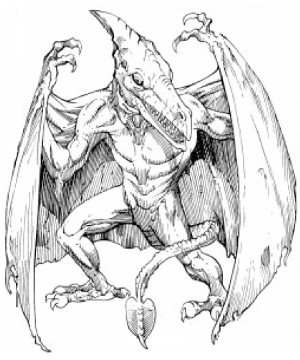
Pterrax
Large beast, unaligned
- Armor Class 12
- Hit Points 43 (5d10+15)
- Speed 15 ft., fly 30 ft.
STR DEX CON INT WIS CHA 17 (+3) 15 (+2) 16 (+3) 2 (-4) 12 (+1) 6 (-2)
- Senses passive Perception 11
- Challenge 3 (700 XP)
Detect Life. The pterrax can sense the presence of living creatures within 120 feet of it.
Psionic Resistance. The pterrax has advantage on psionic saving throws.
Actions
Multiattack. The pterrax makes three attacks: two claws and a bite.
Claw. Melee Weapon Attack: +5 to hit, reach 5 ft., one target. Hit: 7 (1d6+3) slashing damage.
Bite. Melee Weapon Attack: +5 to hit, reach 5 ft., one target. Hit: 10 (2d6+3) piercing damage.
Biofeedback (recharge 6). The pterrax toughens its body against wounds. Until the end of its next turn, it gains resistance to bludgeoning, piercing, and slashing damage.
Rasclinn
The rasclinn is a small dog-like creature that feeds on almost any vegetation that grows in the Athasian badlands. They extract trace metals from the plants, which gives them an almost metallic hide. They are avidly hunted for their hides, but they are tough to kill. A rasclinn grows about 3 feet at the shoulder and weighs around 50 pounds. Rasclinn have no language of their own, but they do communicate by barks and yelps. These warn the young to flee or indicate if a rasclinn has found food or water. They rarely fight unless their young are threatened, instead preferring to lead foes on a chase.
Rasclinn are the natural enemy of almost all plant life. They can eat any type of vegetation; even cactus needles are a scrumptious snack for a rasclinn. Few animals hunt them, since their metallic hide makes them unpalatable for most creatures. They are the only creature known that can get the traces of metal from the plants that they consume. The rasclinn’s only natural enemies are humans and demi-humans.
The rasclinn is avidly hunted for its hide. A person skilled in armor making and tanning can make a set of hide armor from two adult rasclinn skins. It is even possible to smelt out actual iron from the hide, but the forge required is only possessed by a few of the more powerful merchant houses. Should access to such a forge be gained, up to 5 coins weight of iron (worth 50 cp) can be smelted from a single hide.
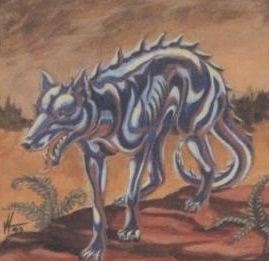
Rasclinn
Medium beast, unaligned
- Armor Class 14
- Hit Points 22 (3d8+9)
- Speed 50 ft.
STR DEX CON INT WIS CHA 15 (+2) 10 (+0) 16 (+3) 2 (-4) 15 (+2) 11(-0)
- Condition Immunity Poison
- Senses Darkvision 60 ft., passive perception 19
- Challenge 1/4 (50 XP)
Psionic Resistance. The rasclinn has advantage on psionic saving throws.
Rage. If a rasclinn sees another rasclinn killed, it flies into a rage for 1 minute, gaining +2 on damage, advantage on strength checks, and it will not flee.
Actions
Bite. Melee Weapon Attack: +4 to hit, reach 5 ft., one target. Hit: 6 (1d6+2) piercing damage.
Razorwing
The razorwing hides under the silt and bursts out of the sand to slash at creatures flying above it. It is a vicious carnivore, and packs of razorwings have brought down creatures much larger than themselves. The razorwing is a small-bodied slate gray creature that looks a bit like a small pterrax. It has bone white edges on its wings which are very sharp. It has an 8 foot wingspan and weighs around 100 pounds. A razorwing is able to communicate with others of its kind. It does not have a language, but uses its power of controlled sound to communicate when prey is nearby.
A razorwing likes to ambush by hiding under a light layer of silt, then explode into action, using psionic energy to power its flight. The razorwings live and hunt in packs. They also never attack alone. There is a pack leader, usually the biggest female. Razorwing young are born alive, high in the air. They immediately learn to glide or they do not survive.
Razorwings are found in the Sea of Silt almost exclusively. There are reports of packs being sighted in the inland silt basins. The razorwing prefers to eat floaters above all else. By means of its life detection power, a razorwing can even differentiate between a floater and other kinds of prey.
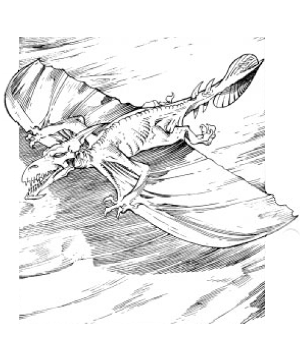
Razorwing
Medium beast, unaligned
- Armor Class 15
- Hit Points 30 (4d8+12)
- Speed 20 ft., fly 40 ft.
STR DEX CON INT WIS CHA 14 (+2) 18 (+4) 16 (+3) 2 (-4) 14 (+2) 12 (+1)
- Skills Stealth +9
- Senses passive perception 14
- Challenge 2 (450 XP)
Detect Life. The razowring can sense the presence of living creatures within 120 feet of it.
Psionic Flight. A razorwing uses psionic energy to ascend and assist in flight. If it cannot use such energy, it must descend at least 5 foot a round.
Mind Blank. A razorwing has advantage on saves against all charm and fear effects.
Actions
Multiattack. The razorwing makes three attacks: a bite and two wing slashes.
Wing. Melee Weapon Attack: +4 to hit, reach 5 ft., one target. Hit: 5 (1d6+2) slashing damage.
Bite. Melee Weapon Attack: +4 to hit, reach 5 ft., one target. Hit: 6 (1d8+2) piercing damage.
Create Sound. Creates a sound as soft as a whisper or load as a roar within 30 feet of anything it has heard.
Psionic flight (recharge 5-6). As a bonus action, the razorwing may ascend up to its flight movement speed.
Sand Bride
The sand bride is a negative material plane creature trapped on Athas. It has no other purpose or function other than to viciously use its powers of illusion to lure victims to a cold death. The sand bride usually creates the illusion of an oasis, with itself as a beautiful humanoid of the race of its target. It feeds on the life force of any humanoid with a degree of intelligence and are innately drawn to preservers. The sand bride is made entirely of sand. It has a humanoid shape and two glowing red eyes.
A sand bride has a burning hatred for intelligent creatures, but it is tempered with a high degree of cunning. A sand bride is intelligent enough to recognize humanoids with water trouble. Such a party is almost certain to be targeted. One of the sand bride’s favorite ploys is to wait until someone is lagging behind the party. This being then comes upon an oasis where he expected to find none. This might seem suspicious, but to a man dying of thirst, a pool of water overcomes many misgivings.
Sand brides are not very good at making polite conversation when luring creatures to their death. Most of their information is out of date or just plain wrong. However, a sand bride’s first suggestion is almost always “have a drink, then we can talk”. It tries to attack while the unsuspecting victim is filling its mouth with sand.
Sand brides are solitary creatures, trapped here when a defiler opened a rift to the negative material plane. Though they have no use for them, sand brides lust after the possessions of men.
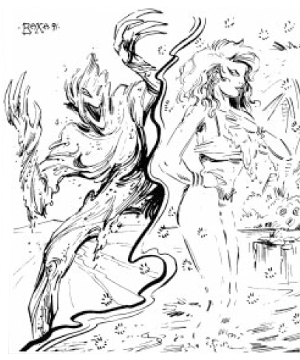
Sand Bride
Medium undead, chaotic evil
- Armor Class 18
- Hit Points 46 (7d8+14)
- Speed 60 ft., burrow (sand only) 30 ft.
STR DEX CON INT WIS CHA 8 (-1) 16 (+3) 15 (+2) 10 (+0) 14 (+2) 12 (+1)
- Damage Resistances acid, fire, cold, lightning, thunder, bludgeoning, piercing, and slashing from non-magical attacks
- Damage Immunities necrotic, poison
- Condition Immunities charmed, exhaustion, grappled, paralyzed, petrified, poisoned, prone, restrained
- Senses darkvision 60 ft., passive perception 12
- Languages Common plus 4 other humanoid
- Challenge 5 (1,800 XP)
Water Vulnerability. The sand bride takes 1d6 damage from each gallon of water that hits it.
Rejuvenation. The sand bride can only be destroyed by magic weapon damage. If reduced to 0 hit points in any other way, it reforms itself after 24 hours in a body of sand anywhere in a 1 mile radius.
Turn Immunity. The sand bride is immune to effects that turn undead.
Spellcasting. The sand bride casts spells as a 10th level wizard (spell saving throw DC 17) without components or the ability to defile:
hallucinatory terrain (1/day)
seeming (2/day)Actions
Multiattack. The sand bride makes two attacks.
Life Drain. Melee Weapon Attack: +5 to hit, reach 5 ft., one target. Hit: 14 (2d10+3) necrotic damage. The target must succeed on a DC 14 Constitution saving throw or its hit point maximum is reduced by the amount of damage taken. This reduction lasts until the target finishes a long rest. The target dies if this effect reduces its hit point maximum to 0. A body of a creature drained of all of its life force by a sand bride becomes a cursed dried-out husk. In two days the husk dissolves into sand and dust. This effect can be removed by remove curse though the creature is still dead.
Sand Mother
A sand mother, or mother of the bride, is a very old and powerful version of the sand bride. Its normal appearance is identical to that of the sand bride. It is not known if the sand mother is a unique creature or if a sand bride can somehow evolve into a sand mother.
The mother of the bride uses the same illusionary powers as the sand bride. Instead of appearing as a beautiful humanoid, it chooses to appear as an older, motherly type of creature. The matronly figure welcomes thirsty adventurers, offering to care for them until they are recovered. A sand mother has learned about its weakness in conversation and has developed the ability to mask it. It does this by showing plenty of concern for the “dear young ones” of the party.
The sand mother is very intelligent, it does not attack until conditions are favorable. Before attacking, it tries to discover if anyone is carrying any magical weapons or if there is a preserver in the party. The sand mother always tries to attack the most dangerous member of the party first, with surprise if possible.
A sand mother’s oasis is always chosen with care. If it can find a pit or sinkhole, it uses that as the center of its hallucinatory terrain. Dangerous opponents can then be pushed in while they are "drinking.""
The sand bride’s hatred for preservers is shared by the sand mother. It always attacks if a preserver is present and usually portrays itself as very interested in the “good mages”. It is intelligent enough to know that magic is very dangerous to it, so it usually attacks a preserver first. If the party splits up and runs away, the preserver is still the one the sand mother pursues.
The sand mother’s lust for life force exceeds even that of the sand bride. It much prefers intelligent life force, but beasts will be drained of all life, if nothing better is available.
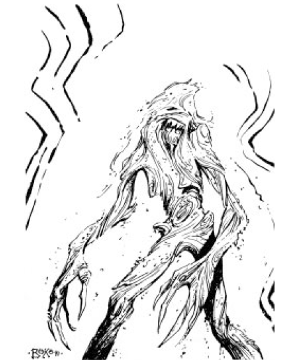
Sand Mother
Medium undead, chaotic evil
- Armor Class 18
- Hit Points 59 (9d8+14)
- Speed 60 ft., burrow (sand only) 30 ft.
STR DEX CON INT WIS CHA 8 (-1) 16 (+3) 15 (+2) 12 (+1) 14 (+2) 12 (+1)
- Damage Resistances acid, fire, cold, lightning, thunder
- Damage Immunities necrotic, poison, bludgeoning, piercing, and slashing from non-magical attacks
- Condition Immunities charmed, exhaustion, grappled, paralyzed, petrified, poisoned, prone, restrained
- Senses darkvision 60 ft., passive perception 13
- Languages Common plus 4 other humanoid
- Challenge 6 (2,300 XP)
Rejuvenation. The sand mother can only be destroyed by magic weapon damage. If reduced to 0 hit points in any other way, it reforms itself after 24 hours in a body of sand anywhere in a 1 mile radius.
Turn Immunity. The sand mother is immune to effects that turn undead.
Spellcasting. The sand mother casts spells as a 12th level wizard (spell saving throw DC 20) without components or the ability to defile:
create or destroy water (destroy only) (1/day) hallucinatory terrain (1/day)
seeming (2/day)Actions
Multiattack. The sand mother makes two attacks.
Life Drain. Melee Weapon Attack: +6 to hit, reach 5 ft., one target. Hit: 16 (2d12+3) necrotic damage. The target must succeed on a DC 14 Constitution saving throw or its hit point maximum is reduced by the amount of damage taken. This reduction lasts until the target finishes a long rest. The target dies if this effect reduces its hit point maximum to 0. A body of a creature drained of all of its life force by a sand mother becomes a cursed dried-out husk. In two days the husk dissolves into sand and dust. This effect can be removed by remove curse though the creature is still dead.
Sand Howler
Sand howlers are desert-dwelling creatures that hunt in packs. They are known for their terrible howls that they use to signal each other when tracking down then prey. Worse than their howls are their eight terrible eyes that are capable of paralyzing anyone who gazes upon them. Sand howlers are lizardlike creatures who resemble dogs. They have oversized heads in order to support their many eyes, large yellow tusks, and are dark brown to light brown in color, though the rare ones have white skin.
Sand howlers are rarely encountered alone and are seldom seen except by their intended prey. Sand howlers make their dens in desolate areas since they do not like to compete with other predators for food. Then dens are deep, labyrinthine tunnel systems where they hide from the surface heat and where they hibernate for short periods of time.
Sand howler pups can be trained as guards or tracking beasts. Their hunting skills are remarkable and their keen sense of smell makes them among the best desert trackers available. Many mercenaries in Athas capture them and train them to chase down runaway slaves. In the Tableland they have been hunted to near extinction in the last few years by those who fear them and those who would domesticate them.
The pelts of white sand howlers often bring about 150 gp because of their rarity, beauty, and protection they provide from heat.
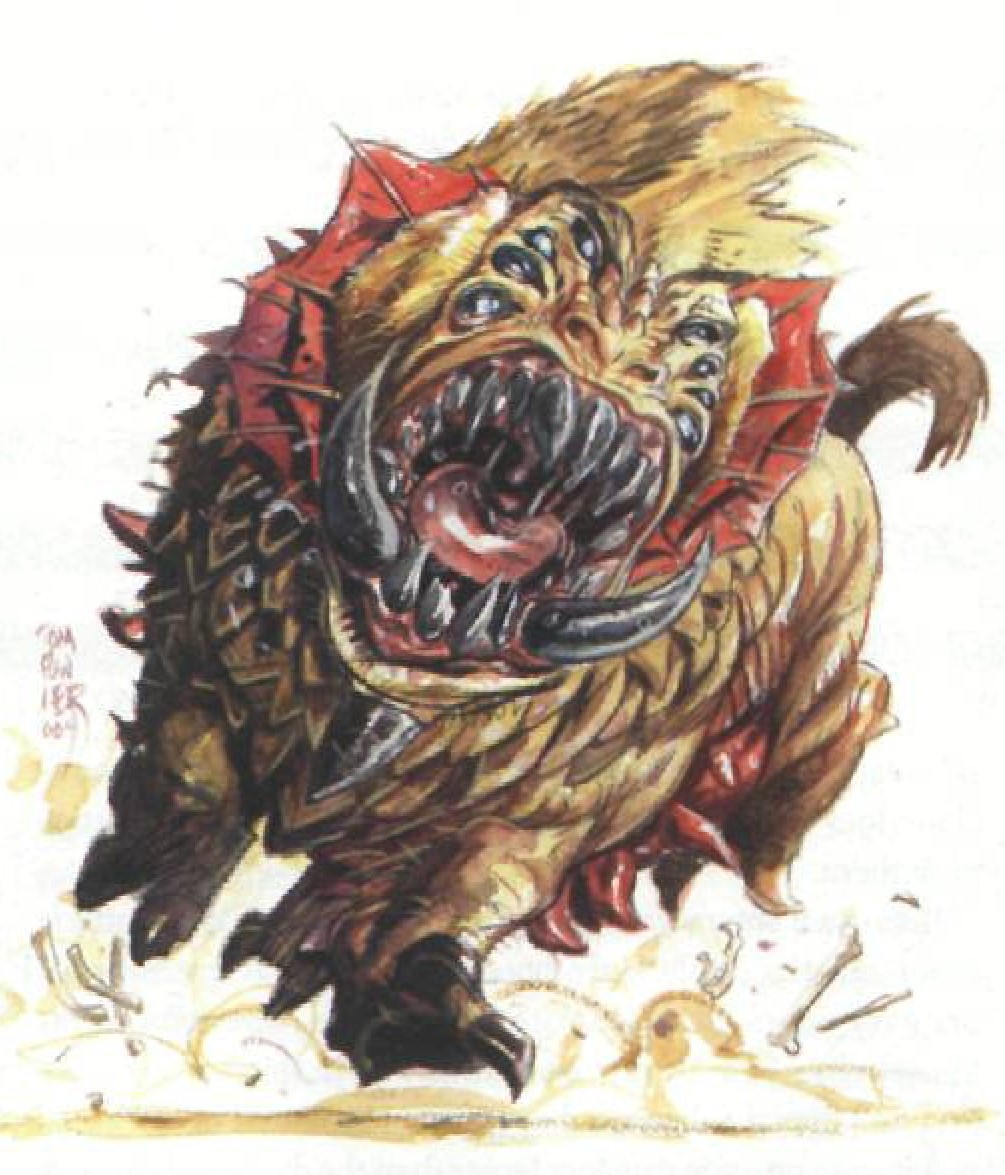
Sand Howler
Medium monstrosity, unaligned
- Armor Class 14
- Hit Points 38 (5d8+15)
- Speed 30 ft.
STR DEX CON INT WIS CHA 16 (+3) 10 (+0) 16 (+3) 2 (-4) 13 (+1) 14 (+2)
- Skills Perception +7
- Senses Passive perception 17
- Challenge 2 (450 XP)
Paralyzing Gaze. When a creature starts its turn within 30 feet of the sand howler and able to see its eyes, the sand howler can force it to make a DC 12 Charisma saving throw, unless the sand howler is incapacitated. On a failed saving throw, the creature is paralyzed for 1d4 rounds and can attempt a saving throw at the start of each of its turns to end the paralysis. Unless surprised, a creature can avert its eyes to avoid the saving throw at the start of its turn. If the creature does so, it can't see the sand howler until the start of its next turn, when it can avert its eyes again. If the creature looks at the sand howler in the meantime, it must immediately make the save.
Actions
Multiattack. The sand howler makes three attacks: two claws and a bite.
Claw. Melee Weapon Attack: +5 to hit, reach 5 ft., one target. Hit: 5 (1d4+3) slashing damage.
Bite. Melee Weapon Attack: +5 to hit, reach 5 ft., one target. Hit: 7 (1d6+3) piercing damage.
Silk Wyrm
The silk wyrm is a snake with a hard, chitinous shell that measures over 50 feet in length. They are commonly seen flying through the air during the day searching for prey, but rarely attack until dusk, when they assume their shadow form and sneak into a camp to attack.
The silk wyrm will drag its paralyzed prey away and encase it in a sheath of silk, inside which the unfortunate victim will linger for up to two weeks. During this time, the silk wyrm will occasionally stick its head into the protective cocoon and bite the victim’s neck, draining a little bit of blood and paralyzing it until eventually the victim dies.
The silk casing manufactured by the silk wyrm is valued in many cities for use in expensive clothing.
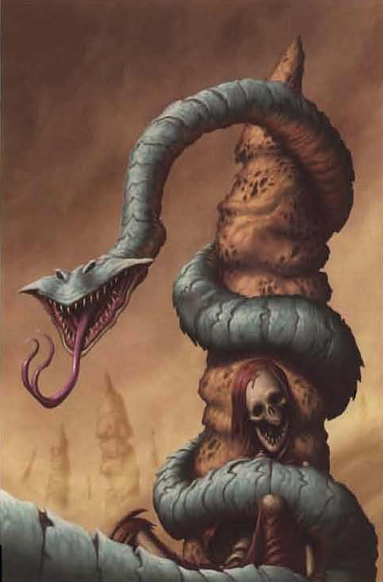
Silk Wyrm
Huge monstrosity, unaligned
- Armor Class 16
- Hit Points 45 (6d12+6)
- Speed 30 ft., fly (psionic) 30 ft.
STR DEX CON INT WIS CHA 14 (+2) 14 (+2) 12 (+1) 6 (-2) 12 (+1) 6 (-2)
- Skills Stealth +4
- Senses Blindsight 10 ft., passive perception 11
- Challenge 3 (700 XP)
Shadow Stealth. While in shadow form, the silk wyrm is invisible in areas of darkness or dim light and cannot move if within an area brighter than dim light.
Actions
Bite. Melee Weapon Attack: +4 to hit, reach 10 ft., one target. Hit: 6 (1d6+2) piercing damage, and the target must make a DC 12 Constitution saving throw or be poisoned for 24 hours. If the save is failed by 5 or more, the target is also paralyzed. The target may make a saving throw at the end of its turns to end the paralysis.
Shadow Form (recharge 4-6). The silk wyrm transforms into an incorporeal shadow version of itself. It cannot manipulate any corporeal objects in this form, cannot make attacks, has resistance to all bludgeoning, piercing, and slashing damage, and can end the effect as a bonus action.
Silt Horror
Silt Horror is the name given a group of predators that dwell in the sea of sand. While they vary in size and color, all of them are characterized by a large number of tentacles, and an unending hunger. Few are the creatures that escape once a silt horror has its tentacles around them. Anything may be considered prey, even giants that wade within their tentacled reach.
Silt horrors lie buried deep in the silt sea and can sense vibrations. When food is within reach, and for some even the ships that skim the surface, they attack, dragging anything they reach below the surface to suffocate and be eaten.
Many Athasian sages believe the horrors to be decendants of an ancient water dwelling creature. This has been evidenced by rock formations containing the impressions of creatures bearing a striking resemblance to the silt horror.
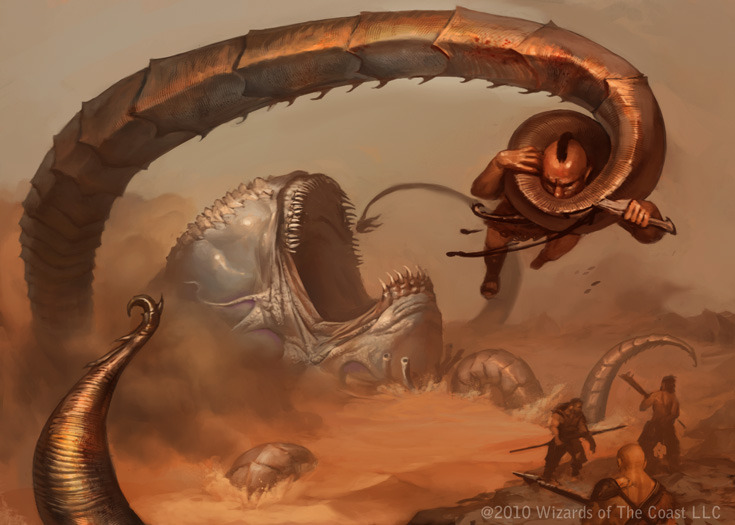
Black Horror
The black silt horror is the smallest at four feet long and most common of the silt horrors. Resembling a black, dusty octopus or squid with a writhing mass of eight barbed tentacles, it roams in groups called clutches. The black silt horror aggressively hunts anything it can catch. Large clutches have attacked white horrors and wading giants, though their favorite food is silt runner.
Brown Horror
The brown horror is a very feared form of silt horror since it can force its victims to come to it. Although more of a dull white, against the pearly silt, the tentacles flailing in the air often appear brown. It must eat once a month and will target other silt horrors.
Gray Horror
The gray horror is perhaps the worst of the silt horrors. It is a sickly gray in color, and has a multitude of sharp-edged tentacles. It is the most intelligent of the horrors, using its create sound to lure targets with the sound of water or life, and fears nothing that moves. Anything is prey, and they prefer giant. They are also intelligent enough to conduct "hit and run" ambushes using their air jet.
White Horror
The white horror is common and largest of the silt horrors. Its tentacles can grow up to 50’ long, and it uses them to drag prey below the silt. It can exist for years on one meal, lying dormant underneath the silt, and is large enough to target ships.
Black Silt Horror
Medium abberation, unaligned
- Armor Class 12
- Hit Points 33 (5d8+10)
- Speed 10 ft., swim (silt) 20 ft.
STR DEX CON INT WIS CHA 12 (+1) 14 (+2) 14 (+2) 3 (-4) 11 (+0) 7 (-2)
- Skills stealth +4
- Senses tremorsense 240 ft.
- Challenge 1 (200 XP)
Actions
Tentacle. Melee Weapon Attack: +4 to hit, reach 5 ft., one target. Hit: 7 (1d8+2) bludgeoning damage and the target is grappled (escape DC 12). If the horror has a target grappled, it may attempt a bite attack as a bonus action.
Bite. Melee Weapon Attack: +4 to hit, reach 5 ft., one target. Hit: 4 (1d4+2) piercing damage and the target must succeed on a DC 12 Constitution saving throw or be paralyzed for 1 minute. The target may attempt another saving throw at the end of each of its turns to end the effect.
Air Jet (recharge 5-6). The horror moves in a straight line up to 150 ft. in silt.
Attraction (recharge 6). One target within 240 ft. must succeed on a DC 12 Wisdom saving throw or be charmed to move in the general direction of the silt horror for 1 minute. The target must use all its movement and cannot take an action that would cause it to not move towards the horror. The target may attempt another saving throw at the end of each of its turns to end the effect.
Id Insinuation (recharge 6). One target within 60 ft. must make a DC 12 Intelligence saving throw or be confused for 1d4 rounds.
Brown Silt Horror
Huge aberration, unaligned
- Armor Class 12
- Hit Points 104 (9d12+45)
- Speed 5 ft., swim (silt) 10 ft.
STR DEX CON INT WIS CHA 26 (+8) 13 (+1) 20 (+5) 3 (-4) 14 (+2) 7 (-2)
- Skills stealth +9
- Senses tremorsense 240 ft. (psionic active power)
- Challenge 8 (3,900 XP)
Psionic Resistance. The horror has advantage on psionic saving throws.
Actions
Multiattack. The horror attacks up to 8 different targets with its tentacles, but only 2 tentacles per target.
Tentacle. Melee Weapon Attack: +11 to hit, reach 15 ft., one target. Hit: 12 (1d6+8) bludgeoning damage and the target is grappled (escape DC 19).
Air Jet (recharge 5-6.) The horror moves in a straight line up to 150 ft. in silt.
Domination (recharge 6). One target within 60 ft. must succeed on a DC 13 Wisdom saving throw or be charmed by the horror for 10 minutes, with advantage if it or its allies are fighting the horror. The horror may issue telepathic commands to choose the target's actions. If no action is issued, the target dodges. If the target takes damage, it may attempt another save to end the effect. The horror may only have one target dominated at a time.
Gray Silt Horror
Huge aberration, unaligned
- Armor Class 12
- Hit Points 104 (12d12+60)
- Speed 10 ft., swim (silt) 20 ft.
STR DEX CON INT WIS CHA 27 (+8) 12 (+1) 21 (+5) 4 (-3) 12 (+1) 7 (-2)
- Skills stealth +9
- Senses tremorsense 240 ft.
- Challenge 9 (5,000 XP)
Sense Movement. The horror can sense the vibrations of movement on or in silt up to 3 miles away and the general direction.
Actions
Multiattack. The horror attacks up to 12 different targets with its tentacles, but only 2 tentacles per target.
Tentacle. Melee Weapon Attack: +11 to hit, reach 15 ft., one target. Hit: 13 (1d8+8) bludgeoning damage and the target is grappled (escape DC 19).
Air Jet (recharge 5-6.) The horror moves in a straight line up to 150 ft. in silt.
Create Sound (recharge 6). The horror psionically creates a minor illusion effect (sound only).
White Silt Horror
Gargantuan aberration, unaligned
- Armor Class 11
- Hit Points 231 (14d20+84)
- Speed 5 ft., swim (silt) 10 ft.
STR DEX CON INT WIS CHA 30 (+10) 12 (+1) 22 (+6) 2 (-4) 12 (+1) 7 (-2)
- Skills stealth +9
- Senses tremorsense 240 ft.
- Challenge 12 (8,400 XP)
Sense Movement. The horror can sense the vibrations of movement on or in silt up to 3 miles away and the general direction.
Actions
Multiattack. The horror attacks up to 10 different targets with its tentacles, but only 2 tentacles per target.
Tentacle. Melee Weapon Attack: +13 to hit, reach 50 ft., one target. Hit: 15 (1d8+10) bludgeoning damage and the target is grappled (escape DC 21).
Air Jet (recharge 5-6.) The horror moves in a straight line up to 150 ft. in silt.
Silt Runner
These small lizard-like men are common on Athas. They usually live the life of raiders, although occasionally a lair will be found. Silt runners move very quickly and have broad, flat feet. They can even run across silt for short stretches. They hate elves with a passion and consider them a delicacy; an entire raiding party of silt runners may turn aside from a caravan to attack a lone elf.
Silt runners wear little or no clothing. What they do wear is usually more of a trophy than any covering for the sake of modesty or protection. Silt runners speak a tribal language, and some can speak the common tongue.
Silt runners never attack unless they outnumber the foe by at least three to one. Silt runners are tribal in nature, living in lairs of up to 200 individuals. These tribes are usually based on islands near the shores of the Sea of Silt or in a remote desert oasis. Silt runners often inhabit the same types of islands that giants do. Giants are usually left alone by silt runners (who know when they are overmatched). The giants tend to view these creatures as pests or vermin, overrunning their homes. Unfortunately, they are just too fast to swat properly.
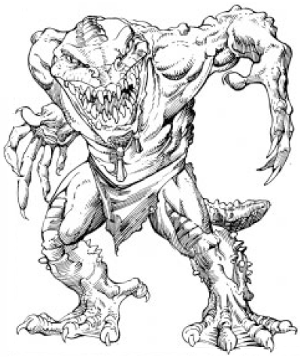
Leaders
Silt runner leaders rank by their hit points. A tribe leader has maximum hit points and the best weapon the tribe possesses, replacing a claw attack.
Silt Runner
Small humanoid (lizardfolk), chaotic evil
- Armor Class 12 (natural)
- Hit Points 7 (2d6)
- Speed 80 ft.
STR DEX CON INT WIS CHA 9 (-1) 11 (+0) 11 (+0) 7 (-2) 9 (-1) 8 (-1)
- Senses passive Perception 9
- Challenge 1/8 (25 XP)
Silt Run. The silt runner can move across silt as if normal terrain but cannot float if it stops.
Actions
Multiattack. The silt runner makes a claw and bite attack.
Claw. Melee Weapon Attack: +2 to hit, reach 5 ft., one target. Hit: 2 (1d4) slashing damage.
Bite. Melee Weapon Attack: +2 to hit, reach 5 ft., one target. Hit: 4 (1d6) piercing damage.
Silt Runner Leader
Small humanoid (lizardfolk), chaotic evil
- Armor Class 14 (natural and shield)
- Hit Points 14 (4d6)
- Speed 80 ft.
STR DEX CON INT WIS CHA 12 (+1) 12 (+1) 11 (+0) 7 (-2) 10 (+0) 10 (+0)
- Senses passive Perception 10
- Challenge 1/4 (50 XP)
Silt Run. The silt runner can move across silt as if normal terrain but cannot float if it stops.
Actions
Multiattack. The silt runner makes a claw and bite attack.
Claw. Melee Weapon Attack: +3 to hit, reach 5 ft., one target. Hit: 3 (1d4+1) slashing damage.
Bite. Melee Weapon Attack: +3 to hit, reach 5 ft., one target. Hit: 5 (1d6+1) piercing damage.
Sloth, Athasian
The Athasian sloth is fast, cunning, and very bloodthirsty. A family of sloths can eat a whole halfling village in one night and is usually not afraid to try. The Athasian sloth is a large creature with brown fur. Standing 8 feet tall and weighing 750 pounds, it usually has light tan and brown, or light grey and green spots making it easy for the sloth to blend in with the foliage of the Forest Ridge. Athasian sloths make no sounds that anyone else can hear. Despite this, they seem to communicate very well with each other, making well-coordinated attacks.
The sloth is a territorial animal and defends its territory fiercely. A small forest may only have one or two families of Athasian sloths. Athasian sloths never attack one another, and if the parents are killed, the young sloths are likely to be adopted by the first adult sloths they can find. Athasian sloths prefer trees as lairs and as their method of travel.
The Athasian sloth has one natural enemy – halflings. Coincidentally, it also has one favorite food – again, halflings. A halfling is almost certain to be attacked in preference to anyone else in a group of adventurers. In fact, by the time a sloth reaches adulthood it has almost certainly killed and eaten many of the little folk. For this reason, among others, the sloth is hunted down by halflings whenever there is one reported in the area.
A single sloth can also provide a whole halfling family with warm cloaks. The curved talons are mounted on hilts and make effective daggers. A halfling who single-handedly kills an Athasian sloth is hailed as a hero by his tribe. Even being part of a group that has slain a sloth is a sure way to honor among the folk of the Forest Ridge.
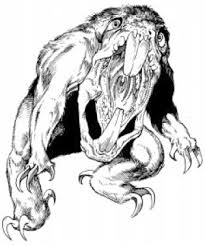
Athasian Sloth
Large beast, unaligned
- Armor Class 14 (natural)
- Hit Points 105 (11d10+44)
- Speed 60 ft., climb 30 ft.
STR DEX CON INT WIS CHA 22 (+6) 16 (+3) 18 (+4) 3 (-4) 12 (+1) 11 (+0)
- Damage Resistances poison
- Skills Stealth +5
- Senses passive Perception 11
- Challenge 8 (3,900 XP)
Keen Senses. The sloth has advantage on Perception checks based on smell.
Forest Camouflage. In a forest, a sloth has advantage on stealth checks to Hide.
Actions
Multiattack. The sloth makes a claw and a bite attack.
Claws. Melee Weapon Attack: +9 to hit, reach 10 ft., one target. Hit: 11 (1d8+6) slashing damage.
Bite. Melee Weapon Attack: +9 to hit, reach 5 ft., one target. Hit: 17 (3d6+6) piercing damage.
So-ut
The so-ut, or rampagers, are fierce creatures that live only for the sake of destruction. They know no fear and hate the things of men, like weapons and buildings.
A rampager is a huge, six-legged creature with gray scales covering its whole body. These scales are unusually thick and almost impossible to cut through. The four rear legs are large round pads, while the two front legs have claws as long as daggers. The face is out of a nightmare, with long, dirty fangs and glowing red eyes. Its nose is similar to a vestigial horn, and they have small rounded ears. Its hearing is very poor, but its sense of smell is acute.
No one has ever been able to communicate with a so-ut. They are driven mad by the smell of manufactured items, particularly metal. The sight of a building also seems to enrage them. A so-ut always attacks the largest man-made object present. It attempts to destroy metal in preference to anything else.
Rampagers generally sleep during the heat of the day, and a bold adventurer can even walk across one without waking it. They live off of their victims. After the so-ut has destroyed all man-made articles in sight, it usually settles down to feed off of the bodies left in its wake.
A rampager’s scales make excellent armor. A complete undamaged so-ut hide is worth as much as 100 silver pieces, but must be cured by a leatherworker and then fashioned by an armorer.
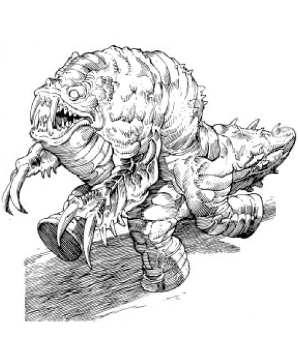
So-ut (rampager)
Huge monstrosity, chaotic evil
- Armor Class 21 (natural)
- Hit Points 173 (15d12+75)
- Speed 40 ft.
STR DEX CON INT WIS CHA 22 (+6) 10 (+0) 20 (+5) 3 (-4) 12 (+1) 8 (-1)
- Saving Throws Str +10, Con +9
- Damage Resistances psychic; bludgeoning, piercing, and slashing from nonmetal weapons
- Senses darkvision 60 ft., passive Perception 11
- Challenge 15 (13,000 XP)
Psionic and Magic Resistance. The so-ut has advantage on saving throws against psionic effects and spell effects.
Fear Presence. When any creature starts its turn within 30 feet of a so-ut, it must succeed on a DC 17 Wisdom saving throw or be frightened for 1 minute. The target may make a saving throw at the end of each of its turns to end the effect.
Siege Monster. The so-ut deals double damage to objects and structures.
Actions
Multiattack. The so-ut makes three attacks: two claws and a bite.
Claw. Melee Weapon Attack: +10 to hit, reach 10 ft., one target. Hit: 19 (2d6+6) slashing damage plus 7 (2d6) acid.
Bite. Melee Weapon Attack: +10 to hit, reach 5 ft., one target. Hit: 17 (3d6+6) piercing damage.
Damage versus items
DMG page 246-47. A typical metal weapon or armor has AC 19 (if not being used) and 18 hit points. If a so-ut attacks a metal item being held, the better AC of the item or user should be applied. Metal items can be repaired with proficiency in smith's tools (see Xanathar's Guide to Everything page 84) at 10 hit points per hour of labor.
Ssurran
Ssurrans are nomadic, humanoid reptiles. Some are raiders while others are simple hunters. As lizard men of the desert, they have adapted to the heat of the Athasian day and are active even during the blazing mid-day heat. Adult ssurrans are 4 to 6 feet tall, weighing from 180 to 225 pounds. Their skin tones range from light green to brown to red. Ssurrans typically dress in little more than loin cloths, bone jewelry, and armor and carry weapons they have taken from past victims.
Ssurrans are fierce but disorganized fighters who prefer to outnumber their opponents in a fair fight. They ambush their intended victims and attack from behind as often as possible should their intended victims be greater in number than they wish to handle. They fight an opponent until that single opponent is dead, then they loot the body and mark it with their claw so they can claim it as their own food after the battle.
Ssurrans have few natural enemies, but many required ones. They prey on human, demihuman and humanoid settlements whenever possible. If they capture a large number of these creatures, ssurrans hold a great feast and sacrifice the rest to their obscure gods. Ssurrans are strict carnivores. They prefer the flesh of halflings, but prey upon any living thing they find.
Slavers and mercenaries often attack tribes of ssurrans in hopes of acquiring their young for gladiators since they are exotic and their natural strength and fighting ability make them worthy combatants.
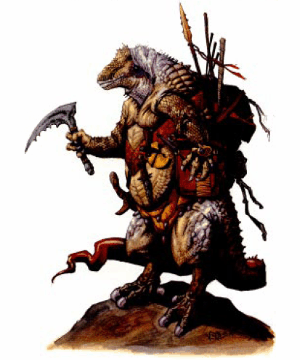
Ssurran
Medium humanoid (lizardfolk), lawful neutral or evil
- Armor Class 15 (natural)
- Hit Points 22 (4d8+4)
- Speed 30 ft.
STR DEX CON INT WIS CHA 17 (+3) 11 (+0) 12 (+1) 10 (+0) 12 (+1) 7 (-2)
- Skills Perception +3, Stealth +4, Survival +5
- Senses passive Perception 13
- Damage Resistances fire
- Languages Pterran
- Challenge 1 (200 XP)
Actions
Multiattack. The ssurran makes two melee attacks with a different weapon.
Claws Melee Weapon Attack: +5 to hit, reach 5 ft., one target. Hit: 7 (1d6+3) slashing damage.
Bite. Melee Weapon Attack: +5 to hit, reach 5 ft., one target. Hit: 5 (1d4+3) piercing damage.
Bone javelin. Melee Weapon Attack: +5 to hit, reach 5 ft. or range 30/120 ft., one target. Hit: 7 (1d6+3) piercing damage.
Ssurran shaman
Medium humanoid (lizardfolk), lawful neutral
- Armor Class 13 (natural)
- Hit Points 27 (5d8+5)
- Speed 30 ft.
STR DEX CON INT WIS CHA 15 (+2) 10 (+0) 13 (+1) 10 (+0) 15 (+2) 12 (+1)
- Skills Perception +4, Stealth +4, Survival +6
- Senses passive Perception 14
- Damage Resistances fire
- Languages Pterran
- Challenge 2 (450 XP)
Spellcasting. The ssurran is a 5th level druid spellcaster (spell save DC 12, +4 to hit with spells). The ssurran has the following spells prepared:
Cantrips (at will): druidcraft, produce flame, thorn whip
1st Level (4 slots): entangle, fog cloud
2nd Level (3 slots): moonbeam, spike growth
3rd level (2 slots): conjure animals, wind wallActions
Multiattack. The ssurran makes two melee attacks with a different weapon.
Claws Melee Weapon Attack: +6 to hit, reach 5 ft., one target. Hit: 5 (1d6+2) slashing damage.
Bite. Melee Weapon Attack: +6 to hit, reach 5 ft., one target. Hit: 4 (1d4+2) piercing damage.
Wild Shape. The ssurran turns into a kluzd for up to 2 hours and can revert to humanoid shape with a bonus action.
Ssurran leader
Medium humanoid (lizardfolk), lawful neutral or evil
- Armor Class 15 (natural)
- Hit Points 78 (12d8+24)
- Speed 30 ft.
STR DEX CON INT WIS CHA 18 (+4) 12 (+1) 15 (+2) 11 (+0) 12 (+1) 15 (+2)
- Saving Throws Con +5, Wis +3
- Skills Perception +4, Stealth +5, Survival +6
- Senses passive Perception 14
- Damage Resistances fire
- Languages Pterran
- Challenge 4 (1,100 XP)
Elemental power. Once per day, the ssurran can cast shield of faith and mass cure wounds as if a 9th level cleric.
Actions
Multiattack. The ssurran makes two melee attacks with a different weapon.
Claws Melee Weapon Attack: +7 to hit, reach 5 ft., one target. Hit: 8 (1d6+4) slashing damage.
Bite. Melee Weapon Attack: +7 to hit, reach 5 ft., one target. Hit: 6 (1d4+4) piercing damage.
Bone battleaxe. Melee Weapon Attack: +7 to hit, reach 5 ft. or range 30/120 ft., one target. Hit: 9 (1d8+4) slashing damage or 10 (1d10+4) slashing damage if used with two hands.
Tarek
Tareks are big, musclebound, hairless bipeds standing over 6 feet tall that inhabit the hilly and mountainous areas of Athas. They have square, big-boned heads with sloping foreheads and massive brow ridges. Their flat noses have flared nostrils, and their domed muzzles are full of sharp teeth. Their powerful arms are so long that their knuckles drag along the ground. Tareks have a distinct musky odor and move with jerky, awkward strides except when in combat, when they change to a graceful dance-like form. They are among the most popular combatants in the arena and are often paired with a mate.
Tareks speak their own language filled with harsh and gutteral words. They are violent and aggressive and place great value and honor in physical prowess. Tareks gather in tribes that often sustain themselves by raiding, and they are treacherous trading partners. They are constantly at war with the gith.
They disdain armor and manufacture their own weapons: the handfork (a slicing and parrying tool) and the heartpick (a bone hammer with a serrated pick on the front and a heavy flat head on the back).
Tareks hate wizardly magic in all its forms and will out of their way to destroy any caster. This hatred otranslates into a strong dislike for elves who often deal in the business of spell components, and they often attack elves automatically assuming dark magic follows. Earth clerics are respected as the tarek consider themselves born of the earth and hills. “Solid is the tarek, strong like the earth, and numerous as the soil,” sing the earth clerics of the tarek tribes.
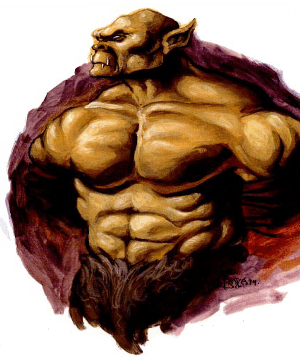
Tarek
Medium humanoid, lawful neutral
- Armor Class 12 (natural)
- Hit Points 15 (2d8+6)
- Speed 30 ft.
STR DEX CON INT WIS CHA 16 (+3) 11 (+0) 16 (+3) 13 (+1) 11 (+0) 10 (+0)
- Senses passive Perception 10
- Languages Tarek, Common
- Challenge 1/2 (100 XP)
Pack Tactics. The tarek has advantage on an attack roll against a creature if at least one of its allies is within 5 feet of the creature and the ally isn't incapacitated.
Relentless (recharge after short or long rest). If the tarek takes 7 damage or less that would reduce it to 0 hit points, it is reduced to 1 hit point instead.
Actions
Obsidian handfork. Melee Weapon Attack: +5 to hit, reach 5 ft., one target. Hit: 7 (1d6+3) slashing damage.
Bone heartpick. Melee Weapon Attack: +5 to hit, reach 5 ft., one target. Hit: 8 (1d8+3) bludgeoning damage.
Mind Slam (recharge 6). A creature within 60 ft. that the tarek can see must succeed on a DC 11 Constitution saving throw or take 1d6 force damage, and if size Large or smaller, be knocked prone.
Tarek Shaman Enchantments
Because of their intimate connection to the earth, tarek shamans shun weapons made out of any material other than stone or obsidian. Tarek shamans of 3rd level or higher can bless a stone weapon once per year for use by the tribe’s chief or greatest warrior. This blessing bestows a magical enchantment on the weapon that lasts for one year, effectively making it a +1 magical weapon in the hands of the champion. If a blessed weapon is taken from the tarek who is intended to wield it, it loses its enchantment in 24 hours.
Tarek war leader
Medium humanoid, lawful neutral
- Armor Class 14 (natural)
- Hit Points 30 (4d8+12)
- Speed 30 ft.
STR DEX CON INT WIS CHA 16 (+3) 14 (+2) 16 (+3) 13 (+1) 12 (+1) 10 (+0)
- Saving Throws Con +5
- Senses passive Perception 11
- Languages Tarek, Common
- Challenge 2 (450 XP)
Pack Tactics. The tarek has advantage on an attack roll against a creature if at least one of its allies is within 5 feet of the creature and the ally isn't incapacitated.
Relentless (recharge after short or long rest). If the tarek takes 10 damage or less that would reduce it to 0 hit points, it is reduced to 1 hit point instead.
Actions
Multiattack. The tarek makes two weapon attacks.
Obsidian handfork. Melee Weapon Attack: +5 to hit, reach 5 ft., one target. Hit: 7 (1d6+3) slashing damage.
Bone heartpick. Melee Weapon Attack: +5 to hit, reach 5 ft., one target. Hit: 8 (1d8+3) bludgeoning damage.
Command (1/day). Up to three allied tareks within 120 feet that can hear it can use their reactions to each make one weapon attack.
Mind Slam (recharge 5-6). A creature within 60 ft. that the tarek can see must succeed on a DC 13 Constitution saving throw or take 1d6 force damage, and if size Large or smaller, be knocked prone.
Tarek tribal chief
Medium humanoid, lawful neutral
- Armor Class 14 (natural)
- Hit Points 94 (11d8+44)
- Speed 30 ft.
STR DEX CON INT WIS CHA 18 (+4) 14 (+2) 18 (+4) 14 (+2) 12 (+1) 16 (+3)
- Saving Throws Str +7, Dex +5, Con +7
- Senses passive Perception 11
- Languages Tarek, Common
- Challenge 4 (1,100 XP)
Pack Tactics. The tarek has advantage on an attack roll against a creature if at least one of its allies is within 5 feet of the creature and the ally isn't incapacitated.
Relentless (recharge after short or long rest). If the tarek takes 20 damage or less that would reduce it to 0 hit points, it is reduced to 1 hit point instead.
Aggressive. As a bonus action, the tarek can move up to its speed toward a hostile creature it can see.
Actions
Multiattack. The tarek makes two weapon attacks.
Blessed bone greataxe +1. Melee Weapon Attack: +8 to hit, reach 5 ft., one target. Hit: 10 (1d12+5) slashing damage. Counts as a magical weapon.
Obsidian handfork. Melee Weapon Attack: +7 to hit, reach 5 ft., one target. Hit: 8 (1d6+4) slashing damage.
Battle Cry (1/day). Each creature of the tarek's choice that is within 30 feet of it and can hear it gains advantage on its attack rolls until the start of the tarek chief's next turn. The chief can then make one attack as a bonus action.
Mind Slam (recharge 5-6). A creature within 60 ft. that the tarek can see must succeed on a DC 14 Constitution saving throw or take 2d6 force damage, and if size Large or smaller, be knocked prone.
Tarek earth shaman
Medium humanoid, lawful neutral
- Armor Class 12 (natural)
- Hit Points 30 (4d8+12)
- Speed 30 ft.
STR DEX CON INT WIS CHA 12 (+1) 11 (+0) 16 (+3) 13 (+1) 14 (+2) 10 (+0)
- Skills Arcana +3, Medicine +4
- Senses passive Perception 12
- Languages Tarek, Common
- Challenge 1 (200 XP)
Relentless (recharge after short or long rest). If the tarek takes 10 damage or less that would reduce it to 0 hit points, it is reduced to 1 hit point instead.
Spellcasting. The tarek is a 4th level earth cleric (spell save DC 12, +4 to hit with spells). The tarek has the following spells prepared:
Cantrips (at-will): guidance, light, poison spray, sacred flame
1st level (4 slots): bane, inflict wounds, protection from evil and good, shield of faith
2nd level (3 slots): blindness/deafness, silenceActions
Obsidian handfork. Melee Weapon Attack: +3 to hit, reach 5 ft., one target. Hit: 5 (1d6+1) slashing damage.
Channel Divinity (1/day). Each beast or plant within 30 feet that the tarek can see must make a DC 12 Wisdom saving throw or be charmed for one minute, ending if it takes damage. The tarek designates others to which the charmed creature is friendly.
Mind Slam (recharge 5-6). A creature within 60 ft. that the tarek can see must succeed on a DC 12 Constitution saving throw or take 1d6 force damage, and if size Large or smaller, be knocked prone.
Tarek high shaman
Medium humanoid, lawful neutral
- Armor Class 14 (natural)
- Hit Points 45 (6d8+18)
- Speed 30 ft.
STR DEX CON INT WIS CHA 14 (+2) 15 (+0) 16 (+3) 13 (+1) 15 (+2) 11 (+0)
- Skills Arcana +4, Medicine +5, Survival +5
- Senses passive Perception 12
- Languages Tarek, Common
- Challenge 2 (450 XP)
Relentless (recharge after short or long rest). If the tarek takes 10 damage or less that would reduce it to 0 hit points, it is reduced to 1 hit point instead.
Dampen Elements. As a reaction, when the tarek or a creature within 30 feet of it takes acid, cold, fire, lightning, or thunder damage, the tarek can grant it resistance to that instance of damage.
Spellcasting. The tarek is a 6th level earth cleric (spell save DC 13, +5 to hit with spells). The tarek has the following spells prepared:
Cantrips (at-will): guidance, light, poison spray, sacred flame
1st level (4 slots): bane, cure wounds, guiding bolt
2nd level (3 slots): barkskin, warding bond
3rd level (3 slots): bestow curse, spike growthActions
Obsidian handfork. Melee Weapon Attack: +5 to hit, reach 5 ft., one target. Hit: 6 (1d6+2) slashing damage.
Channel Divinity (2/day). Each beast or plant within 30 feet that the tarek can see must make a DC 13 Wisdom saving throw or be charmed for one minute, ending if it takes damage. The tarek designates others to which the charmed creature is friendly.
Mind Slam (recharge 5-6). A creature within 60 ft. that the tarek can see must succeed on a DC 13 Constitution saving throw or take 2d6 force damage, and if size Large or smaller, be knocked prone.
Tari
The tari are commonly referred to as ratmen by the other denizens of the Tyr region. They are small, furry humanoid scavengers, capable of thriving on food and water too polluted for humans to ingest. Hunted freely as pests, the tari are the barbaric descendants of a once thriving culture who inhabited lands to the south of the Tyr region. The tari are unimpressive creatures, roughly 5 feet tall and weighing 100 pounds. They move about as bipeds, but sometimes walk on their knuckles.Tari wear no clothing, though warriors sometimes have leather jerkins or even chitin greaves.
Tari have a high-pitched, squeaky language all their own. They can send and receive some signals that are beyond the human ear’s ability to hear. Natural cowards, they rarely attack without numbers.
The tari race once boasted a thriving culture far to the south of the Tvr region. Ythri, the legendary capital city, is now a ruin lost among the crags. Their education and knowledge was much greater than today and their technology allowed them to build stone and concrete structures. What happened to their civilization is a mystery. The tari of the Tyr region have no written history. What remains is a collection of exaggerated myths and legends describing wondrous works.
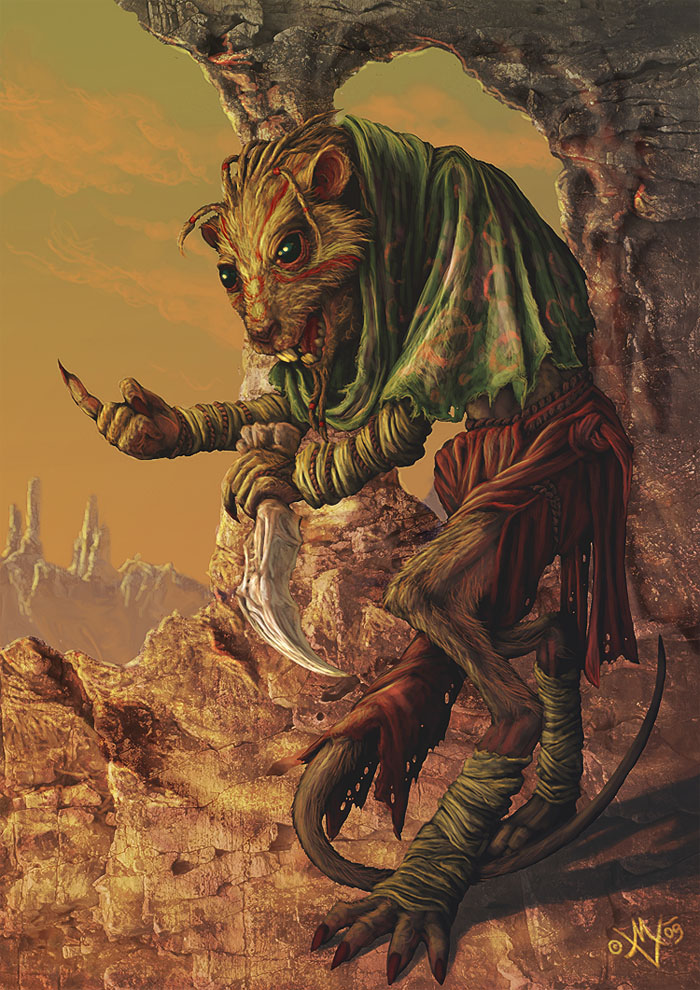
Tari Disease
The target must succeed on a DC 10 Constitution saving or be diseased. Every 24 hours, the target must succeed on another DC 10 Constitution saving throw or his Constitution is reduced by 1. At 0 Constitution, the target dies. Constitution lost this way cannot be regained until the disease is removed and after a long rest.
Tari
Small humanoid (tari), neutral
- Armor Class 13
- Hit Points 11 (3d6)
- Speed 25 ft.
STR DEX CON INT WIS CHA 9 (-1) 15 (+2) 11 (+0) 9 (-1) 11 (+0) 6 (-2)
- Senses passive Perception 10
- Languages Tari
- Challenge 1/4 (50 XP)
Actions
Bite. Melee Weapon Attack: +4 to hit, reach 5 ft., one target. Hit: 4 (1d4+2) piercing damage plus tari disease.
Bone short sword. Melee Weapon Attack: +4 to hit, reach 5 ft., one target. Hit: 6 (1d6+2) piercing damage.
Tari Chieftain
Small humanoid (tari), neutral
- Armor Class 13
- Hit Points 18 (4d6+4)
- Speed 25 ft.
STR DEX CON INT WIS CHA 10 (+0) 16 (+3) 12 (+1) 10 (+0) 12 (+1) 12 (+1)
- Senses passive Perception 11
- Languages Tari
- Challenge 1/2 (100 XP)
Actions
Bite. Melee Weapon Attack: +5 to hit, reach 5 ft., one target. Hit: 5 (1d4+3) piercing damage plus tari disease.
Bone short sword. Melee Weapon Attack: +5 to hit, reach 5 ft., one target. Hit: 7 (1d6+3) piercing damage.
Mystic Charm (1/day). One humanoid the tari can see within 120 feet must succeed on a Charisma DC 11 saving throw or be charmed by it until the end of the tari's next turn.
Tembo
The tembo is a despicable, furless, tawny-colored beast covered with loose folds of scaly hide. Varying between three and six feet in length, they usually stand about as high as a man’s thigh. All four of their lithe feet end in long sharp claws, and huge canine fangs protrude from beneath the flappy lips of their squarish snouts. The tembo has huge, squarish ears which it can turn in any direction, independently of each other.
Tembo display no fear, and will always fight to the death rather than run. The favorite food of the tembo is the young of any other race. Tembo are famous for sneaking into a nomadic camps to drag off elven children, for skulking about dwarven villages prowling for untended toddlers, even for sneaking into populated cities to snatch noble babes from their cradles. Needless to say, this makes these despicable beasts universal objects of hatred. Even feuding elf tribes, the most dedicated of enemies, have been known to call a truce for the purposing of hunting down a tembo pack that has appeared in the area.
Legends say vile powers that predate even the sorcerer kings created the tembo to terrorize their enemies. Given the tembo serves no ecological function, it is not a disputed tale. They can understand language but only create chilling laughing noises. They have no remorse.
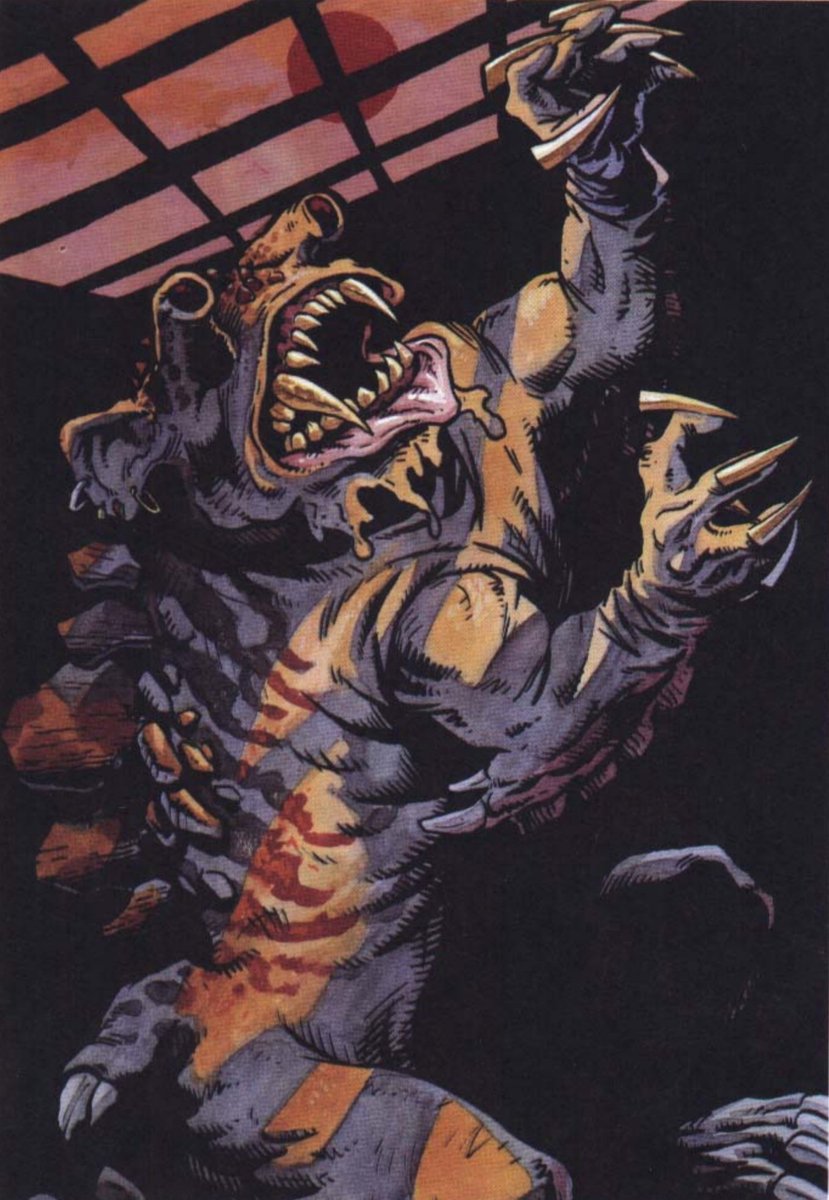
Tembo
Medium aberration, chaotic evil
- Armor Class 15
- Hit Points 30 (4d8+12)
- Speed 40 ft.
STR DEX CON INT WIS CHA 16 (+3) 15 (+2) 17 (+3) 14 (+2) 14 (+2) 10 (+0)
- Saving Throws Int +4, Wis +4
- Skills Perception +9, Stealth +4
- Senses Darkvision 60 ft., passive perception 19
- Challenge 5 (1,800 XP)
Magic and Psionic Resistance. The tembo has advantage on saving throws against spells, psionics, and other such effects.
Chameleon Skin. The tembo can change its skin color to match its surroundings and has advantage on Stealth checks to hide.
Deflect Missiles. The tembo reduces damage from ranged attacks by 1d10 + 6.
Displacement. As a reaction, when the tembo takes damage from an attacker it can see, it reduces the damage by half.
Actions
Multiattack. The tembo makes three attacks: two claws and a bite.
Claws. Melee Weapon Attack: +5 to hit, reach 5 ft., one target. Hit: 7 (1d6+3) slashing damage.
Bite. Melee Weapon Attack: +5 to hit, reach 5 ft., one target. Hit: 6 (1d8+3) piercing damage plus 7 (2d6) necrotic damage. The target must succeed on a DC 13 Constitution saving throw or its hit point maximum is reduced by an amount equal to the necrotic damage taken. This reduction lasts until the target finishes a long rest, and the target dies if its hit point maximum is 0.
Life Drain (recharge 4-6). A living target within 60 ft. that the tembo can see must make a DC 13 Constitution saving throw or lose 1d6 hit points. This amount is transferred to the tembo, healing it. It can have up to 10 hit points over its hit point maximum in this way as temporary hit points.
Death Field (recharge 6). The tembo sacrifices any number of its hit points (it must leave itself with at least 1 hit point). Every living creature within 20 feet must make a DC 13 Constitution saving throw, taking the amount sacrificed on a failed save, or half as much on a successful one.
Thrax
A thrax is a dreadful creature that exists by draining the water from its victims. New military recruits guarding outlying sources of fresh water laugh behind the backs of old veterans who whisper of the water wraiths, and they mock them for bringing a plump carru calf on a lead rope as they make their late-night rounds. It is only a matter of time, though, before the young upstarts awaken one dawn to find a friend's mummified corpse curled up outside.
The thrax is humanoid in appearance with a ruddy tinge to its skin. It has dark hair and pointed ears, but it will never be mistaken for an elf. Its features are gaunt and angular, and the eyes of a thrax are a deep blue, like a pool of water. The thrax is a muscular creature; it has long thin arms and fingers that end in small suckers.
Legends say the sorcerer queen Abalach-Re offered an alliance to a town of proud warriors. The town refused and killed her envoys. In return, she cursed the town with an unquenchable thirst, and within days, the entire town was dead and the thrax were born.
The thrax is an unfortunate creature that can be found anywhere. Since the corpse of a thrax victim is unmistakable, thrax are not common in cities or villages, at least not for long. The thrax remembers what he was like before the change, but he cannot help himself. He is driven to drink from those around him, and on rare occasion it is said a thrax can be heard apologizing as it drinks deeply of its victim's fluids.
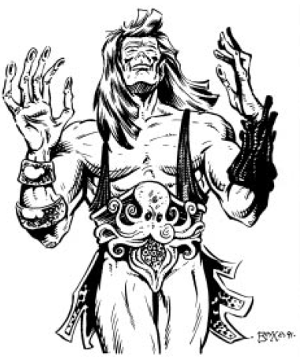
Thrax
Medium undead, neutral evil
- Armor Class 17
- Hit Points 82 (11d8+33)
- Speed 60 ft.
STR DEX CON INT WIS CHA 16 (+3) 16 (+3) 16 (+3) 12 (+1) 10 (+0) 12 (+1)
- Saving Throws Dex +6, Wis +3
- Skills Perception +3 Stealth +6
- Damage Resistances necrotic
- Damage Immunities poison
- Senses darkvision 60 ft., passive perception 13
- Challenge 6 (2,300 XP)
Shadow Stealth. While in shadow form, the thrax is invisible in areas of darkness or dim light and cannot move if within an area brighter than dim light.
Energy containment. When taking damage from acid, cold, fire, lightning, or thunder, the thrax can use its reaction to take half damage from that instance of damage.
Actions
Water Drain. Melee Weapon Attack: +6 to hit, reach 5 ft., one target. Hit: 11 (2d6+3) necrotic damage, and the thrax attaches its suckered fingers to the target, which is grappled (escape DC 14). While attached, the thrax does not attack but instead at the start of its turns drains 11 (2d6+3) hit points due to water drain. The target must also succeed on a DC 14 Constitution saving throw or have disadvantage on attacks and ability checks while the thrax is attached.
Shadow Form (recharge 4-6). The thrax transforms into an incorporeal shadow version of itself. It cannot manipulate any corporeal objects in this form, cannot make attacks, has resistance to all bludgeoning, piercing, and slashing damage, and can end the effect as a bonus action.
Thrax Curse
A human who survives water drain damage from a thrax must succeed on a DC 14 Charisma saving throw or become cursed. Over a period of 1d4+1 weeks, the human painfully begins to change into a thrax and is possessed of an overwhelming thirst, tripling her daily water needs. Other races are immune.
Tigone
Tigones are large, feline creatures which are dark green in color and have black or yellowish-brown vertical striping. Growing to a length of 7’, they can weigh over 250 pounds. Native of the Hinterlands, tigones have been known to roam the Ringing Mountains. They are fearful predators and will attack almost any creature violating their territory. Because of their coloration, a tigone is almost impossible to see when holding perfectly still in the underbrush. They also move very quietly through any terrain. They dislike warm environments and soon die if forced into the desert.
Highly sought for gladiatorial games, most tigones do not survive the trip across the desert. They bring a handsome price if successfully transported to a sorcerer-king’s city. Halflings prize tigones as hunting partners because of their psionic tracking and hunting skills.
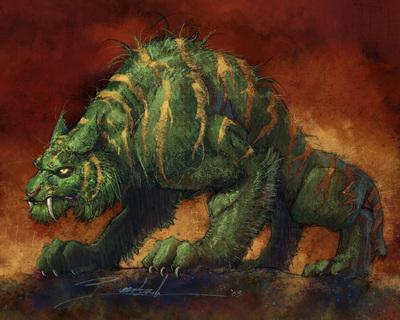
Tigone
Large beast, unaligned
- Armor Class 13
- Hit Points 38 (5d10+10)
- Speed 40 ft.
STR DEX CON INT WIS CHA 17 (+3) 15 (+2) 14 (+2) 3 (-4) 12 (+1) 8 (-1)
- Skills Perception +3, Stealth +6
- Senses passive Perception 13
- Challenge 2 (450 XP)
Detect Life. The tigone can sense the presence of living creatures within 120 feet of it.
Evasion. The tigone takes half damage on a failed Dexterity saving throw made to take half damage, or none on a success.
Pounce. If the tigone moves at least 20 feet straight at a creature and hits with a claw attack, that target must succeed on a DC 13 Strength saving throw or be knocked prone. If the target is prone, the tigone can make one bite attack against it as a bonus action.
Actions
Claws. Melee Weapon Attack: +5 to hit, reach 5 ft., one target. Hit: 7 (1d8+3) slashing damage.
Bite. Melee Weapon Attack: +5 to hit, reach 5 ft., one target. Hit: 8 (1d10+3) piercing damage.
Awe (recharge 6). The tigone can cause each creature of its choice within 120 feet of it and visible to the tigone to make a DC 11 Wisdom saving throw or become frightened for 1 minute. A creature can repeat the saving throw at the end of its turns to end the effect.
T'liz
T'liz
Medium undead, any evil alignment
- Armor Class 16 (natural)
- Hit Points 153 (18d8+72)
- Speed 30 ft.
STR DEX CON INT WIS CHA 18 (+4) 16 (+3) 18 (+4) 20 (+5) 14 (+2) 16 (+3)
- Saving Throws Con +9, Int +11, Wis +8
- Skills Arcana +16, History +16, Perception +8
- Damage Resistances cold, lightning, necrotic
- Damage Immunities poison, bludgeoning, piercing, and slashing from nonmagical weapons _ Condition Immunities charmed, exhaustion, frightened, paralyzed, poisoned
- Senses darkvision 120 ft., passive Perception 18
- Languages Common plus up to 5 languages
- Challenge 21 (33,000 XP)
Fear Aura. Any creature hostile to the t'liz that starts its turn within 20 feet of it must make a DC 18 Wisdom saving throw, unless the t'liz is incapacitated. On a failed save, the creature is frightened until the start of its next turn. If a creature's saving throw is successful, the creature is immune to the t'liz's Fear Aura for the next 24 hours.
Regeneration. The t'liz regains 10 hit points at the start of its turn. If it takes radiant damage, this trait does not function at the start of the t'liz's next turn. The t'liz is destroyed only when it starts its turn with 0 hit points and cannot regenerate.
Turn Resistance. The t'liz has advantage on saving throws against any effect that turns undead.
Legendary Resistance (3/day). If the t'liz fails a saving throw, it can choose to succeed instead.
Sunlight Sensitivity. While in sunlight, the t'liz has disadvantage on attack rolls.
Actions
Draining Touch. Melee Weapon Attack: +9 to hit, reach 5 ft., one target. Hit: 15 (3d6+4) necrotic damage and the target's hit point maximum is reduced by this amount. The reduction lasts until the target finishes a long rest. The target dies if this effect reduces its hit points to 0 and rises as a wraith under the control of the t'liz in 1d4 rounds.
Spellcasting. The t'liz is an 18th level spellcaster (spell save DC 18, +10 to hit with spell attacks.) The t'liz has the following wizard spells prepared and defiles unless this would draw undue attention:
Cantrips (at will): acid splash, mage hand, ray of frost
1st level (4 slots): charm person, disguise self, magic missile, shield
2nd level (3 slots): invisibility, mirror image, misty step, shatter
3rd level (3 slots): animate dead, counterspell, fireball, stinking cloud
4th level (3 slots): black tentacles, dimension door
5th level (3 slots): cloudkill, telekinesis
6th level (1 slot): create undead, mass suggestion
7th level (1 slot): delayed blast fireball, teleport
8th level (1 slot): antipathy/sympathy, maze
9th level (1 slot): prismatic wallLegendary Actions
The t'liz can take 3 legendary actions as below, one at the end of another creature's turn. The t'liz regains its legendary actions at the start of its turn.
Cantrip. The t'liz casts a cantrip.
Draining Touch. (costs two actions). The t'liz makes an attack.
Cancellation (costs two actions). The t'liz ends one negative effect on itself, such as that caused by a slow spell.
Becoming a T'liz
Defilers who accumulate enough defiler points are forcibly severed from their life essence, and some defilers embrace this change. They begin their unlife at the same level of caster as when they die and achieve legendary actions when gaining 9th level spells. Unlike a D&D lich (kaisharga), the t'liz has no guarantee of immortality and is susceptible to outright destruction. They rely heavily on their undead creations and it would be extremely rare to ever find a t'liz without its minions. While the sun has always been dangerous to the unprepared, it becames an immortal enemy to the t'liz, who are impaired in its presence.
T’liz are undead defilers whose spirits have outlived their bodies. They are extremely powerful undead who seek magical knowledge and power above all else and exist as such to continue their study of magic. They seldom associate with the living except when mortals provide suitable pawns. Because they appear much as they did in life, t’liz can move freely among the living. Their only unusual features are their skin, which is extremely pale, and their weight, which often diminishes until they become no greater than average in build. T’liz must anoint themselves with numerous oils and substances that prevent their bodies from deteriorating. They must also feast upon the life energy of the living to sustain their own energies.
T’liz may be detected in a number of ways. They cast no reflection or shadow and they move in complete silence. Often, t’liz have large numbers of undead serving them as minions. These minions protect their lairs, bring them living victims for their experiments, and provide them with the equipment they need for their studies.
T’liz hate other t’liz as much, if not more, than they hate the living. Viewing their own kind as rivals, they are known to engage in century-long disputes. Either out of boredom or to annoy other t’liz, they often pit their undead minions against the undead minions of other t’liz.
T’liz are known for their scheming nature. While they occasionally have dealings with the living, they do so only to further some nefarious plan of their own. They are said to dabble in politics and trade, but only if they can make their unseen presence felt as hardship upon the living.
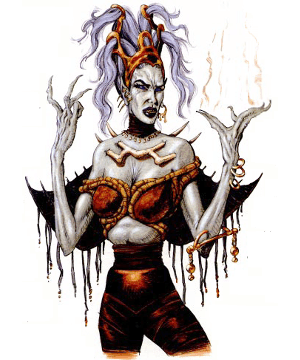
Wezer
Wezers are 6 foot long wasp-like flying insects that make underground hives in the desert tablelands. They are highly social creatures, structured into several distinct classes by both social function and physical characteristics. Water fetcher, worker, and soldier wezers all have wings, multifaceted eyes, and six thin limbs extending from their abdomen. Soldiers are slightly larger than the menials, and are colored a shade of yellow brighter than their fellows. The brood queen is slightly larger with a huge abdomen for laying the hive's eggs.
Wezers build colonies beneath the sands where they protect the brood queen and allow her to lay eggs. From the surface, their hives appear to be a series of domes that vary from three to eight feet tall, but that are all about five feet in diameter. The domes are constructed by the workers, made from sand glued together with a bonding resin they secrete.
Water gatherers fly in the vicinity of the colony in search of water. They either store water directly in wax balls, or they use water to create honey that they store the same way. They hang both types of wax balls in the colony chambers to feed the rest of the adults and to nurture the young. Each sphere contains one gallon of either honey or water. The contents are apparent by the shade of the sphere (water is light, honey is dark).
Wezer queen
Medium beast, unaligned
- Armor Class 15
- Hit Points 33 (5d8+10)
- Speed 15 ft.
STR DEX CON INT WIS CHA 12 (+1) 14 (+2) 14 (+2) 1 (-5) 14 (+2) 6 (-3)
- Senses Passive perception 12
- Challenge 1/2 (100 XP)
Actions
Stinger. Melee Weapon Attack: +4 to hit, reach 5 ft., one target. Hit: 6 (1d6+2) piercing damage and target must make a DC 12 Constitution saving throw or be implanted with an egg that will grow, dealing 1d4 Constitution damage every 24 hours for five days, when it emerges to eat the host. The egg can be surgically removed by a DC 15 Wisdom (Medicine) check using a sharp tool, causing 1d10 piercing damage to the host or 2d10 if the check fails, or a cure disease spell.
Wezer drone
Medium beast, unaligned
- Armor Class 13
- Hit Points 14 (3d8)
- Speed 15 ft., fly 30 ft.
STR DEX CON INT WIS CHA 10 (+0) 14 (+2) 10 (+0) 1 (-5) 10 (+0) 3 (-4)
- Senses Passive perception 10
- Challenge 1/8 (25 XP)
Actions
Stinger. Melee Weapon Attack: +2 to hit, reach 5 ft., one target. Hit: 2 (1d4) piercing damage.
Wezer soldier
Medium beast, unaligned
- Armor Class 13
- Hit Points 14 (3d8)
- Speed 15 ft., fly 30 ft.
STR DEX CON INT WIS CHA 10 (+0) 14 (+2) 10 (+0) 1 (-5) 10 (+0) 3 (-4)
- Senses Passive perception 10
- Challenge 1/4 (50 XP)
Actions
Stinger. Melee Weapon Attack: +4 to hit, reach 5 ft., one target. Hit: 4 (1d4+2) piercing damage plus 4 (1d6) poison damage. The target must make a DC 10 Constitution saving throw for half poison damage. If the poison damage reduces the target to 0 hit points, the target is stable but poisoned for 1 hour, even after regaining hit points, and is paralyzed while poisoned in this way.
Wraith, Athasian
An Athasian wraith is a willing undead, a shadow of the living capable of moving freely between the Gray and Athas. It can possess objects as well as unintelligent creatures such as scorpions, insects, or slimes. Outside its host object, an Athasian wraith is barely visible, appearing only as a gray shade or a mass of churning darkness. Its form resembles its living body, but it can also assume a mist-like appearance. No matter what form a wraith takes, it can always be spotted by its glowing bright purple to blood red eyes.
Wraiths who take corpses as hosts fill out missing flesh such as an arm with their own misty form. Athasian wraiths are capable of communicating verbally with the living and speak the same languages they spoke in life or have learned in undeath. They are free to communicate as they please outside their hosts, but are limited to the capabilities of the hosts they inhabit.
In the Gray, the spirits of the dead slowly dissolve and are absorbed. Wraiths are sustained by a force even more powerful than the Gray – their everlasting faith in a cause greater than themselves. All wraiths need something important from their lives to serve as magnets for their spirits. These items can be candles of faith, like in the Crimson Shrine in Under Tyr, or brilliant gems full of life force, such as the gems used by the Dragon’s wraith knights.
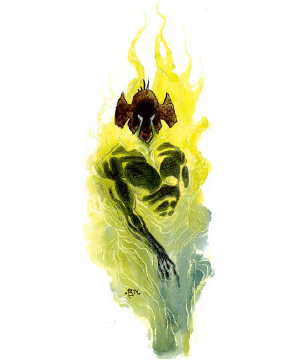
Animated Objects
Use Animated Objects (Monster Manual page 19) or the animate object spell for guidance.
Athasian Wraith
Medium undead, neutral evil
- Armor Class 17
- Hit Points 68 (9d8+27)
- Speed 0 ft., fly 30 ft. (hover)
STR DEX CON INT WIS CHA 6 (-2) 16 (+3) 16 (+3) 12 (+1) 14 (+2) 15 (+2)
- Damage Resistances acid, fire, lightning, thunder; bludgeoning, piercing, and slashing from non-magical weapons
- Damage Immunities cold, necrotic, poison, psychic
- Condition Immunities charmed, exhaustion, grappled, paralyzed, petrified, poisoned, prone, restrained
- Senses darkvision 60 ft., passive perception 12
- Languages the languages it knew in life
- Challenge 8 (3,900 XP)
Incorporeal Movement. The wraith moves through objects and creatures as if difficult terrain and takes 5 (1d10) force damage if it ends its turn in an object.
Curse Magic. Each time the wraith is hit by a magical weapon, the wraith's essence curses the weapon, removing one 'plus,' or if no plus a feature, until a remove curse can be cast to restore all properties.
Actions
Chill Touch. Melee Weapon Attack: +6 to hit, reach 5 ft., one target. Hit: 12 (2d8+3) necrotic damage and the target's Strength score is reduced by 1d4. The target dies if this reduces her Strength to 0. Otherwise, the reduction lasts until the target finishes a short or long rest. Instead of dealing damage, the wraith can instead grapple the target's heart (escape DC 14). While grappling, it can detect thoughts for up to 1 minute with no save possible.
Possession (Recharge 6). One object, corpse, or beast with Intelligence 2 or less that the wraith can see within 5 ft. of it must succeed on a DC 13 Charisma saving throw or be possessed. The wraith controls and animates the target, can't be targeted by any effect except ones that turn undead, and it retains its alignment, Intelligence, Wisdom, Charisma, and immunity to being charmed and frightened. It otherwise uses the possessed target's statistics. The possession lasts until the target drops to 0 hit points, the wraith ends it as a bonus action, or the wraith is turned or forced out by an effect like the dispel evil and good spell. When the possession ends, the wraith reappears in an unoccupied space within 5 ft. of the target.
Yallix
The yallix looks like a cross between a giant dragonfly and a bird of prey. It has a featherered body that tapers into insectoid mandibles and a head with protruding compound eyes. The yallix is a common desert predator that likes to ambush its prey. A yallix is around 3 feet long with a wingspan of 5 feet, weighing 5 to 10 pounds. It is carnivorous and attacks anything that looks like an easy meal.
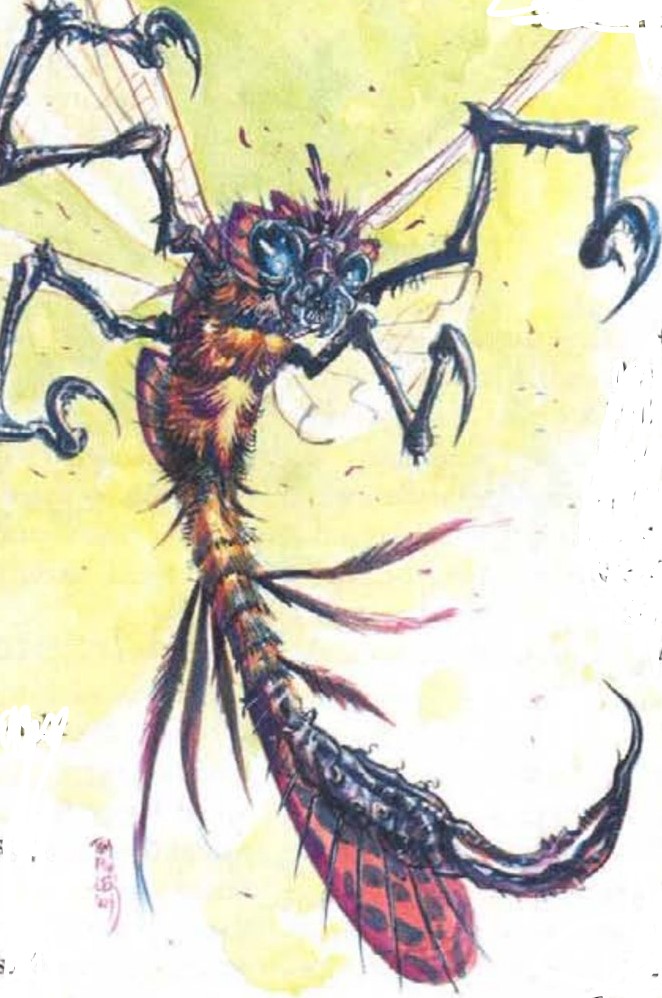
Yallix
Small beast, unaligned
- Armor Class 13
- Hit Points 5 (1d6+2)
- Speed 10 ft., fly 80 ft.
STR DEX CON INT WIS CHA 6 (-2) 15 (+2) 14 (+2) 2 (-4) 14 (+2) 6 (-2)
- Saving Throws Dex +4
- Skills Stealth +8, Perception +8
- Senses passive perception 19
- Challenge 1/8 (25 XP)
Actions
Claws. Melee Weapon Attack: +4 to hit, reach 5 ft., one target. Hit: 4 (1d4+2) slashing damage.
Zhackal
Zhackals are small pack animals that travel about feeding off of the emotions of those about to die. The pack gathers and feeds on the dying victim’s emotions, using psionics to get the victim to give up his hold on life. Zhackals are small brown or gray creatures with thick fur. They are four-legged, have small, very sharp teeth, and eyes of deep blue. A zhackal makes no sound, although it can communicate with others of its kind psionically. Zhackal packs roam any areas except the silt basins and the Sea of Silt. A zhackal pack does not value treasure, leaving a victim’s, valuables alone, though they may feast on the corpse if they are physically hungry. This is rare, for the emotions they feast on seem to satisfy them physically as well as emotionally. A zhackal is 3 feet long and weighs 50 pounds.
Any dying creature is potential food, including other zhackals. Note that zhackals do not feast on members of their own pack, leaving a dying member behind to fend for itself. A zhackal pack may even be found in a city, but they never stay long because, if found, they are almost sure to be hunted down. Certain nobles even keep single zhackals as pets, feeding them from the emotions of dying slaves and gladiators.
Zhackal fur is fairly valuable, but it takes quite a few zhackal skins to make anything that could be sold. In most markets, zhackal fur is worth 100 cp a square yard, but ten unmarked zhackal are needed to produce that much fur. The fur is used in the manufacture of clothing. Such clothing resembles cotton in its ability to “breath” and also wears very well.
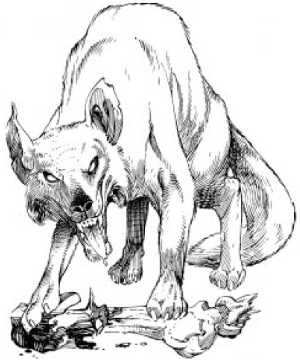
Zhackal
Small beast, unaligned
- Armor Class 12
- Hit Points 6 (1d6+2)
- Speed 40 ft.
STR DEX CON INT WIS CHA 14 (+2) 15 (+2) 15 (+2) 3 (-4) 13 (+1) 15 (+2)
- Skills Stealth +9
- Senses Passive perception 13
- Challenge 1/8 (25 XP)
Actions
Bite. Melee Weapon Attack: +4 to hit, reach 5 ft., one target. Hit: 4 (1d4+2) piercing damage.
Ego Whip (recharge 6). One visible target within 60 ft. must make a DC 10 Intelligence saving throw or take 1d8 psychic damage and be filled with self-doubt, leaving it unable on its next turn to take any action except Dodge, Disengage, or Hide. On a successful saving throw, it takes half as much damage.
Invisibility (recharge 6). The zhackal can use its psionic energy to turn invisible until the end of its next turn, or if it attacks or uses another ability.
Zombie
Wherever the Gray caresses the world, an indelible stain spreads. Darkness bleeds into the land, the sun dims, and the dead rise. Much of Athas has shuddered now and again under the Gray's touch, and the land sprouts a bountiful harvest of zombies. From the underbelly of Tyr to the ruins of Bodach in the Salt Meres to the Dead Land south of Balic, undead horrors aren't the villains of make believe; they are the reality of which Athasians warn their children.
Salt Zombie
The salt zombie is an undead creature born of hate (and possibly a subtle magic of the Great Ivory Plain). Resembling the common zombie, these animated corpses are much more powerful (and even a little more intelligent) than their purely magical brethren. These creatures are formed when a human or demihuman dies of thirst in the Great Ivory Plain.
Unlike common zombies, salt zombies do not look like rotting corpses, but rather resemble a thin and desiccated husk, appearing almost mummified (although not wrapped in strips of linen like a mummy). The eyes of a salt zombie are sunken and shriveled, the limbs are thin and spindly, and the abdomen is desiccated and thin. Their lips are often dry and cracked, but do not bleed. Salt zombies pursue the living with an overwhelming thirst for the water within them.
There appear to be several areas of the Great Ivory Plain where a person who has died of thirst will become a salt zombie. (A person who dies of thirst through hit point loss does not become a salt zombie.) The sheer force of will of an individual refusing to die seems to somehow reanimate their corpse in these peculiar regions. It is unknown what sort of residual magic may linger in these areas to cause such an effect. There is a 5% chance that any person dying of thirst in the Great Ivory Plain will reanimate.
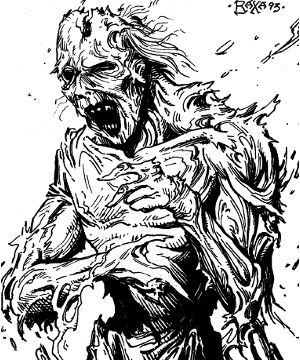
Salt Zombie
Medium undead, chaotic evil
- Armor Class 11
- Hit Points 30 (4d8+12)
- Speed 30 ft.
STR DEX CON INT WIS CHA 13 (+1) 10 (+0) 16 (+3) 6 (-2) 6 (-2) 5 (-3)
- Saving Throws Wis +0
- Damage Resistances cold, bludgeoning, piercing, and slashing from non-magical attacks
- Damage Vulnerability fire
- Condition Immunities charmed, exhaustion, frightened, poison
- Senses darkvision 60 ft., passive perception 8
- Languages understands language it spoke in life but cannot speak
- Challenge 1/2 (100 XP)
Detect Life. The zombie can sense the presence of living creatures within five miles of it.
Undead Fortitude. If damage reduces the zombie to 0 hit points, it must make a Constitution saving throw with a DC of 5 + damage taken, unless the damage is radiant or from a critical hit. On a success, the zombie drops to 1 hit point instead.
Water Vulnerability. A create water spell can be cast directly on the zombie, satiating its thirst and sending it into a torpid state, unable to act, for 1d6 days.
Actions
Claws. Melee Weapon Attack: +3 to hit, reach 5 ft., one target. Hit: 9 (2d6+1) slashing damage and the zombie attaches its mouth to the wound, grappling the target (escape DC 11). While attached, the zombie does not attack but instead at the start of its turns, the target loses 7 (1d6+3) hit points due to blood loss.
Feasting Zombie
Among cannibalistic halflings, diseased inhabitants are buried alive instead of eaten, left to die respectably in the embrace of nature, the giver of life that offers succor in death. But even the far reaches of Athas are not spared from the undead plague. On certain nights, undead halflings walk again in the Forest Ridge, called by flesh. Use the Monster Manual zombie (p316) with size small, Dexterity 10 (+10), and AC 10.
stat blocks by challenge rating
CR 0 (0–10 XP)
Bat, MM318
Brambleweed
Commoner, MM345
Cranium rat, Volo 133
Critic
Giant fire beetle, MM325
Homunculus, MM188
Hurrum
Kip
Jankx
Ock'n
Renk
Scorpion, MM337
Spider, MM337
Z'tal
CR 1/8 (25 XP)
Baazrag
Bandit, MM343
Cultist, MM345
Dew frond (3-6 foot)
Flying snake, MM322
Guard, MM347
Hej-kin warrior
Noble, MM348
Poisonous snake, MM334
Silt runner
Tribal warrior, MM350
Young kruthik, MTF 211
Yallix
Wezer drone
Zhackal
CR 1/4 (50 XP)
Aarakocra, MM12
Acolyte (any), MM342
Apprentice wizard, Volo 209
Beetle, agony
Blossomkiller
Constrictor snake, MM320
Dew frond (9-12 foot)
Flying sword, MM20
Giant bat, MM323
Giant centipede, MM323
Giant poisonous snake, MM327
Gith
Kank drone
Mephit (mud, smoke, steam), MM216-17
Oblex spawn, MTF 217
Rasclinn
Skeleton, MM272
Silt runner, leader
Swarm of bats, MM337
Tari
The Wretched, MTF 233
Wezer soldier
Zombie, MM316
CR 1/2 (100 XP)
Anakore
Belgoi
Dew frond (15 foot)
Erdlu
Firenewt, Volo 142
Floater
Gith, apprentice
Jhakar
Kank soldier
Kluzd
Magmin, MM212
Mephit (dust, ice), MM215
Mephit (magma), MM216
Scout, MM349
Tarek
Tari chieftain
Thug, MM350
Swarm of insects, MM338
Swarm of rot grubs, Volo 208
Wezer queen
Zombie, salt
CR 1 (200 XP)
Animated Armor, MM19
Bog wader
Cactus, hunting
Crodlu
Dagorran
Erdland
Firenewt warlock, Volo 143
Fire snake, MM265
Giant ant lion
Giant spider, MM328
Half ogre (mul), MM238
Hej-kin presever
Hej-kin priest
Jozhal
Meazel, MTF 214
Pterran druid
Pterran psion
Pterran warrior
Silt horror, black
Specter, MM279
Spy, MM349
Ssurran
Stone cursed, MTF 240
Strangling vine
Tarek earth shaman
Thri-kreen, MM288
Yuan-ti pureblood, MM310
CR 2 (450 XP)
Adult kruthik, MTF 212
Ankheg, MM21
Azer, MM22
Baazrag, boneclaw
Bandit captain, MM344
Bard, Volo 211
Berserker, MM344
Cha'thrang
Cult fanatic (any), MM345
Druid, MM346
Ettercap, MM131
Iron Shadow (humanoid) Volo 162
Giant constrictor snake, MM324
Lirr
Ogre (half giant), MM237
Ogre (half giant) bolt launcher, MTF 220
Poisonweed
Priest (any), MM348
Razorwing
Rug of Smothering, MM20
Sand Howler
Ssurran shaman
Swarm of poisonous snakes, MM338
Tarek high shaman
Tarek war leader
Tigone/tagster
Zombie (half giant), MM316
CR 3 (700 XP)
Archer, Volo 310
Basilisk, MM24
Cactus, sand
Cilops
Crodlu, heavy
Dune reaper, drone
Deathlock wight, MTF 129
Flail snail, Volo 144
Fordorran
Giant scorpion, MM327
Gith subleader
Illusionist, Volo 214
Inix
Kirre
Knight (commander), MM347
Martial arts adept, Volo 216
Ogre (half giant) chain brute, MTF 221
Pterrax
Silk wyrm
Slithering tracker, Volo 191
Swashbuckler, Volo 217
Sword wraith warrior, MTF 241
Trapper, Volo 194
Veteran, MM350
Water weird, MM299
Wight, MM300
Yuan-ti malison, MM309
CR 4 (1,100 XP)
B'rohg
Deathlock, MTF 128
Dybbuk (monstrosity), MTF 132
Ettin, MM132
Feylaar
Gith defiler
Helmed horror, MM183
Lamia, MM201
Ogre (half giant) battering ram, MTF 220
Ssurran leader
Stone defender, MTF 126
Tarek tribal chief
Yeth Hound, Volo 201
Yuan-ti mind whisperer, Volo 204
Yuan-ti nightmare speaker, Volo 205
CR 5 (1,800 XP)
Adult oblex, MTF 218
Allip, MTF 116
Bulette, MM34
Enchanter, Volo 213
Elemental (all), MM124-25
Flesh golem, MM169
Gith tribe leader
Gladiator, MM346
Id fiend
Kraken (water) priest, Volo 215
Kruthik hive lord, MTF 212
Master thief,Volo 216
Psurlon
Salamander, MM266
Sand bride
Swarm of cranium rats, Volo 133
Tembo
Tlincalli, Volo 193
Transmuter, Volo 218
Wraith, MM302
Xorn, MM304
Young remorhaz (desert), MM258
Yuan-ti pit master, Volo 206
CR 6 (2,300 XP)
Conjurer, Volo 212
Cyclops, MM45
Dwarf banshee
Galeb duhr, MM139
Invisible stalker, MM192
Klar
Mage, MM347
Sand mother
Thrax
Warlock (Rajaat), Volo 220
Wyvern, MM303
CR 7 (2,900 XP)
Air elemental myrmidon, MTF 202
Dune reaper, warrior
Earth elemental myrmidon, MTF 202
Fire elemental myrmidon, MTF 203
Mekillot
The Lost, MTF 233
Warlock (grey), Volo 219
Water elemental myrmidon, MTF 203
Yuan-ti abomination, MM308
CR 8 (3,900 XP)
Assassin, MM343
Corpse flower, MTF 127
Deathlock mastermind, MTF 129
Diviner, Volo 213
Formorian, MM136
Howler (monstrosity), MTF 210
Mastyrial
Shoosuva (aberration), Volo 137
Silt horror, brown
Sloth, athasian
Sword wraith commander, MTF 241
Wraith, athasian
CR 9 (5,000 XP)
Abjurer, Volo 209
Braxat
Champion, Volo 212
Clay golem, MM168
Evoker, Volo 214
Giant, beasthead
Giant, desert/plains
Giant, shadow
Necromancer, Volo 217
Silt horror, gray
The Lonely, MTF 232
War (earth) priest, Volo 218
CR 10 (5,900 XP)
Elder oblex, MTF 219
Orthon (monstrosity), MTF 169
Stone golem, MM170
CR 11 (7,200 XP)
Balhannoth, MTF 119
Behir, MM25
Dao, MM 143
Djinni, MM144
Efreeti, MM145
Gaj
Marid, MM146
Remorhaz (desert), MM258
Roc, MM260
The Hungry, MTF 232
CR 12 (8,400 XP)
Archdruid, Volo 210
Archmage, MM342
Boneclaw, MTF 121
Eidolon, MTF 194
Silt horror, white
Warlord, Volo 220
Yuan-ti anathema, Volo 262
CR 13 (10,000 XP)
Devourer (undead), Volo 138
Neothelid, Volo 181
The Angry, MTF 231
CR 14 (11,500 XP)
Cadaver collector, MTF 122
CR 15 (13,000 XP)
Cistern fiend
Megapede
Psurlon, giant
Skull lord, MTF 230
So-ut
CR 16 (15,000 XP)
Iron golem, MM170
CR 17 (18,000 XP)
None
CR 18 (20,000 XP)
Cloud ray
Sibriex (abberation), MTF 137
CR 19 (22,000 XP)
CR 20 (25,000 XP)
Nightwalker, MTF 216
CR 21 (33,000 XP)
Lich (kaisharga), MM202
T'liz
CR 22 (41,000 XP)
Zaratan, MTF 201
CR 23 (50,000 XP)
Elder tempest, MTF 200